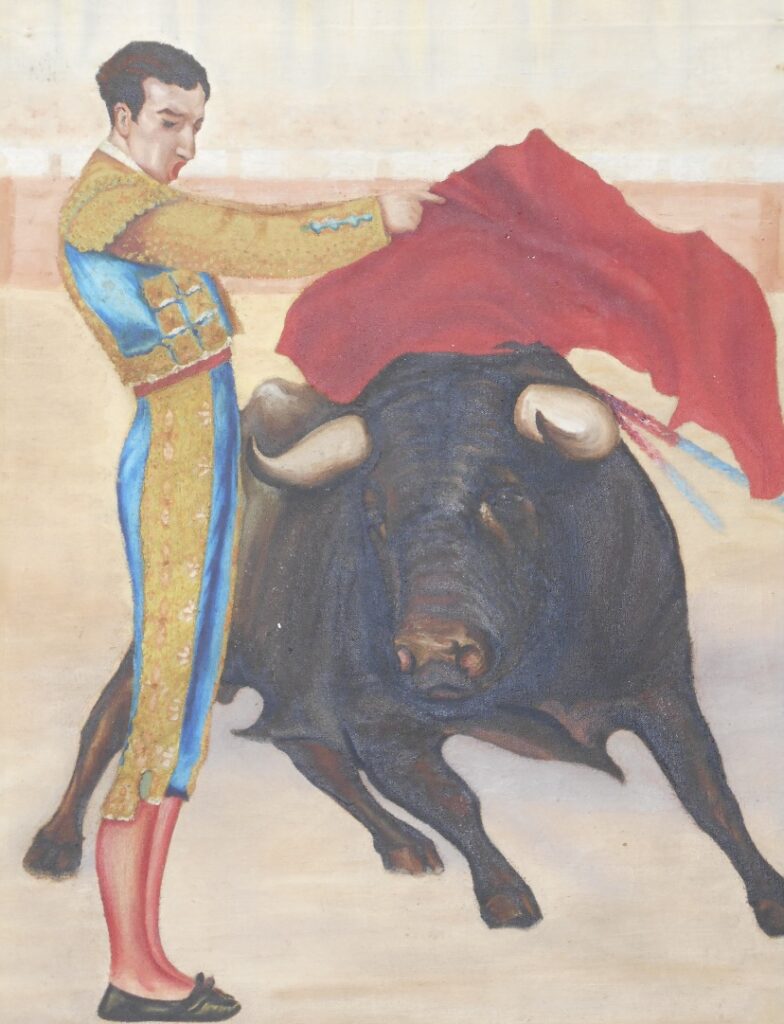My Great Grandfather James Barry joined the Royal Navy in 1859 when he was aged 21, the two documents below details his enlistment & commitment to 10 years service!
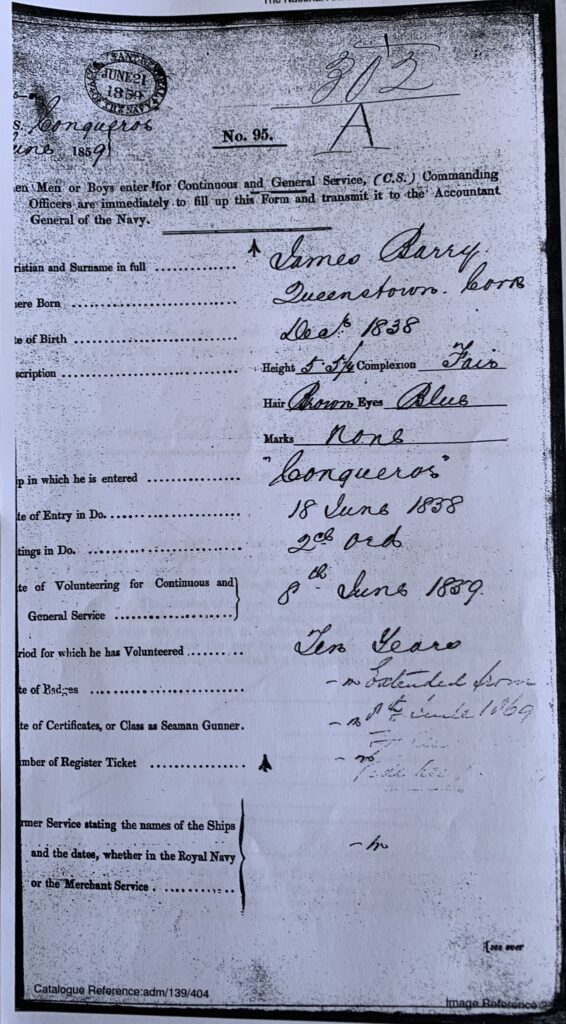
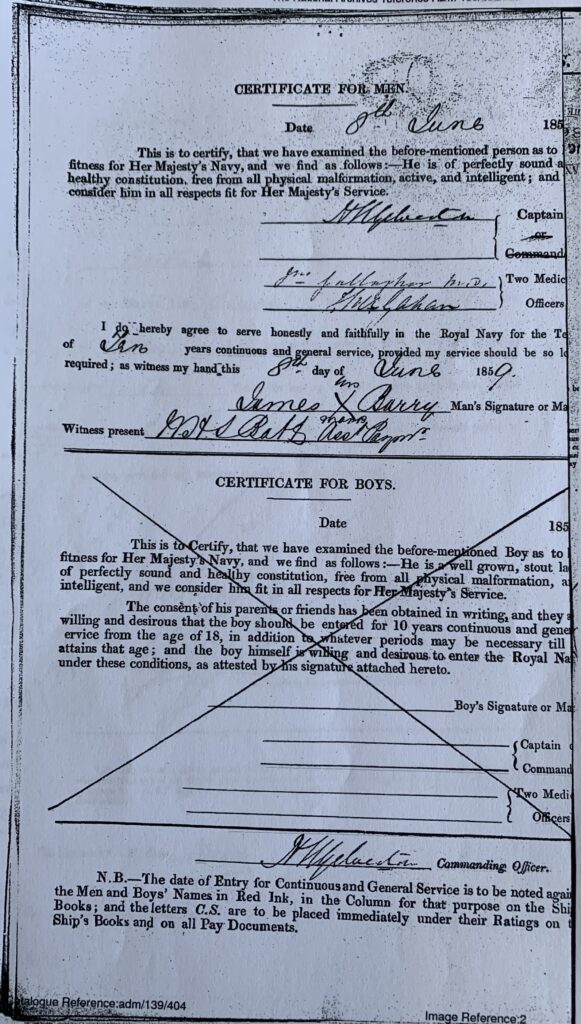
It appears from the Certificate above that at the age of 21, James Barry our Great Grandfather was unable to write! The first ship that he was based on as an Ordinary Seaman was HMS Conqueror, a 120 Gun Caledonia-Class first rate ship of the line that had a crew of around 900 men. James serves on HMS Conqueror for 5 months. On the 8th December 1859 James moves to serve on HMS Amphion a 36 Gun Frigate, but he is only on board the Amphion for barely 2 months before he goes back to the Conqueror on 3rd February 1860, he then stays on board the Conqueror for just over 2 years until 21st March 1862. He then stays with HMS Conqueror for just over 2 years until 21st March 1862 when he becomes an Able Seaman & attains his first Good Conduct Stripe.

The National Census was held on April 7th 1861 and James Barry is on board the ship he was serving on, HMS Conqueror, on this day the ship is docked at Hamoaze, Devonport, Cornwall.
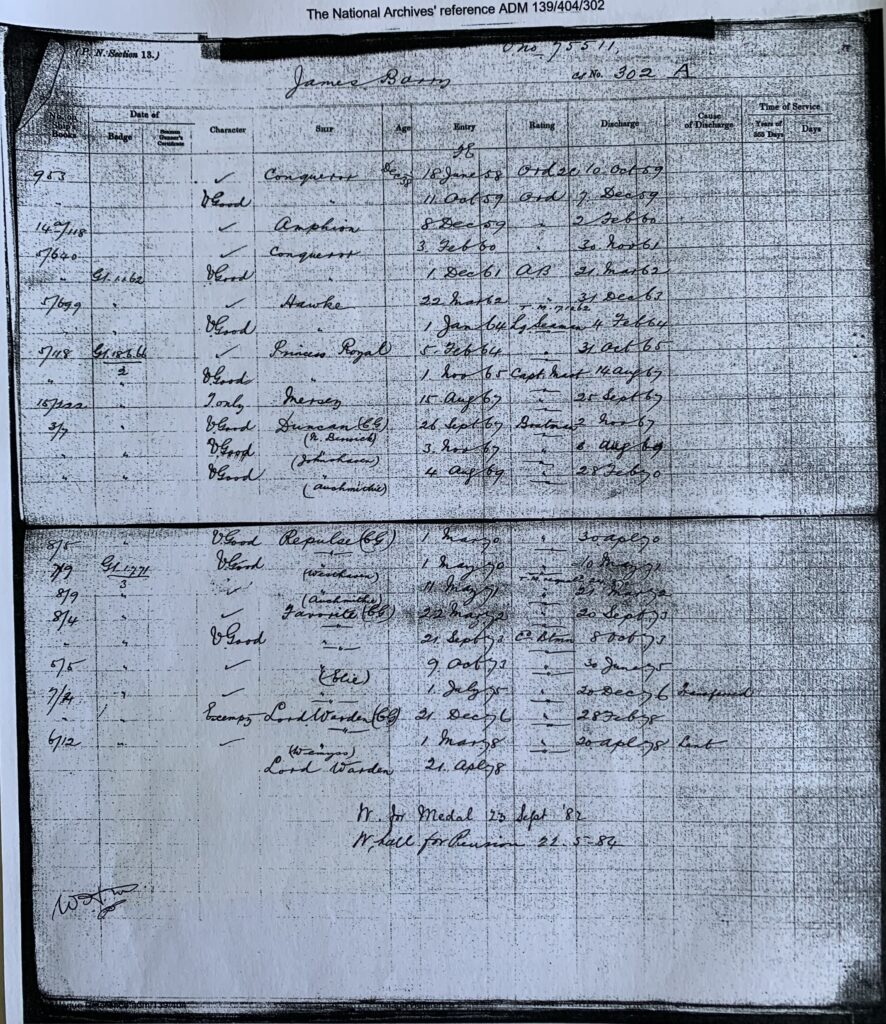
The document above lists some of our Gt Grandfather’s Royal Navy service records, including the ships he served on including his transfer to H M Coastguard, Medal and Pension. More of his Naval Record documents will follow on.
On the 22nd March 1862 James Barry transferred to HMS Hawke, a 74 Gun, Black Prince class, ship of the line, he was to stay with this ship until the 4th February 1864. In 1864 he was promoted to Leading Seaman. There is a reference on his record which are the initials T.M. this may mean Trained man (TM 17.10.62) After this it appears that James Barry travelled half way round the world! He was posted to HMS Princess Royal on the 5th February 1864. This ship was a steam line full-rigged 91 gun battle ship. In 1865 the Princess Royal conveyed Sir Harry Smith Parkes to the treaty port of Yokohama on his appointment as envoy to Japan, while James Barry was still serving on her as a Leading Seaman. However at some stage between 1st November 1865 & 14th August 1867, and despite James character being recorded as V. Good, he was recorded as being called to the “Captains Mast”. This was a way of dealing with a relatively informal and low level forum for handling a minor misconduct. Reading between the lines this “minor misconduct” or whatever James was called to the “Captains Mast” must have been insignificant as he was awarded his Second Good Conduct Stripe on 18.6.1866 while still serving on HMS Princess Royal.
Just before James Barry was married in 1867 he transferred to HMS Mersey on the 15th August 1867. HMS Mersey was one of two “Long Frigates” built in 1858 & was also described as a Training Ship. His last Character reference on HMS Mersey appears as a drop to “Good” only.
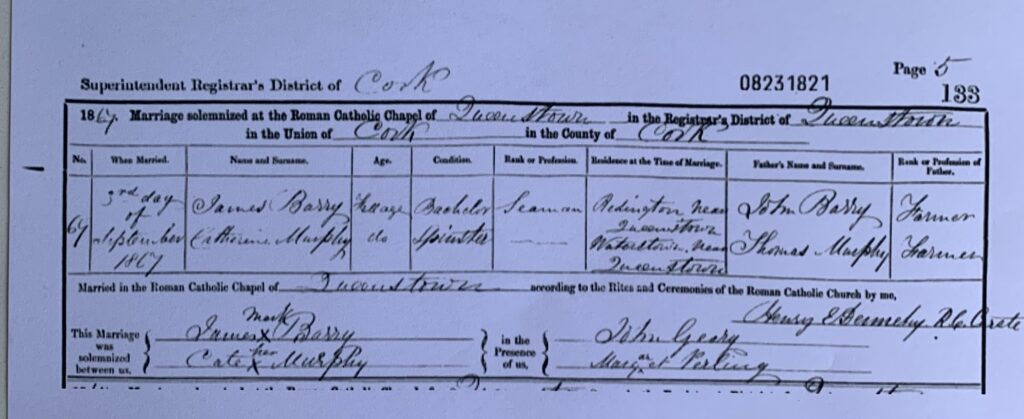
The Marriage Certificate above gives us some information about our Barry Ancestors. John Barry our Great, Great Grandfather was a farmer in the Queenstown area of Cork now Cobh. He and his family lived in Redington, an area within Queenstown. John Barry was born c 1818 Ireland. His son, my Great, Grandfather, James Barry (born 1838 Ireland) married Catherine Murphy (b1845 Ireland) on 3rd September 1867 in Queenstown, Ireland. They were married in the Roman Catholic Chapel of The Sacred Heart. My Great, Grandfather James Barry’s profession at the time of his marriage was Seaman with the Royal Navy. At the time of his marriage he was based on the ship HMS Mersey and very soon after he was married he moved to HMS Duncan, a 101 gun screw two decker of the “Duncan” class. His Character then returned to V. Good.
From 3rd November 1867 to the 6th August 1869 James was still on, or “borne on the books of the District Ship” Duncan off the Scottish Coast. He may have been shore based for some of this time at the North Berwick Coast Guard Station.
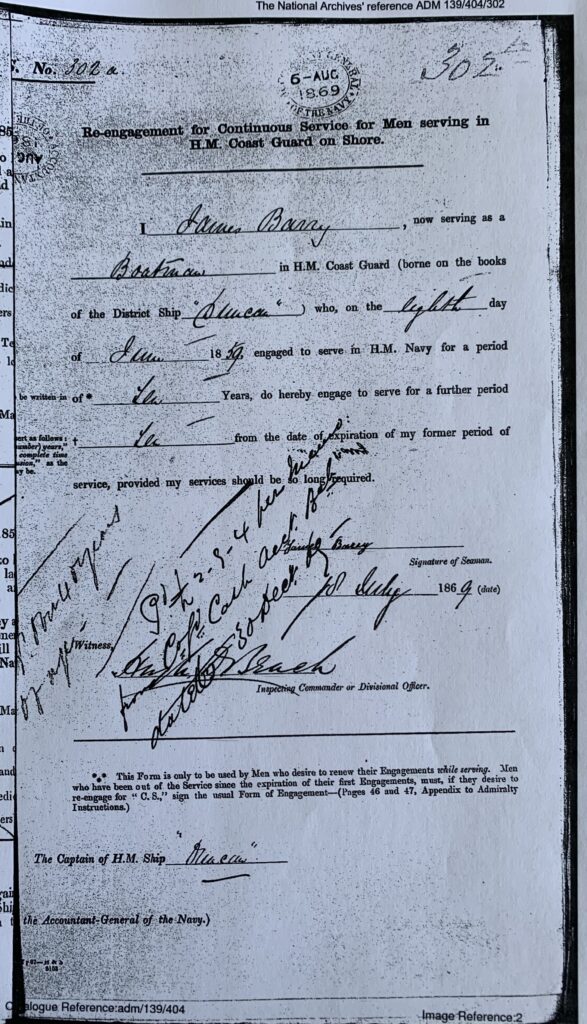
It appears that while he was earning his second Good Conduct Stripe on board HMS Duncan, and while this ship was based in North Berwick, Scotland he was promoted to Boatman during 1867.
At the age of 31 & 2 years after he was married, our Gt Grandfather James Barry had served in the Royal Navy for 10 years (this was what he had signed up for in 1859) For whatever reason on the 6th August 1869 he now signed up as a Boatman to HM Coastguard for a further 10 years as the Document above shows. Between August 1869 & February 1870 James was based at 2 Coast Guard Stations in Scotland, Johnshaven and Auchmithie.
We are not entirely sure where James & Catherine were living when their first child was born, but what we do know from James Coast Guard record, is that he was based at Auchmithie Coast Guard station between 1869 & 1870, Auchmithie is about 4 miles away from Arbroath where their daughter Mary was born in 1870. Johnshaven was about 22 miles from Arbroath
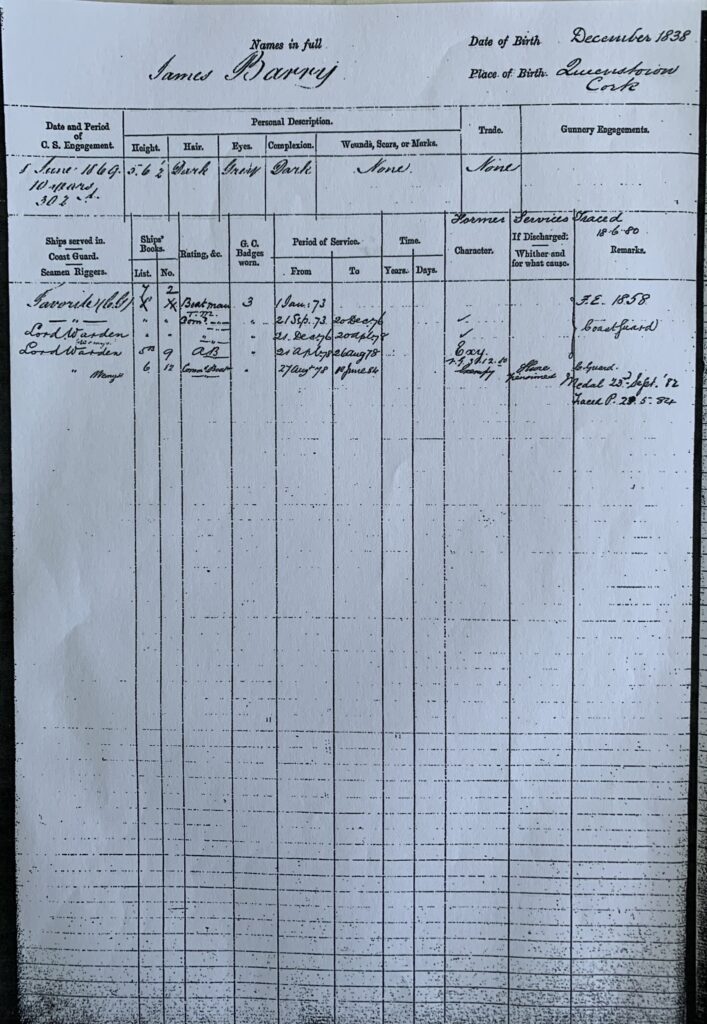
The document above is the Coast Guard Service Record of our Great Grandfather James Barry when he transferred his service from the Royal Navy.
From 1st March 1870 to the 10th May 1871 James Barry (Coast Guard) was assigned and or aboard HMS Repulse a 90 gun second rate ship of the line, she was a Guardship based at Queensferry Edinburgh at this time. Most major ports throughout the UK at this time had a stationary guard ship that could be ready for action at sea in a matter of hours or days in case of war. By the end of 1871 James had earned his 3rd Good Conduct Stripe.
It appears that from the 11th May 1871 until 21st March 1872 James Barry Boatman, with the Coast Guard, was shore-based at the Westhaven Station, this posting was about 14 miles from Forfar where his second daughter Hannah was born in 1872. From 22nd March 1872 until the 30th June 1875 James was again shore-based, and for 3 years and 3 months, he was stationed at Auschmithie. His daughter Kate was born in 1874 at Elie about 44 miles from Ausmithie. James was also assigned to HMS Favourite a wooden warship converted to a broadside iron clad, with 10 canons. She was also the First Reserve Guardship on the East Coast of Scotland during this period of time. James was also awarded his 4th and final Good Conduct Stripe during this time, all sailors were only allowed a maximum of 4 Good Conduct Stripes with a Good Conduct Badge.
At some stage James & Catherine moved into 17 South Street Leven, near Elie on the East Coast of Scotland. James was based at the Elie Coastguard Station as a Commissioned Boatman from 1st July 1875 to the 20th December 1876. James & Catherine’s first Son John was born in Elie in 1876, John went on to join the Merchant Navy as an Engineer.
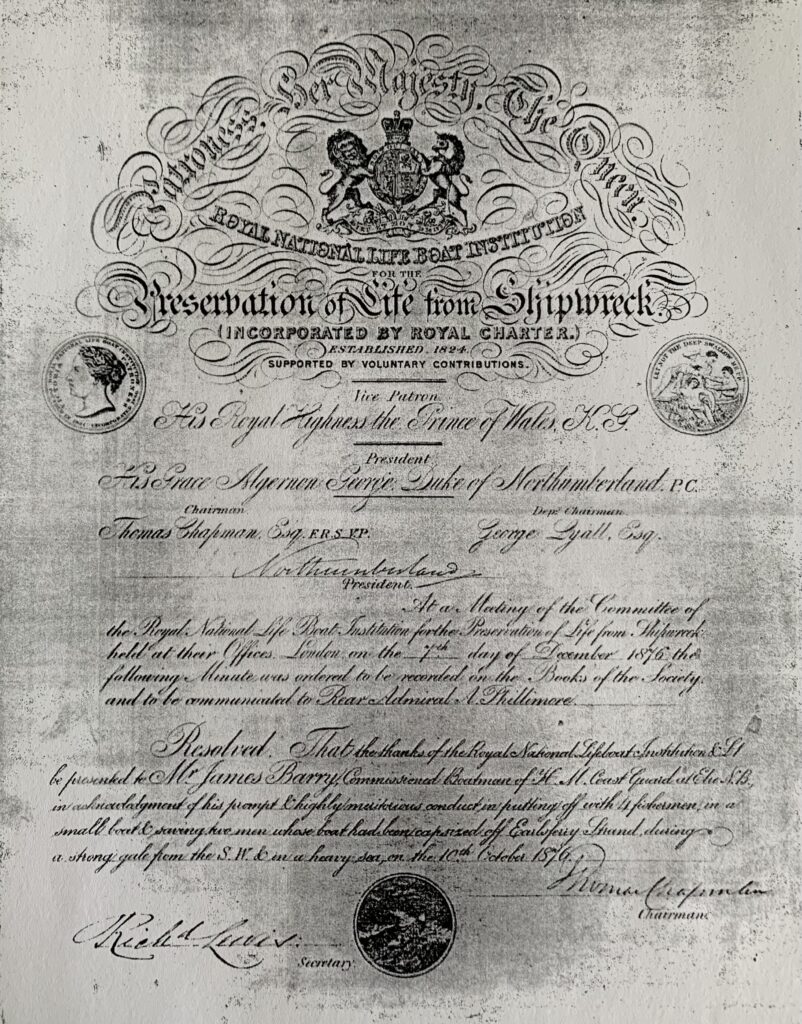
Soon after the 7th of December 1876 James Barry our Great Grandfather received an award for Meritorious Conduct, this consisted of a Certificate (shown above) and the sum of £1 from the Royal National Lifeboat Institution. This award was given to James for his services and conduct in saving lives off the coast of Fife in Scotland on the 10th October 1876. The sum of £1 would have equated to about 2 weeks’ wages for James.
The resolution reads:
“At a meeting of the Committee of the Royal National Life Boat Institution for the Preservation of Life from Shipwreck held at their Offices London on the 7th day of December 1876 the following Minute was ordered to be recorded on the Books of the Society and to be communicated to Rear Admiral A Phillimore.
Resolved. That the thanks of the Royal National Lifeboat Institution & 1£ be presented to Mr James Barry, Commissioned Boatman of H.M. Coast Guard at Elie
N.B., in acknowledgement of his prompt & highly meritorious conduct in putting off with 4 fisherman in a small boat & saving five men whose boat had been capsized off Earlsferry Strand during a strong gale from the S.W. & in a heavy sea, on the 10th October 1876.
Signed Thomas Chapman (Chairman)
It appears that James was based at the Elie Coast Guard Station until the 20th December 1876, and then according to one of his record sheets he was assigned to HMS Lord Warden, a Lord Clyde class Armoured Frigate, at this time she was the first reserve Guard Ship based in the Firth of Forth. James was also shore based at Wemyss a shore-based Station until 21st April 1878. His last and best character reference whilst in service was Exemplary.
Patrick Barry our Grandfather was born in the town of Leven near Elie at 17 South Street on 2nd March 1880. A copy of his birth Certificate is shown below.
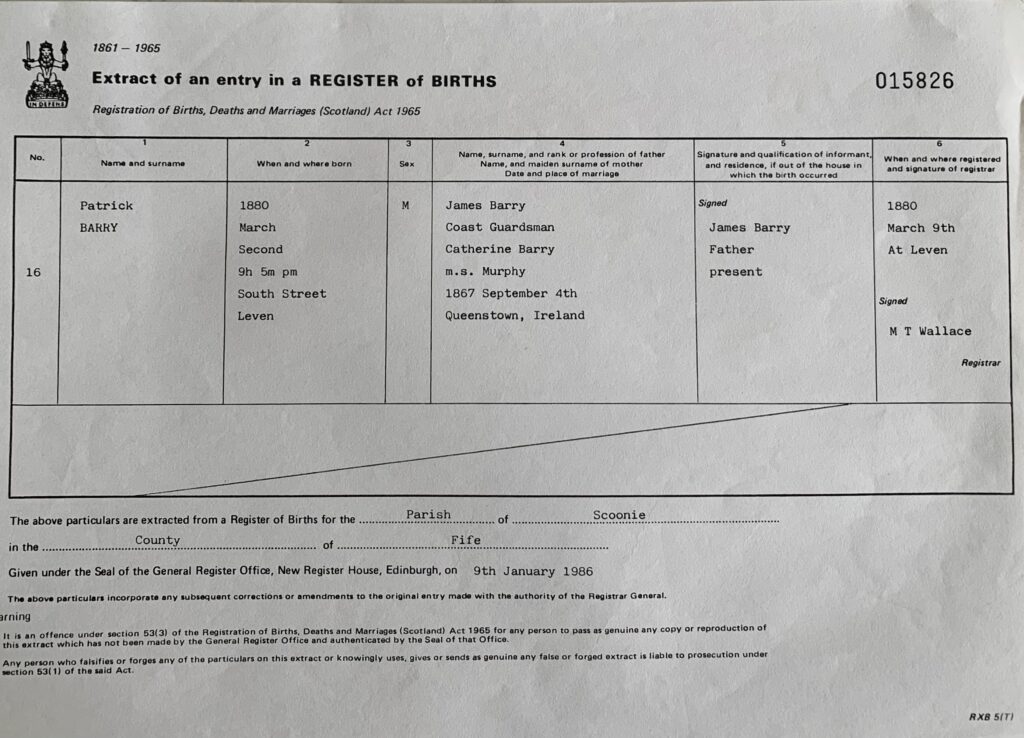
According to James Barry’s Coastguard record the last Ship he served on was HMS Lord Warden (Guardship) and the last shore based Coastguard station that he served on was Wemyss on the East Coast of Scotland. At the age of 46 and after 25 years of service he retired from the Royal Navy & Coastguard service with the rank of Commissioned Boatman in 1884.
His records also show that he was entitled & eligble to a Long Service/ Good Conduct Medal, a picture of which appears below.

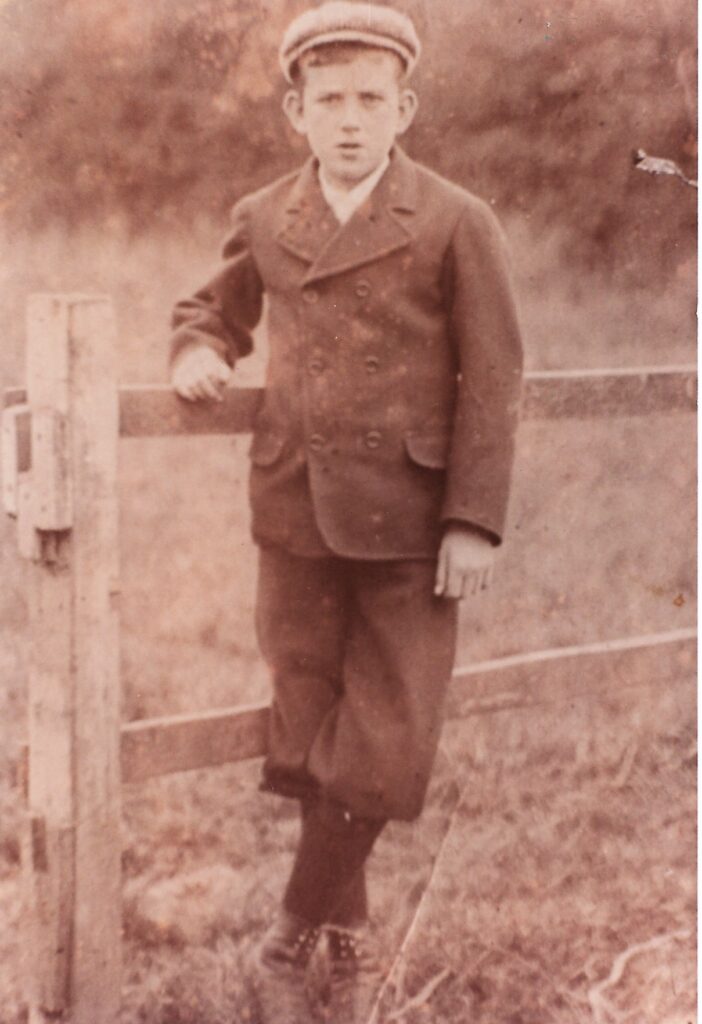
The Print out below is a copy of the original emunerator’s record of the 1901 Census giving details of our Great Grandfather James Barry & his family.

The Screen Shot below is a more detailed record of the 1901 Irish Census, details of which are readily available from The National Archives of Ireland.
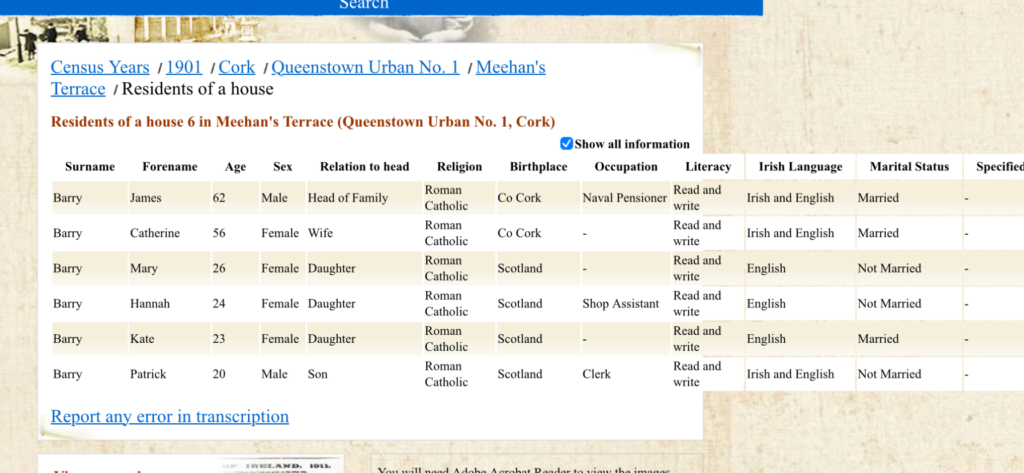
Meehan’s Terrace, Queenstown, Cork where the Barry Family are living in 1901 is situated close to the coast, this must have been home from home for them, as they had all lived and worked by the coast in Scotland for many years, before they moved back to Ireland. The details of the Barry family listed above speak for themselves. It is interesting to note that our Great Grandfather James was retired and now at the age of 62 he could read and write whereas at the age of 21 he could not write! His son Patrick our Grandfather is probably now at the age of 20, working as a Clerk in the nearby Royal Naval Dockyard of Haulbowline. His brother John, aged 25 was not at home on Census night in 1901. He seemed to be following a family tradition and had joined the Merchant Navy as an Engineer, it is possible that he was at sea working.

The copied entry above is from civilrecords.irishgenealogy.ie and is in turn from the Superintendent Registrars District of Cork. This record shows that our Great Grandmother Catherine Barry, nee Murphy died on the 7th January 1906 from Cerebral Haemorrhage. Her age at death was 60, however as with several of our relations we can not be sure if this is accurate.
The next Census in Ireland took place in April 1911. The Barry family have now moved, their address is now 4 Hawthorn Terrace, Queenstown, Cork.

The Screen Shot below is a more detailed record of the 1911 Irish Census, details of which are readily available from The National Archives of Ireland.

Between 1901 and 1911 the Barry family had moved again, not far, only about a 12 minute walk and still with a view of the sea, 4 Hawthorn Terrace, Queenstown. James’s status on the 1911 Census is Widower. His wife Catherine Barry, nee Murphy died on the 7th January 1906 from Cerebral Haemorrhage. It appears that there are some transcription errors on these forms, James Barry is listed as a “Pensioner RA, it should read “Pensioner RN”. Patrick Barry is listed as a “Bookyard Clerk” and it should read “Dockyard Clerk” !
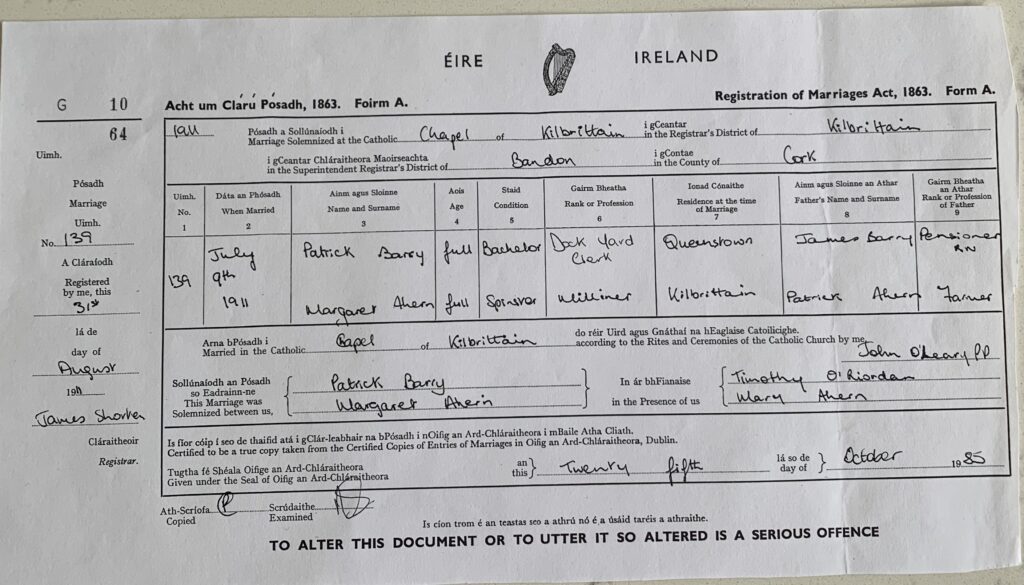
The Marriage Certificate copy above is self explanatory. It does confirm that our Grandfather Patrick Barry was a Dockyard Clerk! It also tells us that our Grandmother Margaret Ahern (Peg) was a Milliner ( Hat Maker). We can surmise that as Patrick lived in Hawthorn Terrace and Margaret lived in Harbour Row, and the distance between both roads was only about a 7 minute walk, their paths probably crossed as they went about their daily tasks, and the rest is history.
The document below is a passenger list from the S.S.Mooltan, a ship belonging to the Peninsular & Oriental Steam Navigation Company, the Mooltan departed from London for Hong Kong on the 14th July, 1911, 5 days after Patrick Barry married Margaret Ahern (Peg). Not much of a Honeymoon when you think that Patrick then had to travel from Cork to London within a day or so of his wedding! There is no mention of Mrs Barry on this passenger list. What we do know is that Patrick had secured, or was posted overseas to the Naval Dockyard in Hong Kong and would be working as a Clerk to the Chief Constructors Office in the Royal Naval Dockyard.
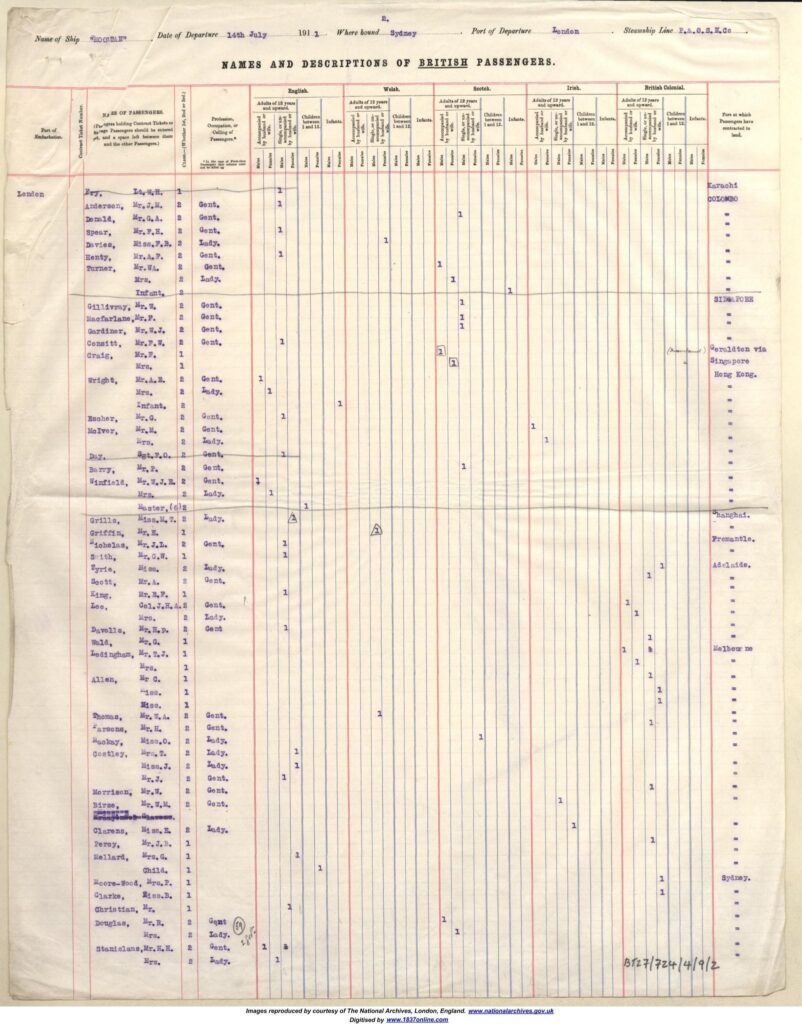
For some reason Patricks wife Margaret (Peg) did not travel with him to Hong Kong on the 14th July 1911. We have been unable so far to trace a record of any Passenger List that contains her name, and it is not for want of trying. We do know that she eventually arrived in Hong Kong but do not as yet have a date. We do have a rough indication of when she arrived as Patrick was receiving correspondence from Father W F Browne in Queenstown who mentions the following in a letter dated April 9th 1912 I suppose Mrs Barry must be out with you now. I hope you are both very happy & that it will not be long before we see you home well and strong in the old Country once more. Very sincerely yours. W F Browne
A copy of this letter is featured below.

There was a letter from Fr W F Bourne, to Patrick Barry our Grandfather,that preceeded the letter above. Acopy of which is below this paragraph. This letter is dated Wednesday September 20th. 1911. I include it here as it possibly gives us an insight into the lives of this Priest, Patrick and I think our Great Grandfather James Barry, I think Fr Bourne describes James in the letter as follows, ” On Saturday morning past as the bell was ringing for the 8.00 Mass I met just at the corner opposite the new convent a stalwart figure sturdily stumping along with the aid of the stout stick to Mass. Of course I had to enquire whether there was any news yet from Hong Kong and whether a certain young gentleman of my acquaintance had yet developed into “a heathen Chinee”. Such a possibility was indignantly denied so I demanded your address to send you as I promised I would, a line. – James Barry would have been aged 75 going on 76 in 1911. As far as we know our Great Grandfather James Barry died in 1913 at the age of 77.
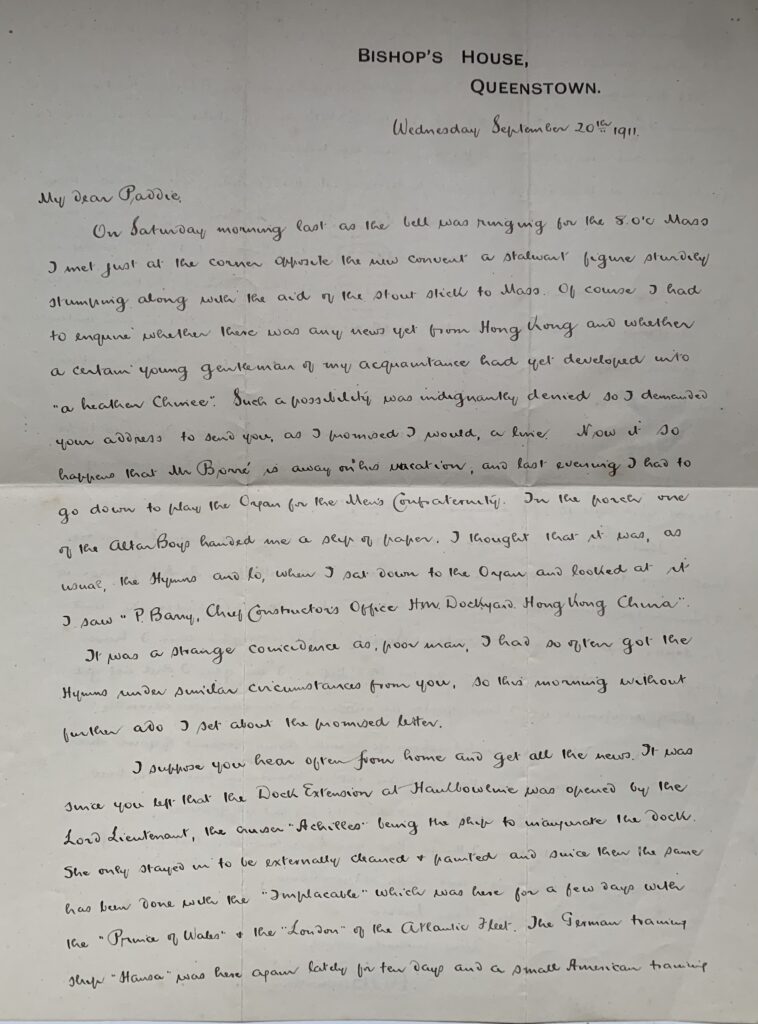
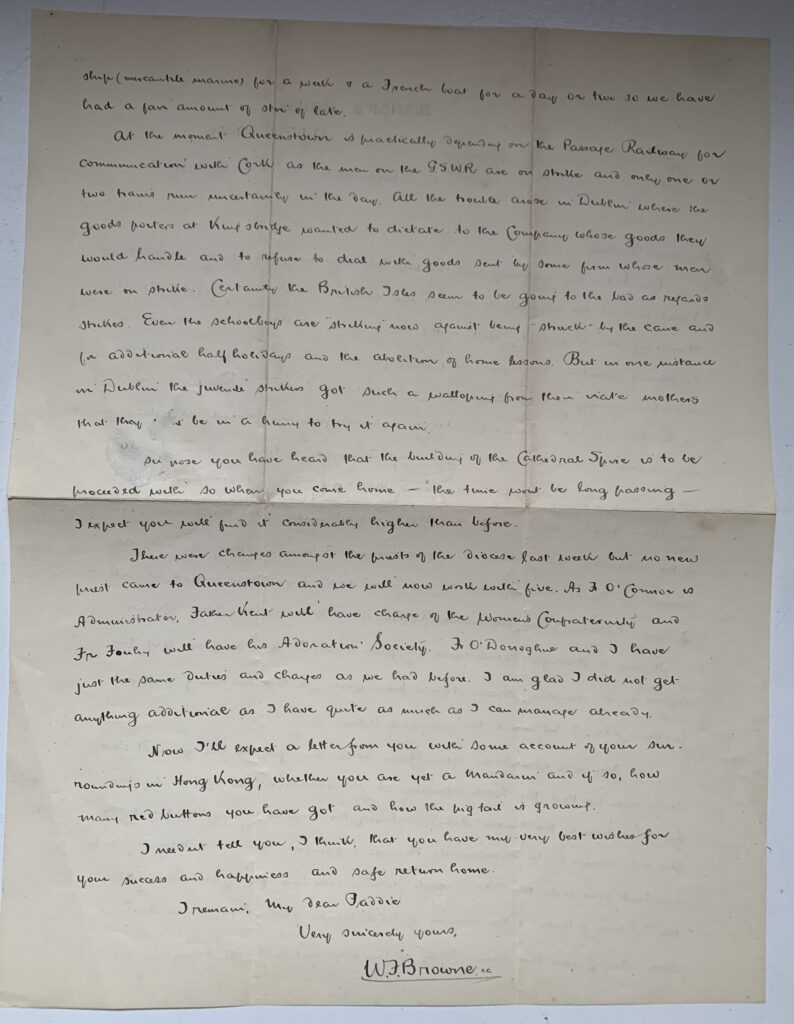
The following pictures were taken in Hong Kong, probably, before our Father, James Patrick Barry, was born on the 13th January 1913 in Hong Kong.

The top Left photo is as follows. Woman in background looking out of window is Patrick Barry’s wife Margaret Barry (nee Peg Ahern) Seated man on Left is John Barry, Patrick’s brother, a Merchant Navy Engineer. Patrick Barry is seated on the Left in this photo.
The other 3 images are of Patrick Barry in White Tropical Uniform, Hong Kong c 1914.
I was always led to believe that our Grandfather Patrick Barry was a member of the Hong Kong Volunteers. This was a home grown Hong Kong defence/militia force organised along British Army lines. This local volunteer force allowed regular units to be deployed elsewhere during World War 1.
However…….A similar force titled the Hong Kong Police Reserve/Auxiliaries force was formed around 1914 to help maintain law and order. Their primary role was to assist in replacing Police Officers who had returned to Europe to fight in the Great War.
There is very little information or detail about the precise uniform that the two organisations wore through these troubled times. What little information there is regarding their specific uniforms descriptions matches the photo of Patrick Barry above. If our assumptions are correct about Patrick’s service in any of the above mentioned Forces, then he was probably eligible for the 2 Medals pictured below!
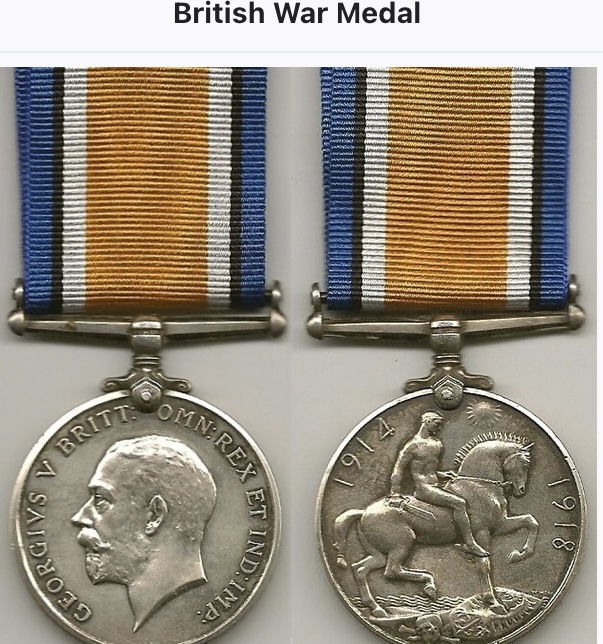
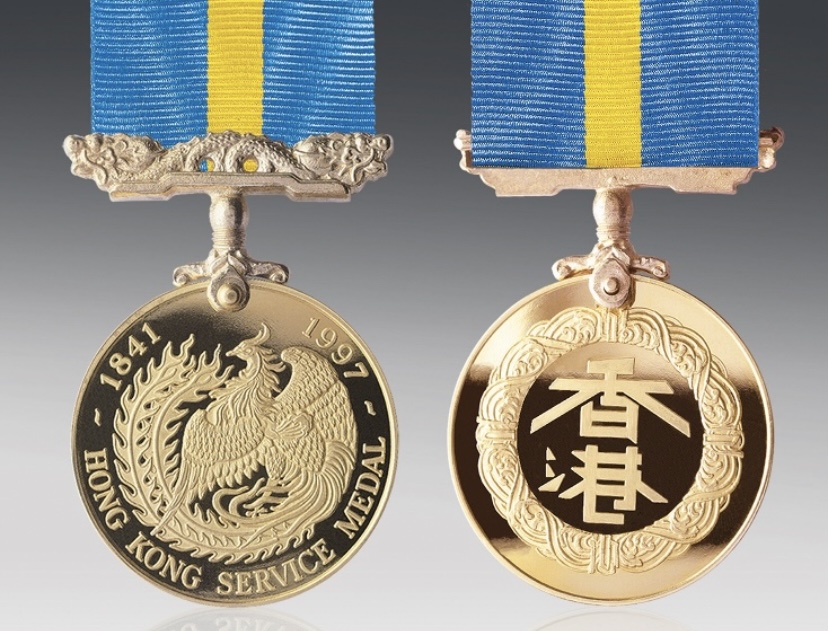
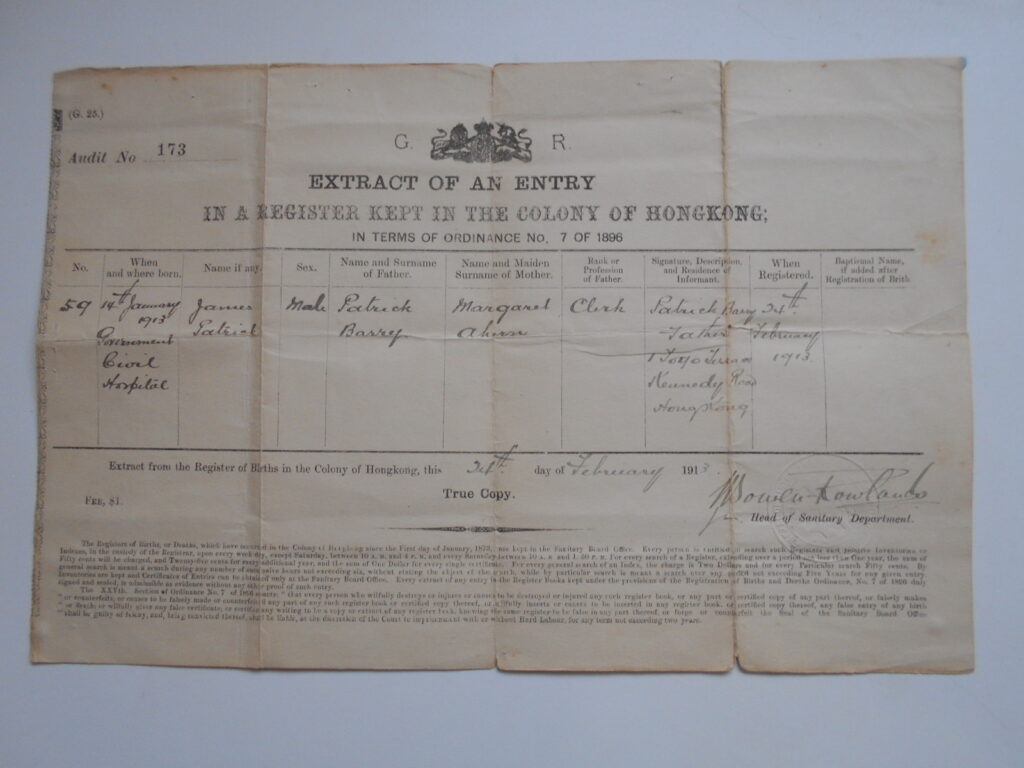
Patrick & Margaret’s first child was born in Hong Kong on the 14th January 1913. It always amused Dad that his Birth Certificate was signed off by the “Head of the Sanitary Department” I believe that Dad was named James, after his Grandfather James Barry, and his middle name was from his other Grandfather Patrick Ahern.

Patrick & Peg, proud parents of James Barry, soon to be Baby Jimmy Barry, Patrick Ahern’s (Peg’s father) first Grand child known as Jimmy.
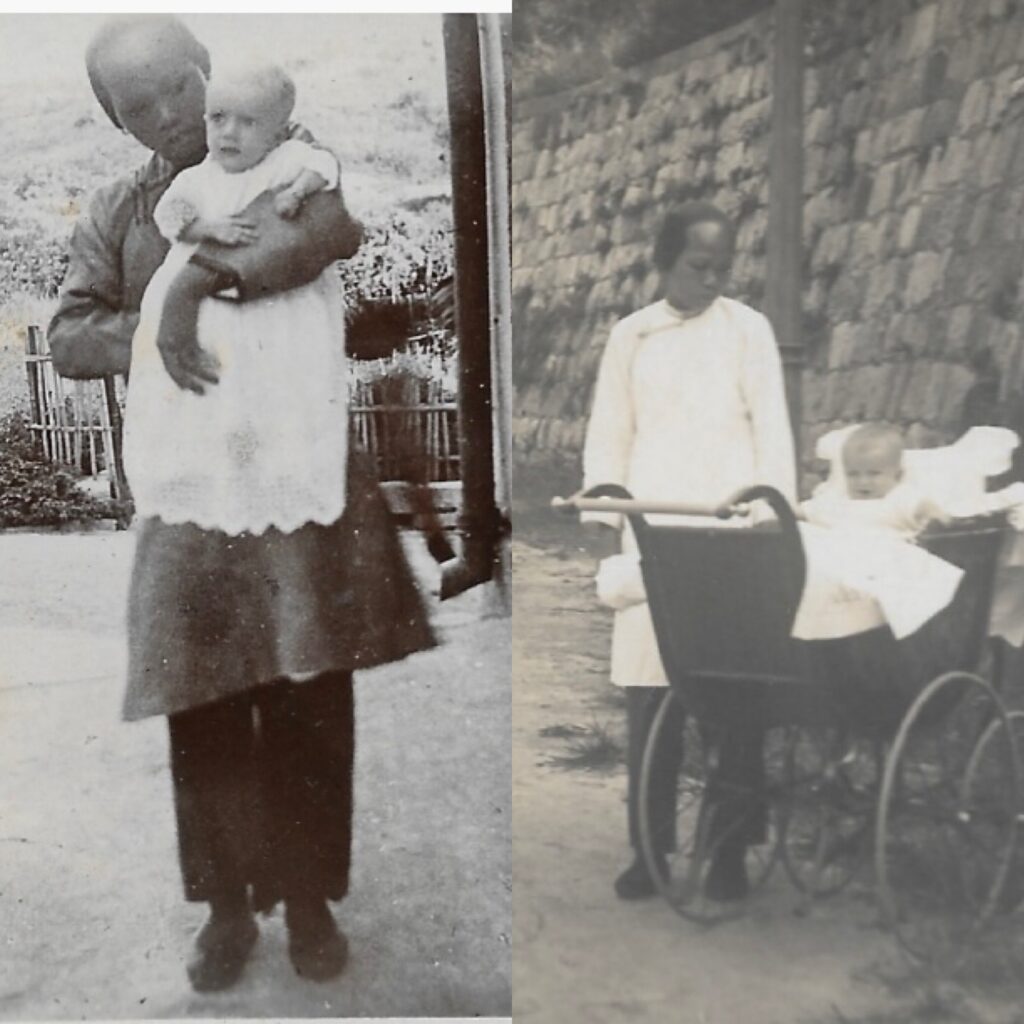

In Hong Kong, Patrick & Peg had the benefit of employing an “Amah”, essentially a woman to provide child care and other domestic duties.
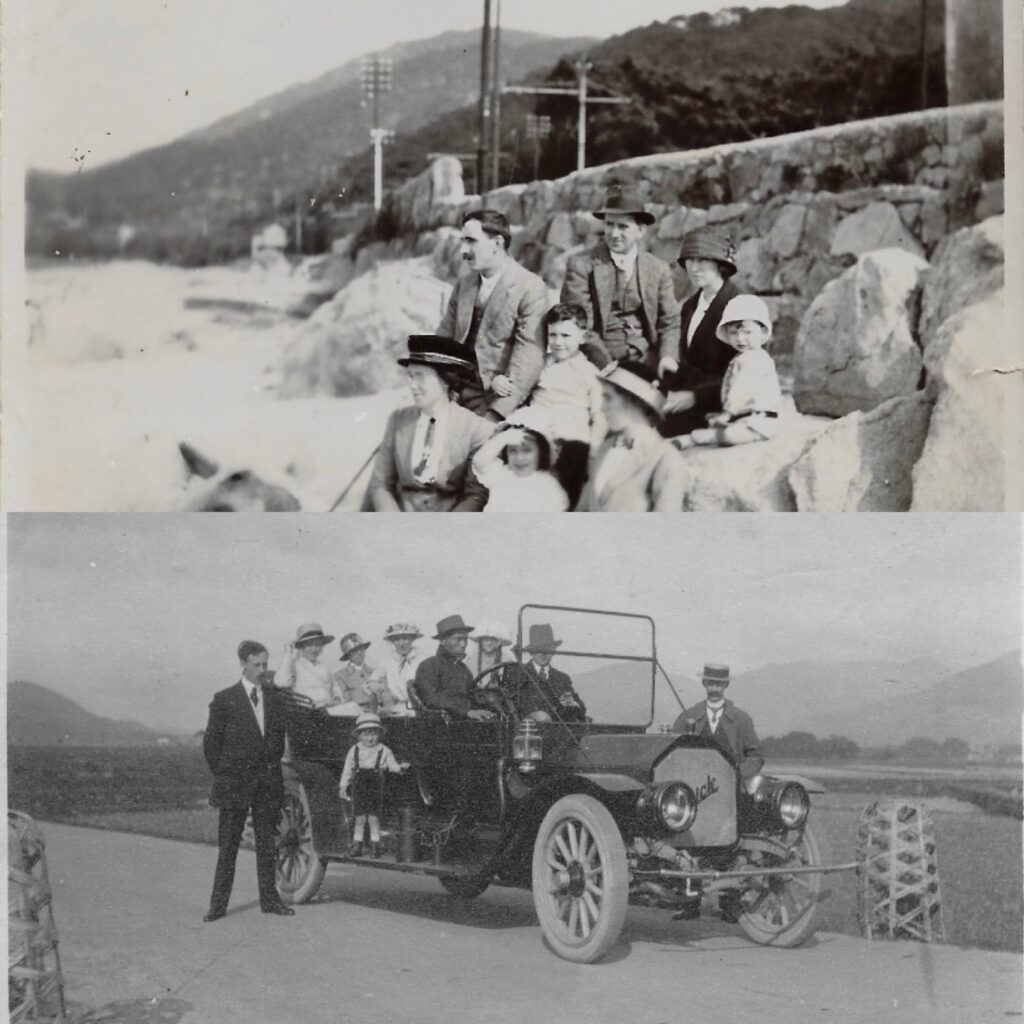
The 2 photos above were both taken in Hong Kong. The top photo was probably taken in 1914. Not sure who the family group is in the foreground? But the family of 3 in the far right back of the photo all wearing hats are Patrick, Peg and their Son Jimmy Barry.
The lower photo shows my Father as a very small boy of about 2/3 years of age wearing a pair of shorts and a straw hat standing on the running board of a Buick motor car, it looks like a Model 40, five passenger tourer of c1913. There was possibly another car just out of shot as there are 9 people in the picture, all 9 would have been a bit of a tight squeeze even in this Buick Tourer. If it was a 1913 model 40, it would have cost $1,659.00 new, and was equipped with a four cylinder engine rated at 40 horsepower, with three forward speeds and a reverse.
Apart from the obviously Oriental driver, our Grandfather and Grandmother are in the picture and possibly our Grandfathers older brother John ( Merchant Navy Engineer) and his wife. That still leaves two women and a man who I cannot identify or name.
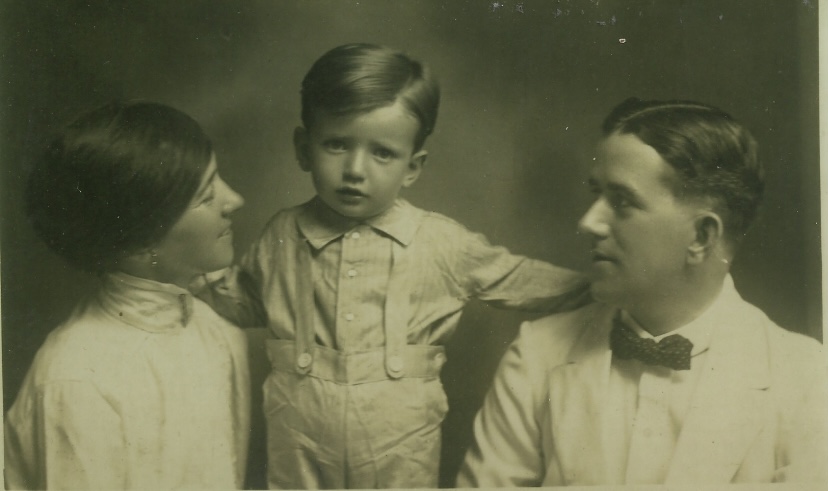
I think the photo above may have been a Portrait shot prior to Peg & Jimmy travelling to Ireland from Hong Kong in 1916 when our father would have been about 2/3 years old. We have no Idea why Peg & Jimmy traveled back to Ireland in 1916 leaving Patrick behind, but he did rejoin his wife and son when he travelled back from Hong Kong in 1918. The passenger list below shows that Peg & her son James arrived in the Port of London on the 2nd June 1916, their departure date from China is not recorded.
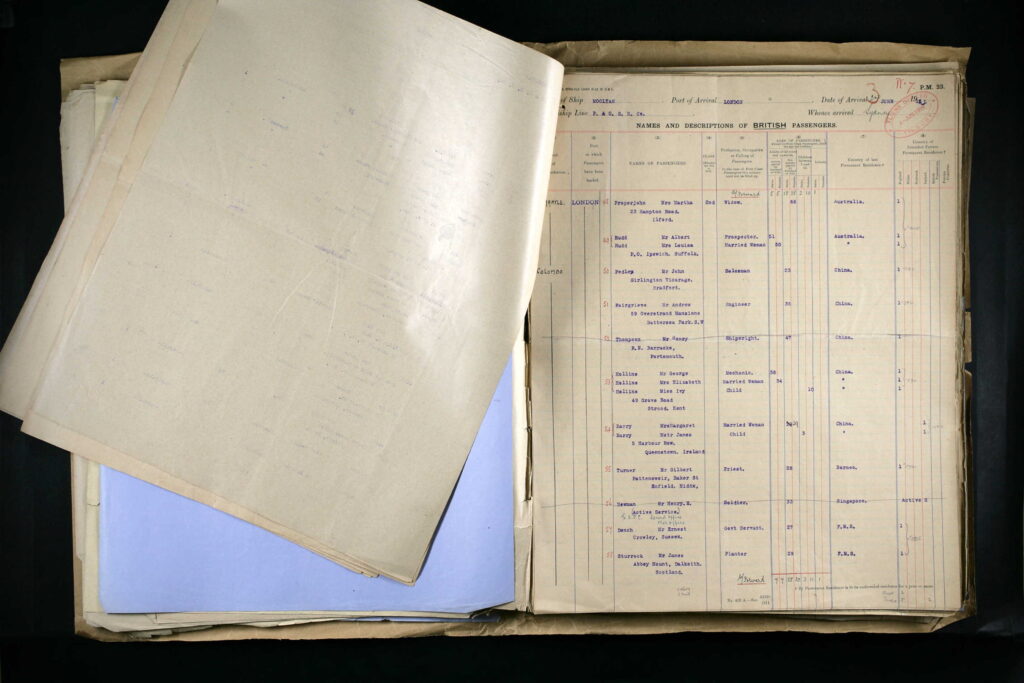
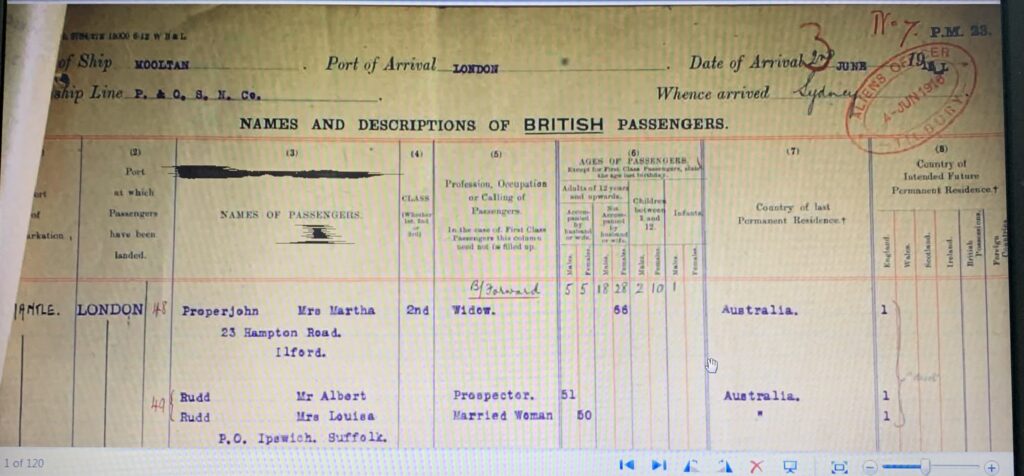
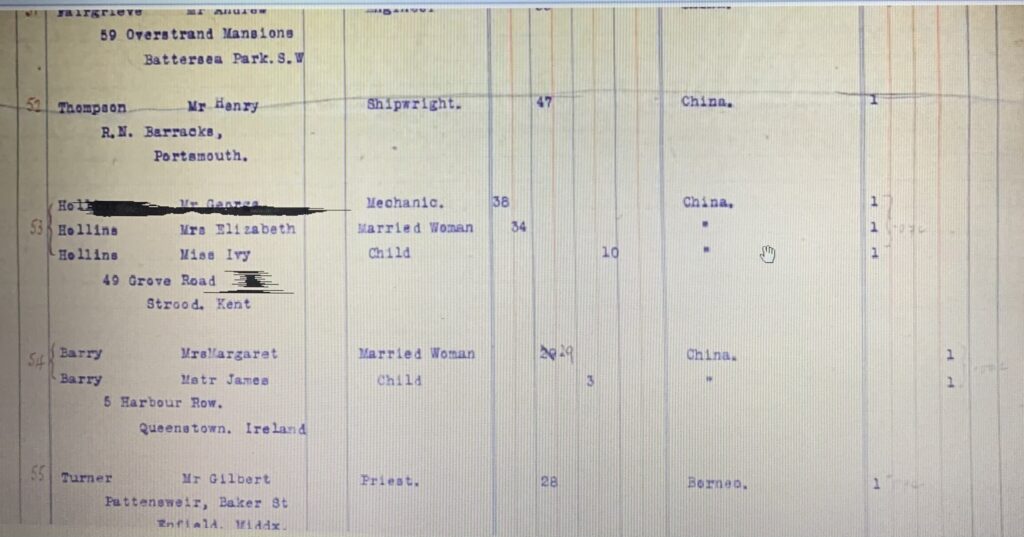
The Passenger list as 1 doc did not reproduce very well, so, 2 zoomed-in reproductions are shown above. The ship that Peg & James sailed back to Europe was exactly the same ship (The SS Mooltan) that Patrick Barry sailed to Hong Kong in, July 1911. Peg & Jame’s given address on their return to Europe, was 5 Harbour Row, Queenstown, Ireland, where she lived and worked prior to her marriage to Patrick Barry in 1911. I was led to believe that when Peg & James returned to Ireland, their intended residence was to be Harbour View, Kilbrittain, Peg’s ancestral home ?

The post above is taken from Ancestry.uk and shows that Peg and her 2 and a half year old son visited some exotic ports on their way home, as an adult it looks like Peg had a veritable cruise! Not sure if Dad was so aware of the Countries he and his mother were docking at on their way home. Once Peg and Jimmy reached London they still had to travel on to Ireland, and all this during WW1.
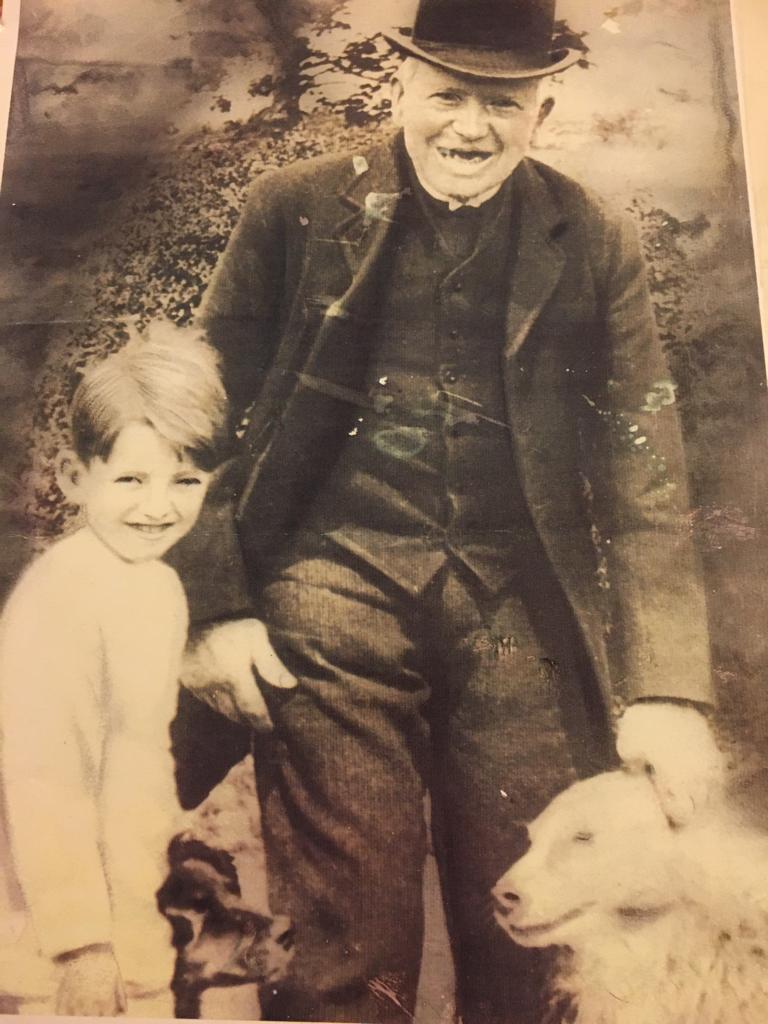
The Photo above was taken at Harbour View between 1916 and 1919. Our father Jimmy Barry with 2 farm dogs and his Grandfather Patrick Ahern, Peg Aherns father. Our father Jimmy was Patrick’s first Grandchild and sadly the only Grandchild he would ever see. Patrick would die in 1921 and sadly would never see any more of his many Grandchildren that were still going to be born all over the world including N. America & S. America.
When our Dad Jimmy Barry was a small boy between the age of 3 to 6 years of age he was living with his mother Peg at Harbour View, where they lived for about 2/3 years. Dad had many happy memories from his time spent at Harbour View both as a boy and young man. I also lived and worked at Harbour View for a year in 1973 and spent many memorable and happy times at our ancestral Ahern home over the years. Dad always maintained that he witnessed some of our Ahern relations burying guns so that the British Authorities would be unable to confiscate or find said guns. Martial Law was declared by the British in Ireland from May 1916 through to November 1916. To avoid complying with this law many people buried their guns in case they needed them in the future for a possible armed struggle against the British. The guns would be readily at hand. Our father as a small boy witnessed this act of defiance against the British authorities who were paying his own fathers wages!!!!
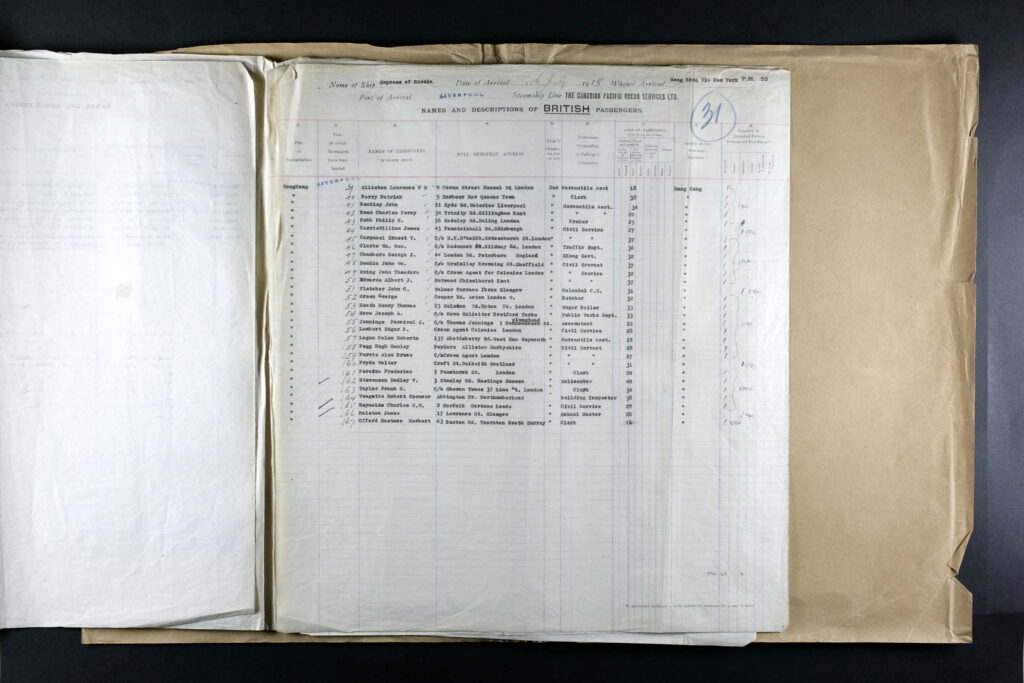

Again, the passenger list downloads do not reproduce very well, so zoomed & cropped version above. This passenger list shows that Patrick Barry returned to Europe from Hong Kong via New York (Different route than Peg & Jimmys from HK!) on the “Empress of Russia” disembarking at Liverpool on the 15th July 1918. Interestingly his European address is given as 5 Harbour Row, Queens Town, his wife’s address in Queenstown before she was married, at least Patrick and Peg were consistent with their home addresses despite Peg & Jimmy living at Harbour View when they returned from HK in 1916!

The “Holy Man” pictured above sat on a bookcase at 181 Ufton Lane and probably other households for as long as I can remember. He possibly returned with Patrick & Peg from Hong Kong and has been with us ever since. His current custodian is Margaret Wood’s, nee Barry, Margaret Ahern, nee Barry (Peg’s) Grandaughter! Hope that makes sense & is correct!
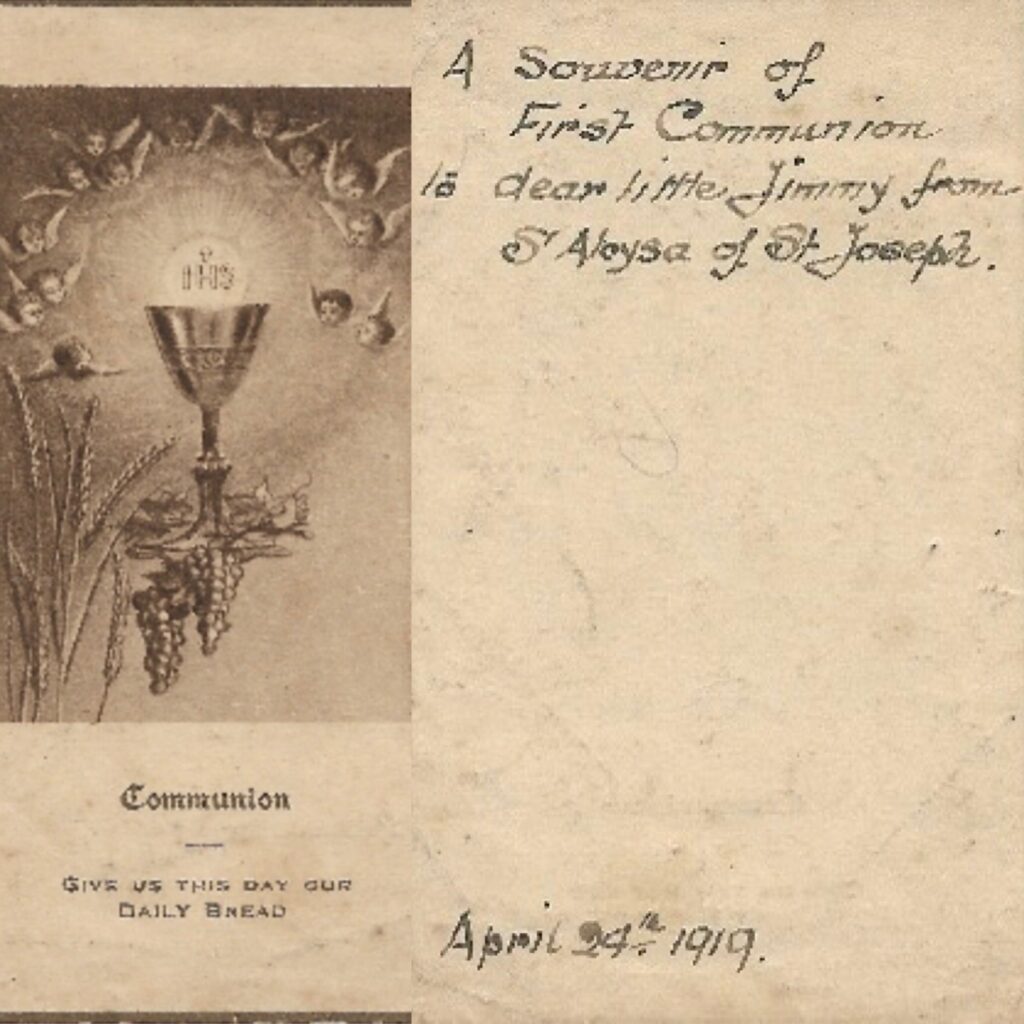
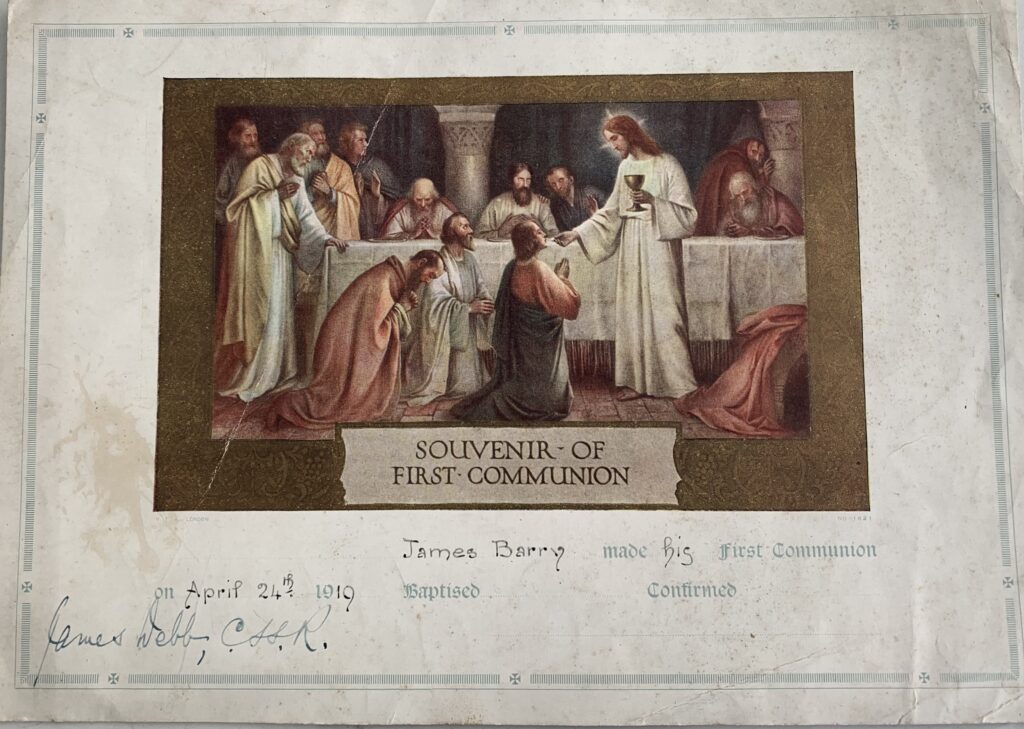

The images above are a record of Our Father’s first Holy Communion. James Patrick Barry made his First Holy Communion on the 24th April 1919 in Clapham, London
Patrick Barry arrived in Liverpool from Hong Kong on the 15th July 1918, As I have no information on where he was or what he was doing, there are a number of options that may have taken place?
1. He travelled to Ireland to be reunited with his wife & son and returned to work in Hawbowline Dockyard Cork. If so did he live in Queenstown or Harbour View?
2. His wife and son travelled to England and Patrick continued working for the Admiralty possibly in London, if so where did they live, Clapham? The scenarios and possibilities of their life between 1918 and 1919 could be endless?!
On the 26th June 1919 the Barry family were on the move again. Patrick Barry was posted to the Naval Dockyard in Bermuda.
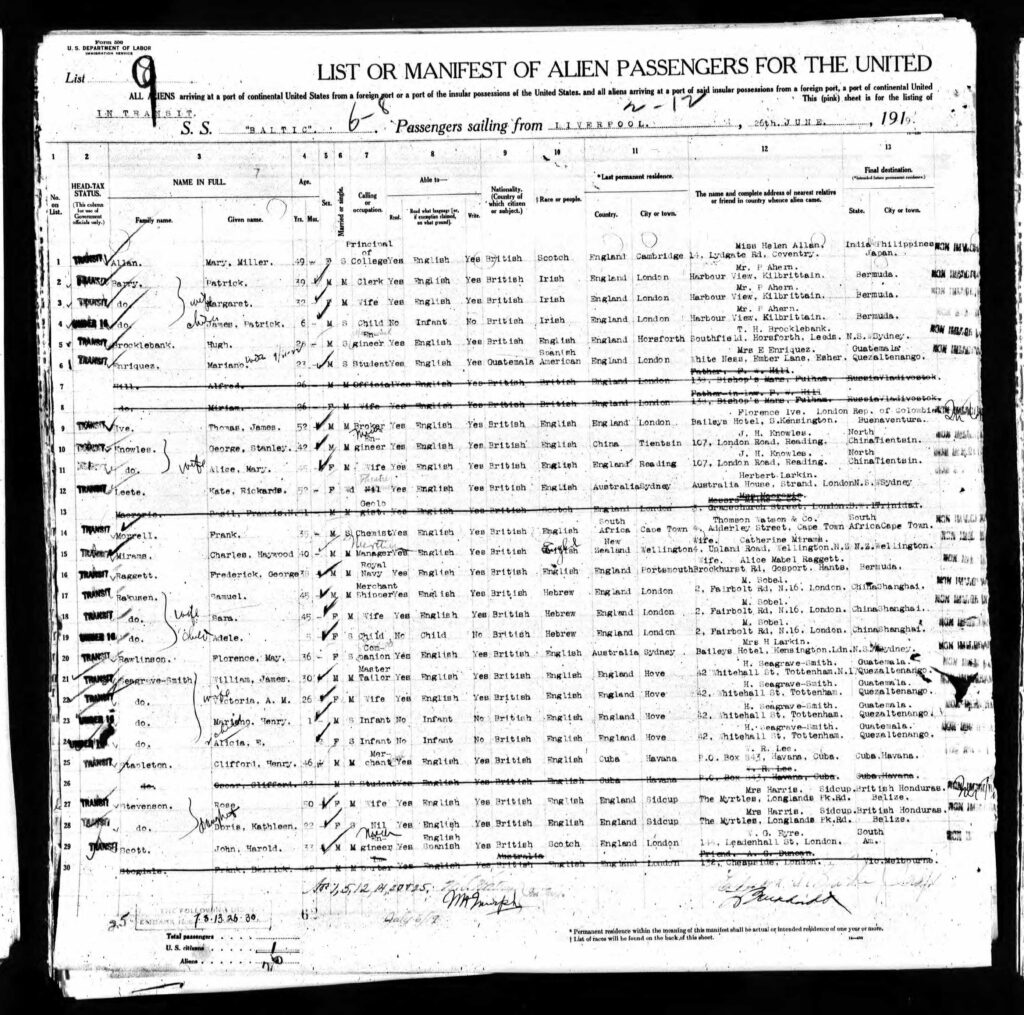

In just under a year the Barry are on the move again. The Passenger list above shows that Patrick, his wife Margaret (Peg) and their 6 year old son Jimmy sailed on the S.S Baltic from Liverpool for Bermuda on the 26th June 1919. The ” Last Permanent Residence” they give on the Passenger list was London, which would indicate that they were living and working in London and also that Dad made his first Holy Communion in April of 1919 in Clapham. Interestingly they give Peg’s Father and his address at Harbour View, Kilbrittain as the name & address of nearest relative. Sadly they would not see Patrick Ahern again as he would die at the age of 93 in 1921. Patrick our Grandfather would also never see his own father again either. His father, our Great Grandfather James Barry died in 1913 in Cork Ireland at the age of 77.
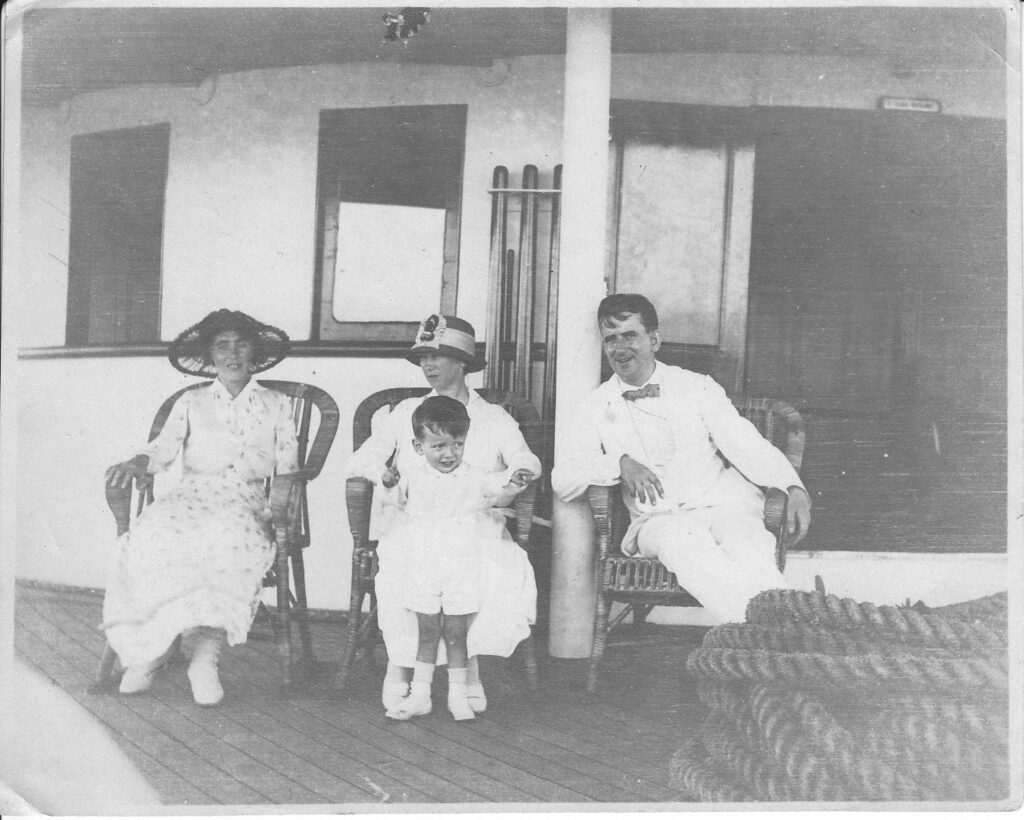
We are not entirely sure where & when this photo above was taken, it could be on a pleasure cruise from Hong Kong or Bermuda. Or it might have been taken in 1919 on the way to Bermuda?
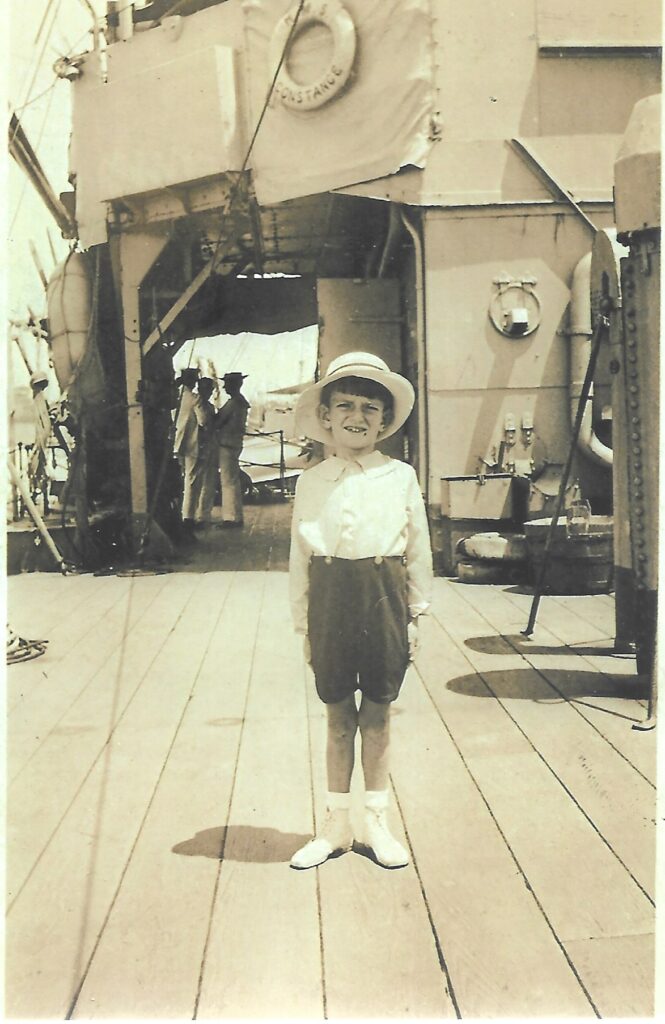
This picture of Dad was taken while he was on board H.M.S Constance, a Royal Navy Light Cruiser. Dad looks about 6 years old in this picture, so it may have been taken about 1919/1920. The sailors in the background appear to be in Tropical whites, and Dad is wearing what looks like his mothers hat to protect him from the sun. It is quite possible that Dad was in Bermuda when this picture was taken and his father Patrick wangled a trip for the family on board this illustrious naval vessel. Dad doesn’t look that impressed though, probably because he has been forced to wear his mother’s hat!
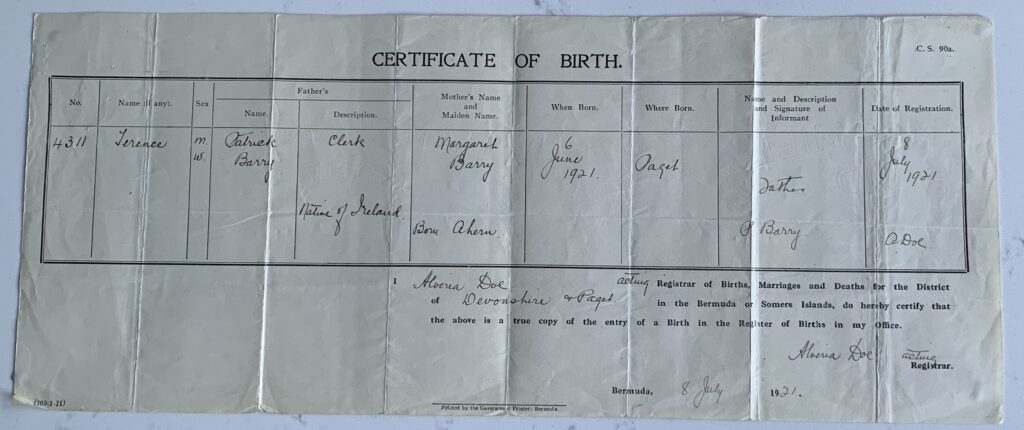
Dad’s beloved little brother Terence, hereafter known as Terry was born on the 6th June 1921 in Bermuda.
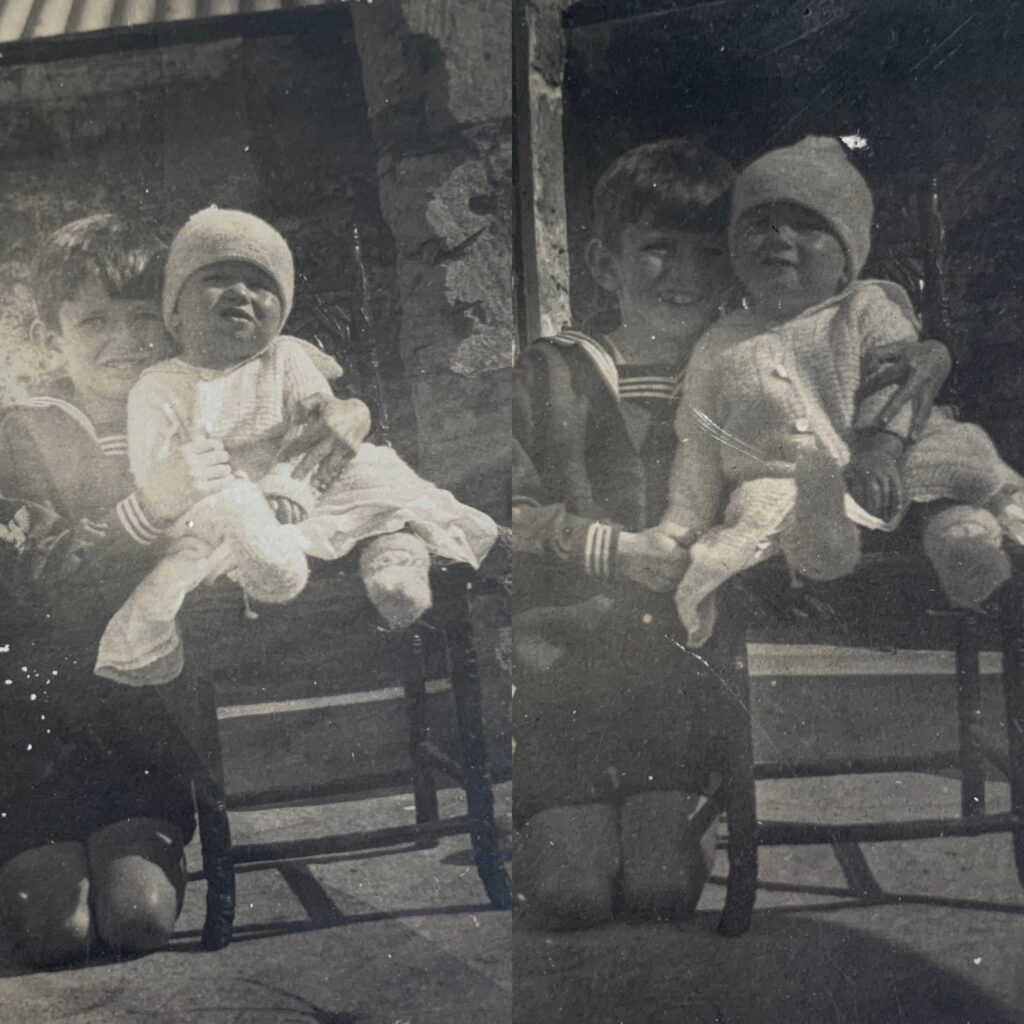
These are the only photos that I have of Terry as a baby, apparently taken in 1922, his brother Jimmy holding him up.

The photo below on the left is of Terry in the go Kart with his brother Jimmy on the right next to him, the other 2 boys must have been Jimmy’s friends. The photo on the right is a later image of Terry with a ball standing on a bench. Both photos taken in Bermuda
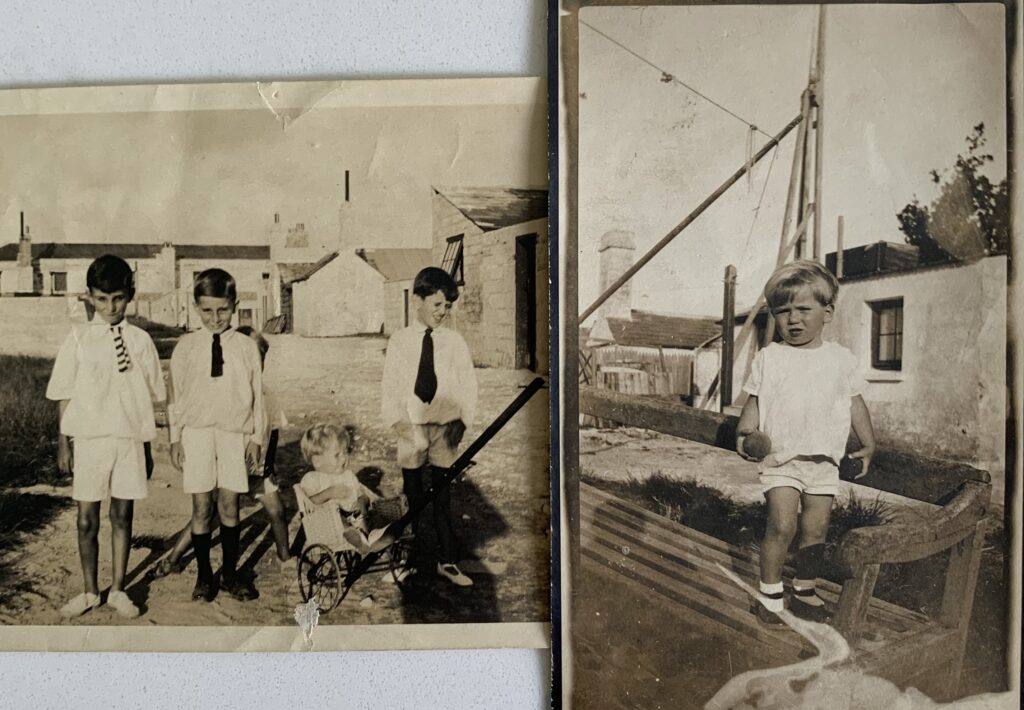
The images below are taken from a newspaper cutting inscribed in Dad’s long hand, transcribed below. Passed to me by Christine in 2025!!!
“The Raleigh was the Flag Ship of the West Indies Squadron when I was a boy in Bermuda. I had tea on board with one of the officers when I was 9 yrs old”
HMS Raleigh was a Heavy Cruiser
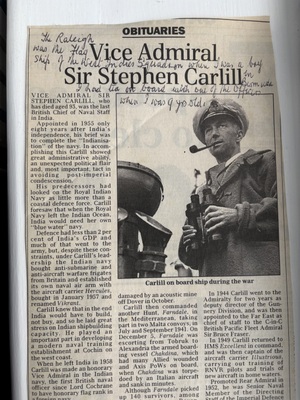

The next event in the Barry families life took place before the 15th September 1925, when they returned to the UK via the Orbita, a Steamship of the Royal Mail Steam Packet Coy. They disembarked at Southampton and had called in at New York from Bermuda on the way home. Our father who later in life was even more travelled than when he was 12 always claimed that he had never visited the USA!!!
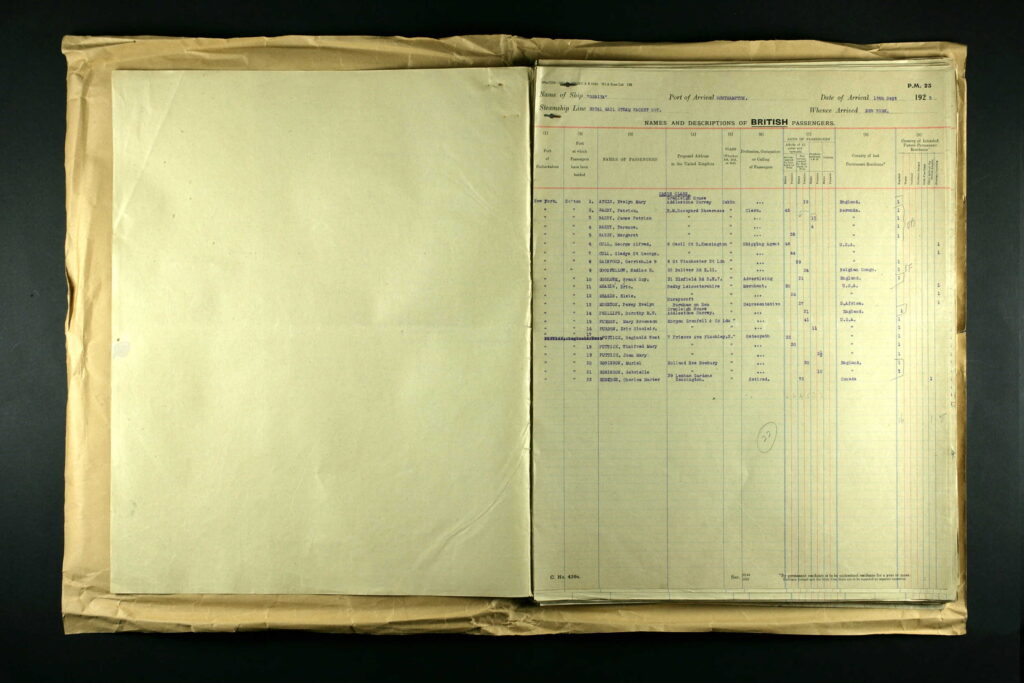
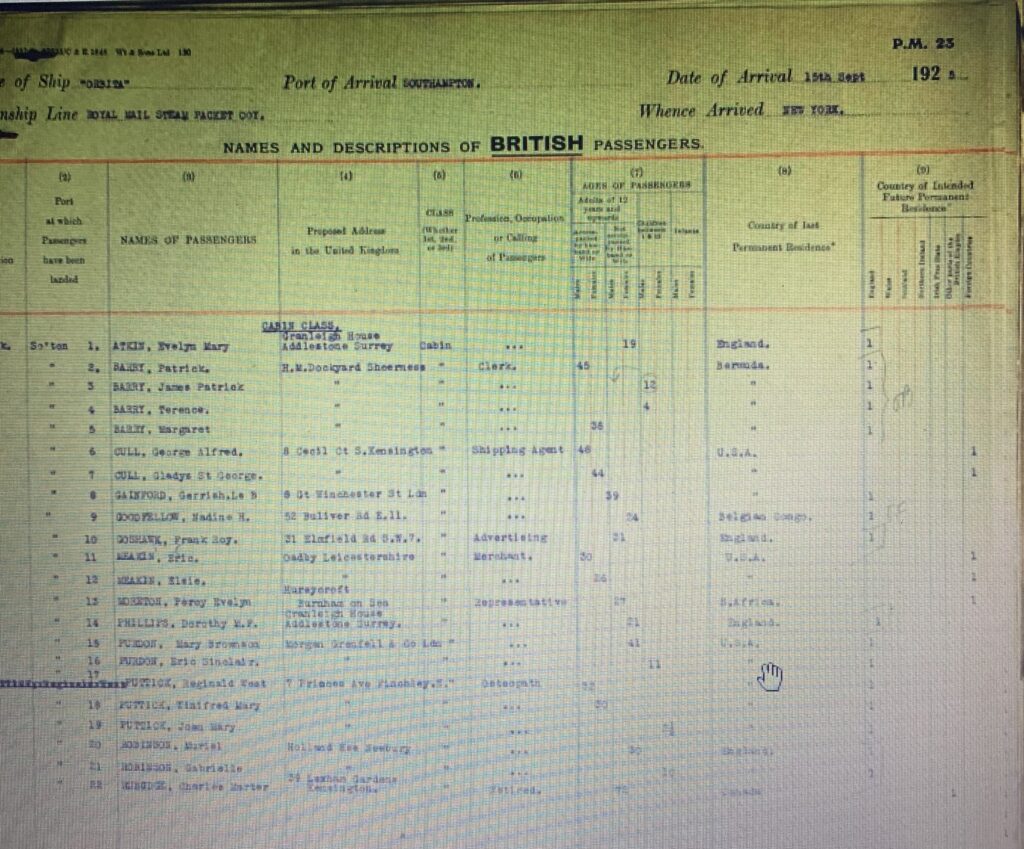
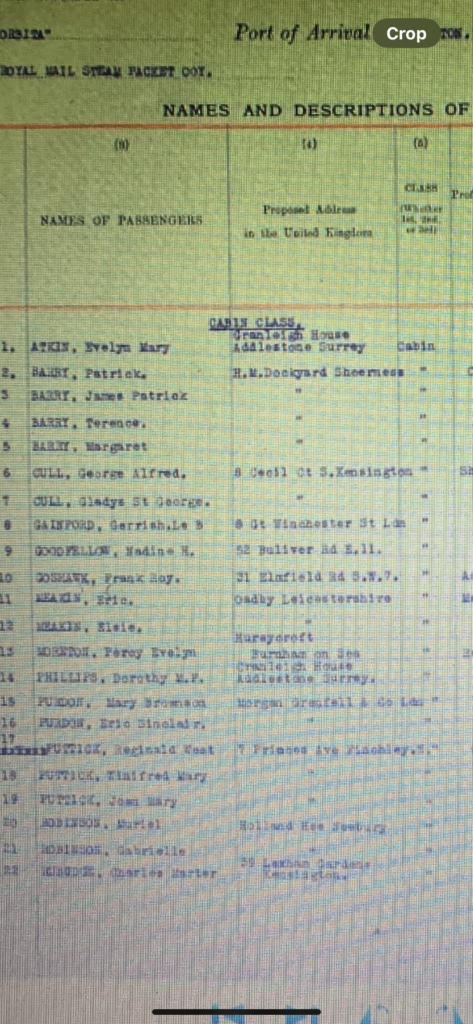
I have inserted several copies of the 1925 passenger list as they are difficult to read and reproduce clearly. Their future address was given as H.M. Dockyard Sheerness, because presumably they did not have a permanent address as yet in the U.K.. To begin with they lived with a family by the name of Ticherer who took in paying guests they then rented a house in Alma road where Ellen was born in 1926. Jimmy and Terry now had a little sister.
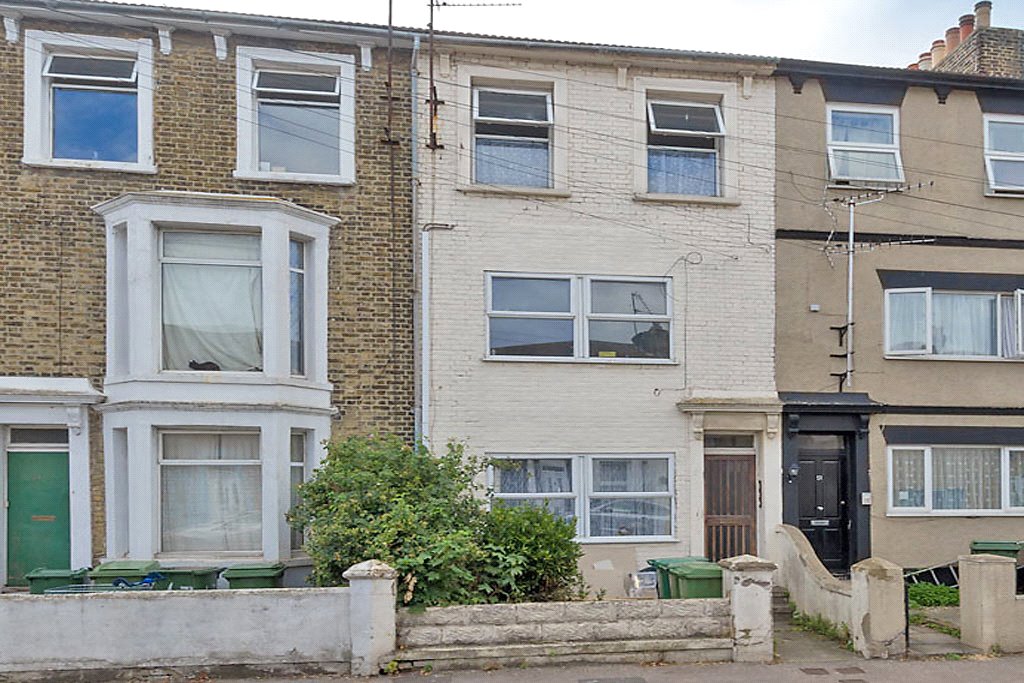
The house with the bushes is a photo I took a few years ago of Alma Rd Sheerness.
You can imagine the trauma associated with the change of scene from Bermuda to Sheppey, so Sittingbourne seemed the sensible choice. Patrick and Margaret waited until Terry had finished at the Catholic Primary School and was going to Borden Grammar (1932) and I (Ellen) was ready for School at the Convent. In fact a year more than ready as they postponed the move until Terry was due to change schools. Jim by that time had been away for a couple of years and was either in Olton near Birmingham or possibly Crawley in Sussex, which was the last Monastery he was at. At first we lived in 58 Park Road (Sittingbourne) and then moved to 35 London Road or Coolmaine Holly Bank Hill which was the initial postal address, the house being built for them by Ted Wraight (very early in his building career) in 1934. The house next door was but one was a nursing home and only later after the war when the Convent was expanding, was it taken over by the Nativity , as a house for their borders and some lay staff. (This piece originally written by Ellen Halewood nee Barry)
Ellen Barry was born in 1926 and attended The Convent of the Nativity Catholic School in Sittingbourne Kent. After finishing her education at the Convent she trained as a teacher and then went back to the Convent to teach. She then spent most of her life teaching, mainly music but in particular singing as she had a wonderful voice herself.
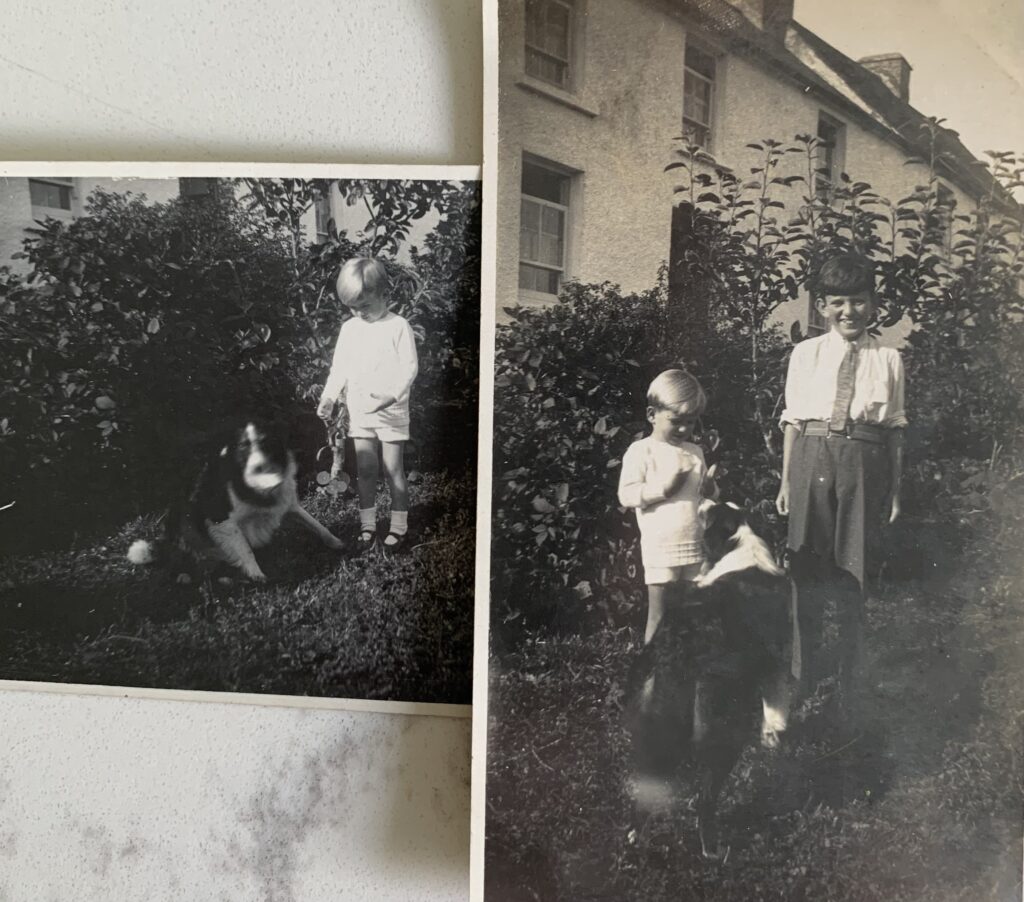
Between the Wars the Barry family regularly returned home to holiday in Ireland. A lot of their time would be spent with family at the Ahern’s ancestral home at Harbour View. There is a story that my father (James’s) unborn sibling was to be named after one of the farm dogs at Harbour View. Had Terry been a girl she would have been given the name Ivy! Not sure if the Dog featured in the photos above is the infamous Ivy!?
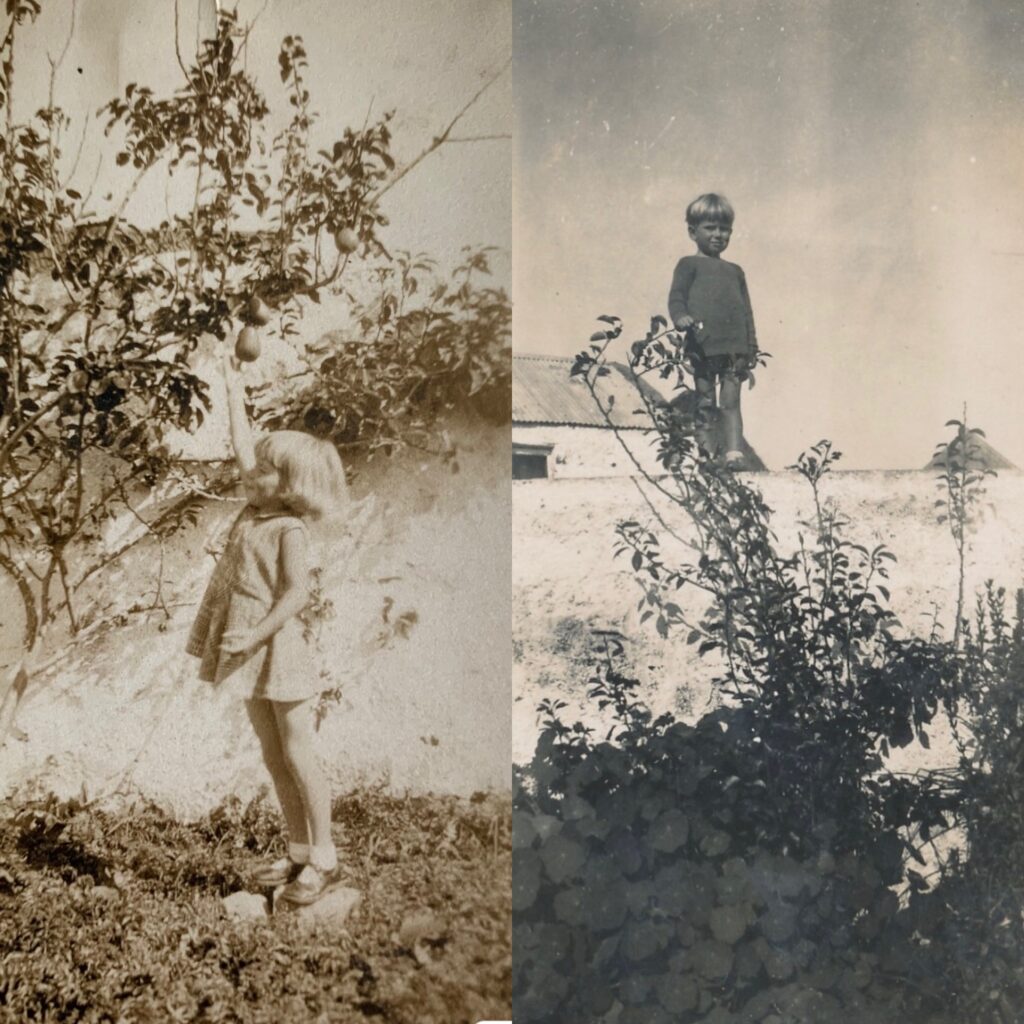
L to R Ellen & Terry, or maybe their parents had a thing about the Pear tree at Harbour View, Cork, Ireland. (Photos above)
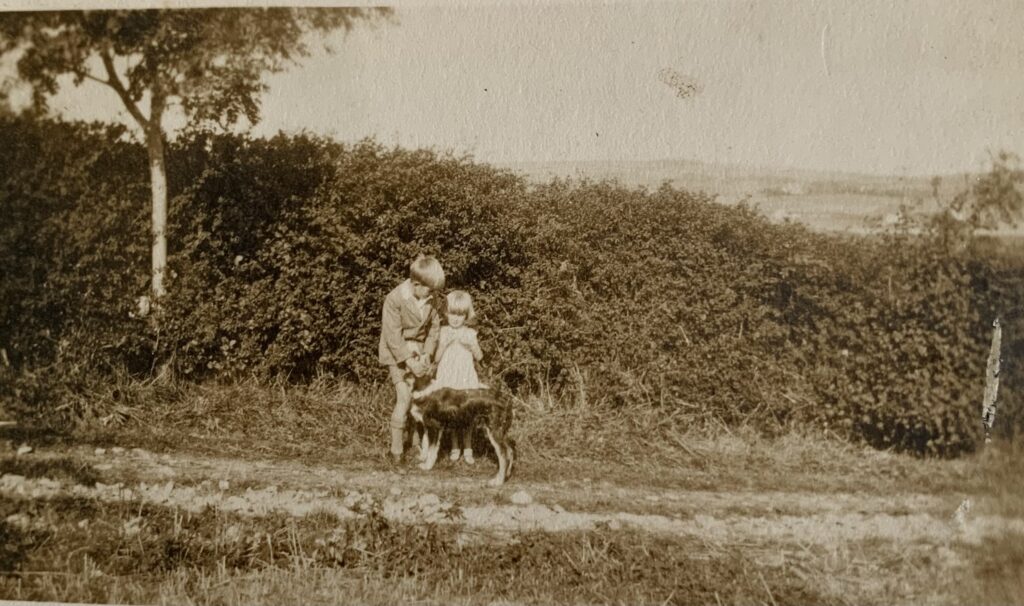
Terry and Ellen with Terry the dog at Harbour View about 1930. I can only surmise that the dog was renamed or………………..
Ellen Barry was born in 1926 and attended The Convent of the Nativity Catholic School in Sittingbourne Kent. After finishing her education at the Convent she trained as a teacher and then went back to the Convent to teach. She then spent most of her life teaching, mainly music but in particular singing as she had a wonderful voice herself.
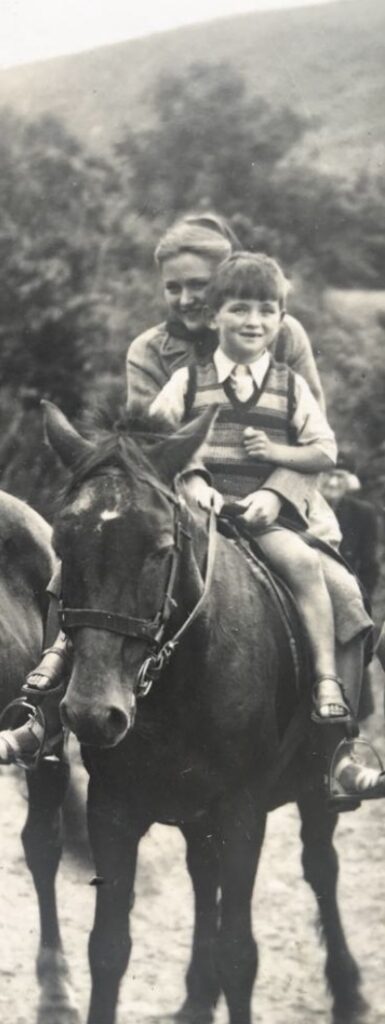
The photo above of Ellen Barry ( nee Halewood) with her cousin Paddy on her lap was taken in 1946 in Kerry, Ireland. This was probably the first time she was able to visit Ireland since the outbreak of the Second World War in 1939 or maybe even before that.
The photo below is L to R, Rita Coghlan, (nee Ahern) her son Frank Ahern & Ellen Barry (nee Halewood) 1960s
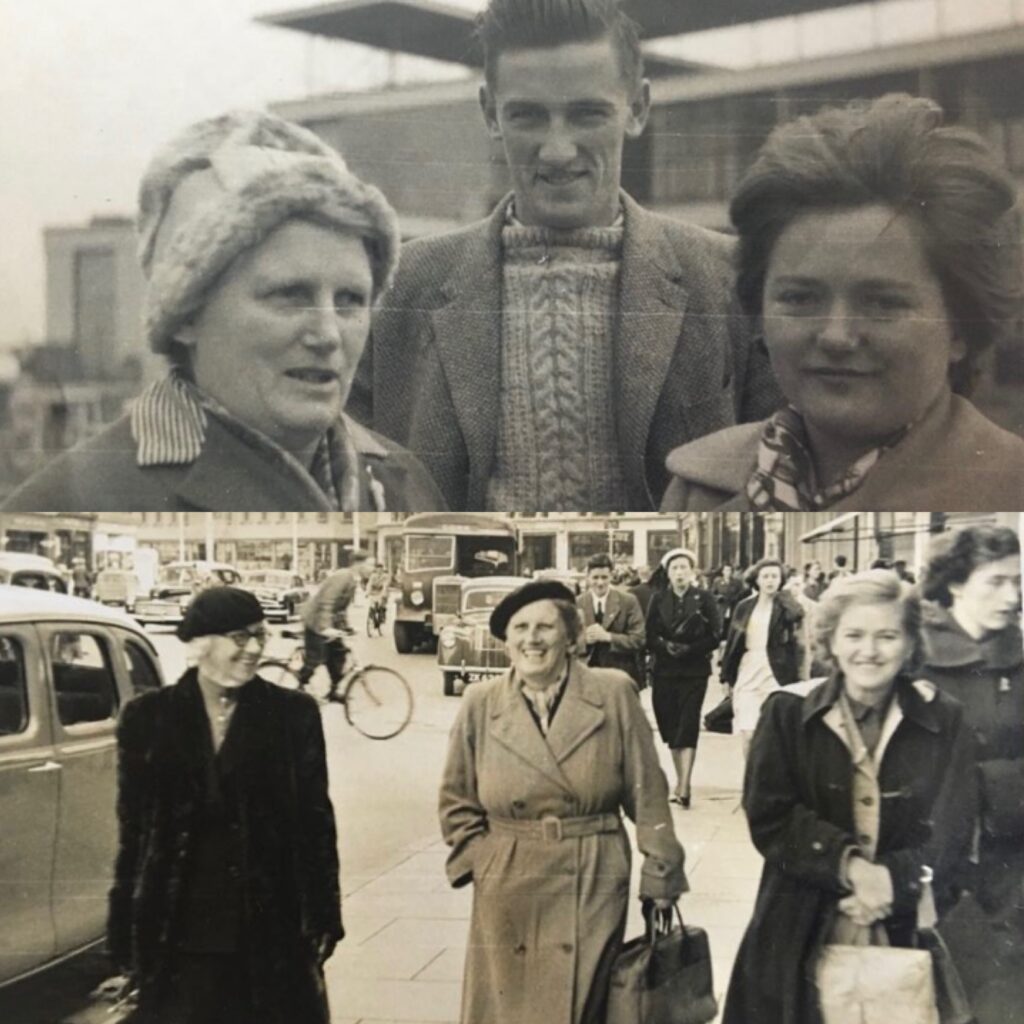
The photo above is of, Left to Right Our Grandmother Peg Ahern, (nee Barry) Rita Coghlan (nee Ahern) & Ellen Barry (nee Halewood) 1950s
Ellen met Gerald Halewood (he was originally from Liverpool) and they were married in 1960 at Battle in Sussex. They lived at Borne End and then in Newcastle. Gerry was a Chemist by profession and worked I think for Shell Research but mainly for Searle Pharmaceuticals. He was the Technical Manager at Searle Laboratories, Morpeth, Northumbria for many years. In his professional life Gerry was a Member of the Institution of Chemical Engineers, Fellow of the Royal Institute of Chemistry, and member of the Institute of Wastes Management.
Gerry was born in 1931, and died in 2013 aged 82. Gerry had many traits one of which was telling terrible jokes. As well as being a devout Catholic, Gerry did some voluntary work for the Samaritans. I do not think that you could have had a calmer person on the end of a line than Gerry, and it goes without saying that his inter relationship skills were exceptional. The Samaritans were lucky to get some one like Gerry.
Later in life when time would allow and more so when he retired he became an excellent potter. I think all the Barrys and Halewoods, and probably many of Ellen and Gerry’s friends and relations, treasure, possess and use many of his skilfully created ceramic items.
His beloved wife Ellen died 6 years later in 2019 aged 92.

The 2 photos above were probably taken in the early 1930s when Terry was at Borden Grammar School, his brother Jimmy was the first Barry to attend Borden, closely followed by his younger brother Terry, then followed by Terry’s namesake Terry Barry, then Gregory Barry his younger brother and then my son Thomas Barry.
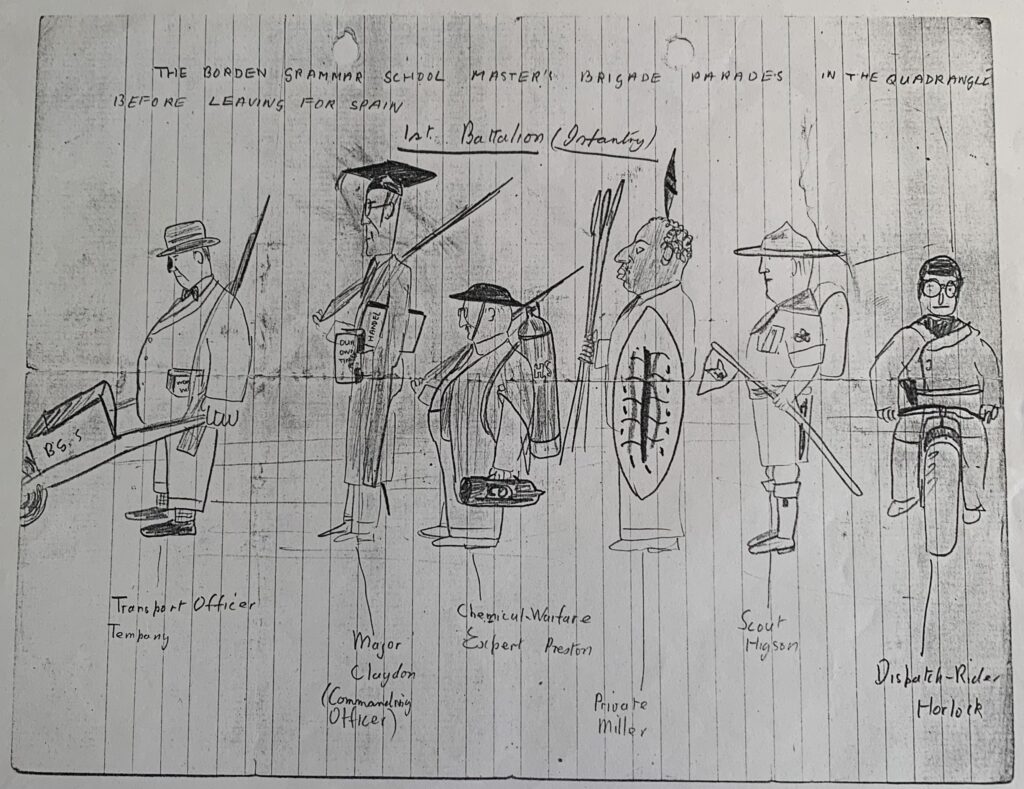
Terry drew this cartoon while at Borden concerning the Spanish Civil war about 1937.

Terry Harbour View 1938. Merton pic nxt

follo by Ellens piece & another soldier pic and graveTerry Barry (centre) at Merton College Oxford on Graduation day 1941.

Terry Barry wrote the above piece about his Uncle, Terry Barry for The Irish Times in 1993.

Lieutenant Terry Barry 1st Battalion London Irish Rifles
ELLEN HALEWOOD FEBRUARY 1995
A journey to Cassino
The fiftieth anniversary of the fall of Monte Cassino was commemorated in May 1994. That battle had marked the turning point of the Allied forces Italian campaign. In April 1994 during a visit to Rome (my first ever time in Italy) we spent one day in Cassino visiting the military cemetery where my brother Terry is buried. That visit and the subsequent study of the theme ‘Literature of War’ have prompted me to record some of the thoughts and memories which have been with me since Terry’s death when he was 22.
One aspect of the two world wars which has been mentioned frequently in class discussion is the effect of suffering on two generations. Fortunately that did not apply to our parents who were in Hong Kong during the First World War and so were not directly involved. Compared with the terrible sufferings of the victims of the Holocaust, of the thousands of refugees, the destruction of Dresden, Cologne, London, Coventry, Hiroshima, of friends who suffered more than one family bereavement. Terry’s death was just one small brush stroke in a gigantic canvas of disaster. Albeit, the effect of his death on my parents was devastating.
When war broke out in September 1939, Terry was eighteen and we were all enjoying our annual holiday at my mothers old home in Ireland.
My uncles and aunts suggested to my parents that Terry should not return to England, but that he should remain in Ireland to continue his education there. At that time, an eighteen year old was still a minor, and though eligible to die for his country, would not have been solely responsible for any decisions about his future. I was thirteen at the time and still remember my feelings of admiration for the integrity shown by my parents. They responded that they had always earned their bread & butter from the British (my father was employed by the Admiralty) and they felt it would be wrong to protect Terry from service in the armed forces nor indeed, would he have welcomed such protection. Later on he rejected the six months deferment which would have delayed his call-up. Our Irish summer holidays had always been the highlight of our young lives, and the memories of those days are all happy – perpetual sun- it never rained !!! Little did we realise when we left in 1939 to return home to England that it would be six long weary years before we would revisit Ireland, and that that particularly idyllic period of our lives was gone forever.
Eventually Terry went up to Oxford to Merton to read History and there enrolled in the O.C.T.U. After a year, he volunteered & on March 13th, 1942, three months before his twenty first birthday he was commissioned in an Irish regiment – his first choice: The London Irish Rifles. His uniform was very distinctive – his Sam Browne, buttons and cane black, and instead of a peaked cap he wore a dark green ‘ caubeen’, that is a very large voluminous beret, adorned with a blue plume fastened on with the regimental insignia of a silver Irish harp. I was very proud to be seen in his company in our small town; his uniform a lively contrast to my rather dull brown tunic, blazer and dark brown lisle stockings! This rather flippant, youthful attitude soon altered when in the ensuing months, the grim reality of war impinged on my consciousness.
In August 1942, the battalion of which Terry was a member embarked on a long journey via South Africa & India to their final destination in Iraq as part of the Persia & Iraq force. In his letters he was not allowed to give any details of the journey, but in one air letter he did drop a hint saying that he was on a troop ship which had connections with one that was known to my family. This told my parents that he was on an air O boat, as they had travelled on the Orbita from Bermuda when Terry was four years old. They subsequently heard that an O boat troopship had been torpedoed; this gave my parents some anxious weeks until Terry’s letters began to arrive. As a young teenager, I was still completely optimistic & caught up, I am ashamed to say, with the so called romance & glamour of wartime e.g. my preoccupation with smart uniforms – the kilts of the Highland Light Infantry who were stationed nearby! It is only in maturity, with a son of my own, that I realised the anxiety & terrible strain that those war years brought to my parents. My father spent long hours in the office in the dockyard, where he worked in a naval department. He and my mother bore the burden of worry about two sons overseas, in a quiet way which protected me, shielding me from that all- embracing anxiety.
Terry was involved in the invasion of Sicily and later of Italy. His letters are a record of that period. Needless to say, he was not allowed to give any campaign details; he somehow managed to write interestingly avoiding the topic of war; one would imagine he was writing from a pleasant holiday venue e.g. he described Sicily as ‘Very attractive in parts; the coastal plains are covered with orchards – lemons, almonds, & very often with vines in between. The grapes are only just beginning to ripen, but in a few weeks they should be perfect. There are acres of tomatoes too.’ June 1943.
He continued to read. He asked us to send Newman’s‘Apologia pro Vita Sua’, and Bagehot’s ‘English Constitution’. These were among the last books he read. My father posted regularly to him copies of ‘Dublin Opinion, (The Irish Punch) the Times, & the Observer. One could picture these & the mail being brought to the troops by mule up the hillsides in the terrible weather of that winter in 1943, when the battle raged for the strategic massif of Monte Cassino. There were 1900 casualties of whom Terry was one on December 5th 1943. News of his death came in a telegram delivered late on a Saturday night about two weeks later. Vera Britten’s description of the delivery of the telegram announcing her brother Edward’s death brought back that moment very vividly. The difference was that in the second world war, the telegraph boy was warned, when the news in the telegram was of a fatality, not to wait for a reply. My cheerful parents were never quite the same again, & bore their grief with dignity and courage. For them there was not even the comfort of the ritual of a Requiem – only the prayers at Mass the next morning. For me – that was the moment I grew up and left behind the romantic notions that I had nurtured previously.
Initially, Terry was buried in a simple grave in a village cemetery. Later his body was transferred to the military cemetery at Cassino where we went last April to say aprayer for him & the many English, Commonwealth & Polish soldiers & airmen who lie there. It is a very English scene, with red roses and beech at the entrance. My husband and two friends who accompanied us, helped me to plant on the grave a small cutting of a Veronica shrub which we had taken originally from the garden of my mothers home in Ireland. As we stood by the grave and looked up at the mountain on which the new Cassino monastery stands, we had the answer to the question posed in Alan White’s poem ‘Monastery Hill Cassino –
Alan White killed in Italy May 1944
‘We wonder too if monks will ever
resurrect the spirit of the monastery,
or if it will be forbidden them,
forever branded as an evil monument,
a bastion feted by historians,
and once a valuable accomplice
in the art of war’
The road to Rome for those who fought in the Italian campaign had been long and arduous. The battle for Cassino had been bitter and bloody. Field Marshal Lord Cawmore – ‘the troops were faced with fighting battles as fierce, and enduring hardships as great, as those experienced by their forbears in the First World War.
My journey to Rome & Cassino 50 years on, for me had been something of a pilgrimage. I left there feeling very much at peace & would end this personal story with a Postscript which is positive and looks forward to the next generation.
My older brother, in 1949, named his first son Terence Bernard Barry. (Bernard for the Benedictines!) He too went on to study History and now teaches at Trinity Dublin. He is happily married with children of his own. He cherishes the memory of the uncle he never met, & whose name he bears. In December 1993 he wrote an article for the Irish Times in which he paid tribute to my brother, to the London Irish Rifles & to the Cassino campaign.
Ellen Halewood nee Barry.
The letter below is probably the first of many letters that Terry wrote to friends and family.
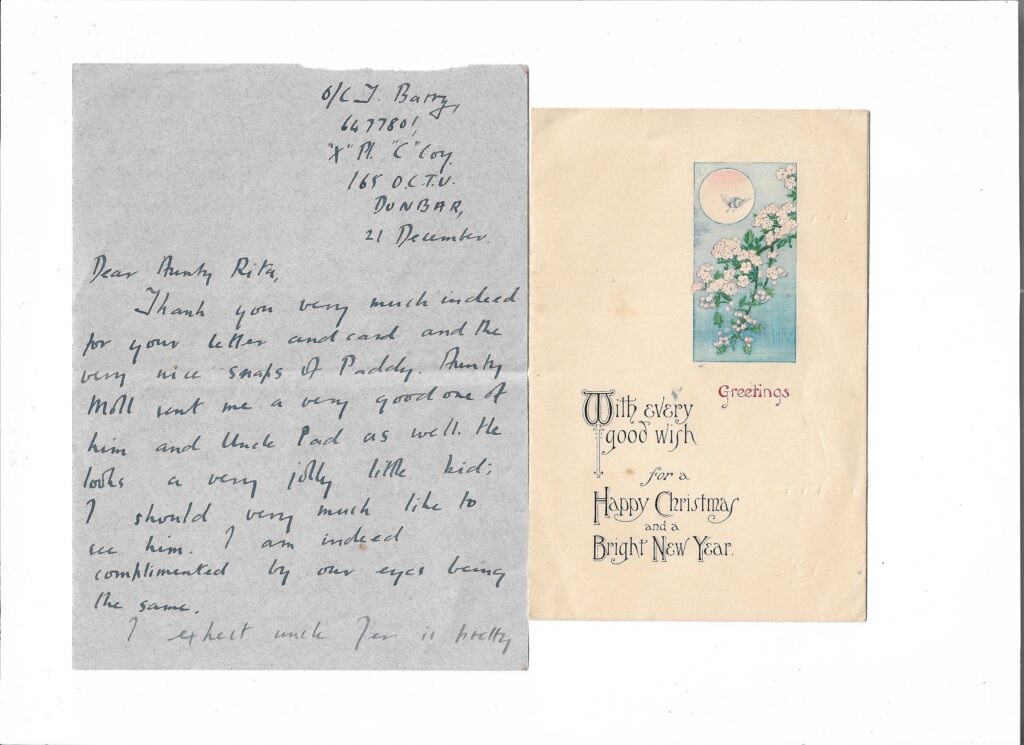

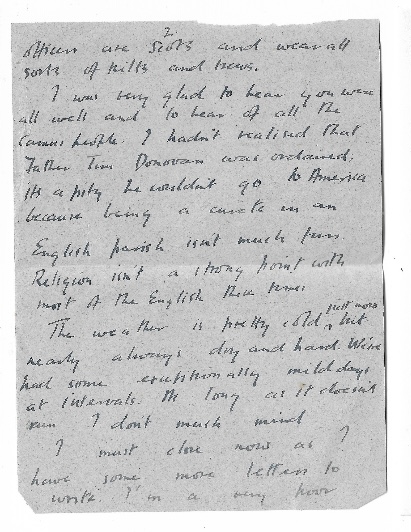
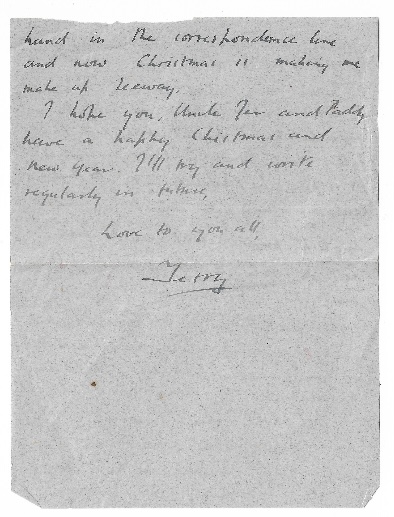
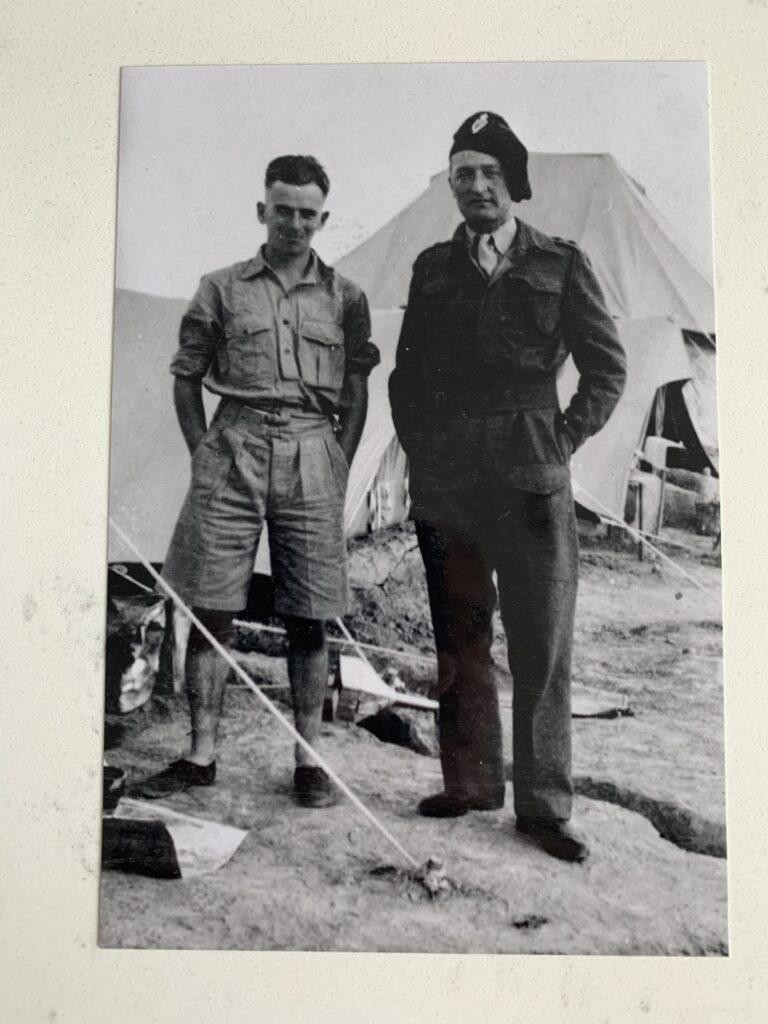
The inscription on the back of this photograph above reads – Terry Barry & Capt Hardy in Iraq 1942.
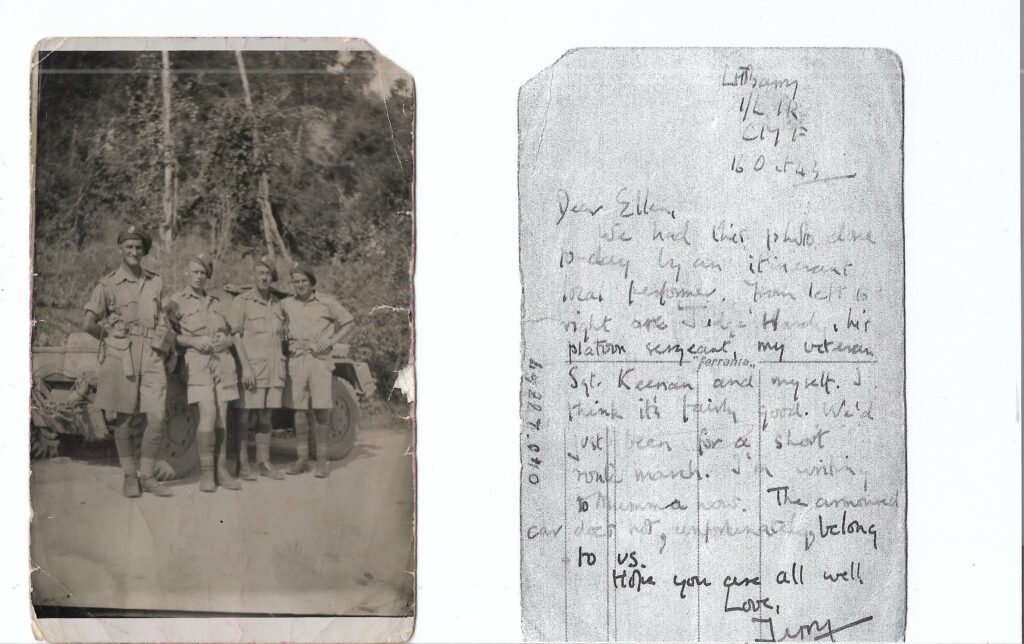
The photo above was taken in Italy 16th October 1943.
From L to R are Judge Hardy, his platoon Sergeant, my veteran Sgt Keenan and myself.
I have managed to find the following information – Judge Hardy was badly wounded in the battle for Anzio in February 1944 & was awarded the Military Cross for his endeavours at Anzio in June 1944. His platoon Sergeant next to him in this picture was not named, so I was unable to trace his service. Terry’s veteran Sgt Keenan (from Northern Ireland) died on 9th September 1944 at the age of 39 during the battle for the Gothic line. “A magnificent soldier & man was killed in his slit trench by a mortar bomb bursting in the trees above.” He is buried at Gradara War Cemetery Italy.
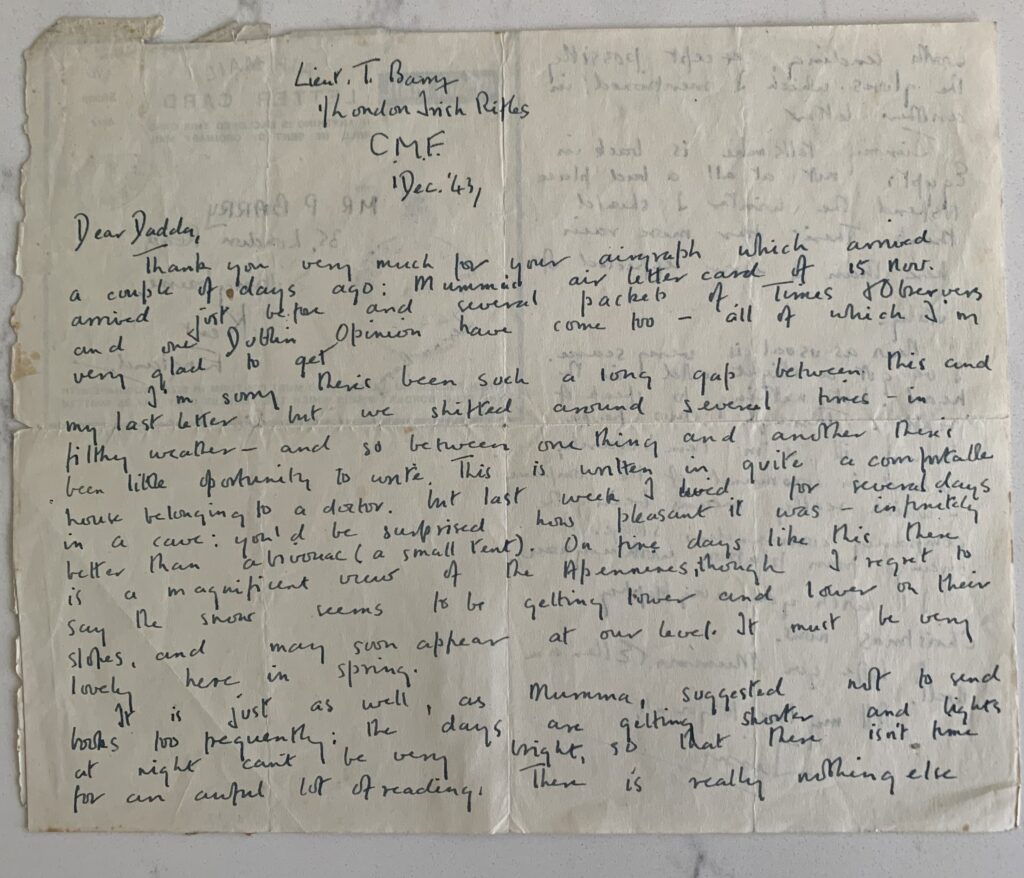
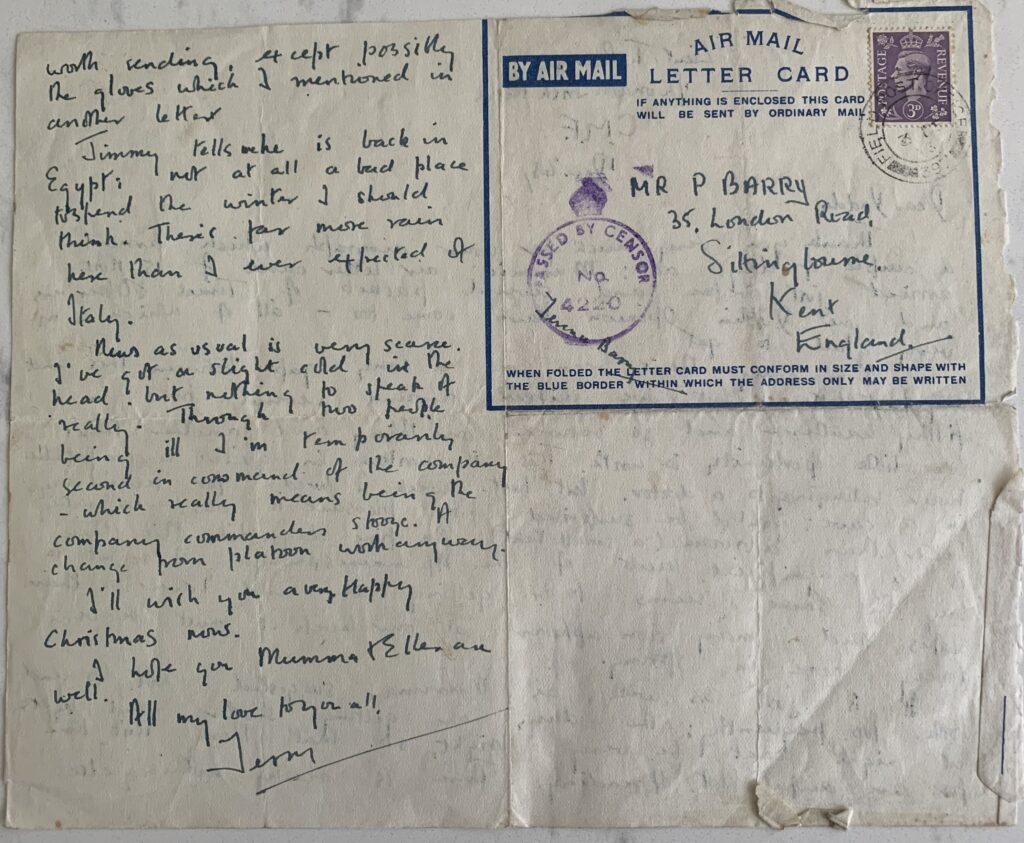
As far as we know, this letter dated 1st Dec 1943 was Terry’s last letter home to his parents before he was killed in action at Monte Camino 5th December 1943.
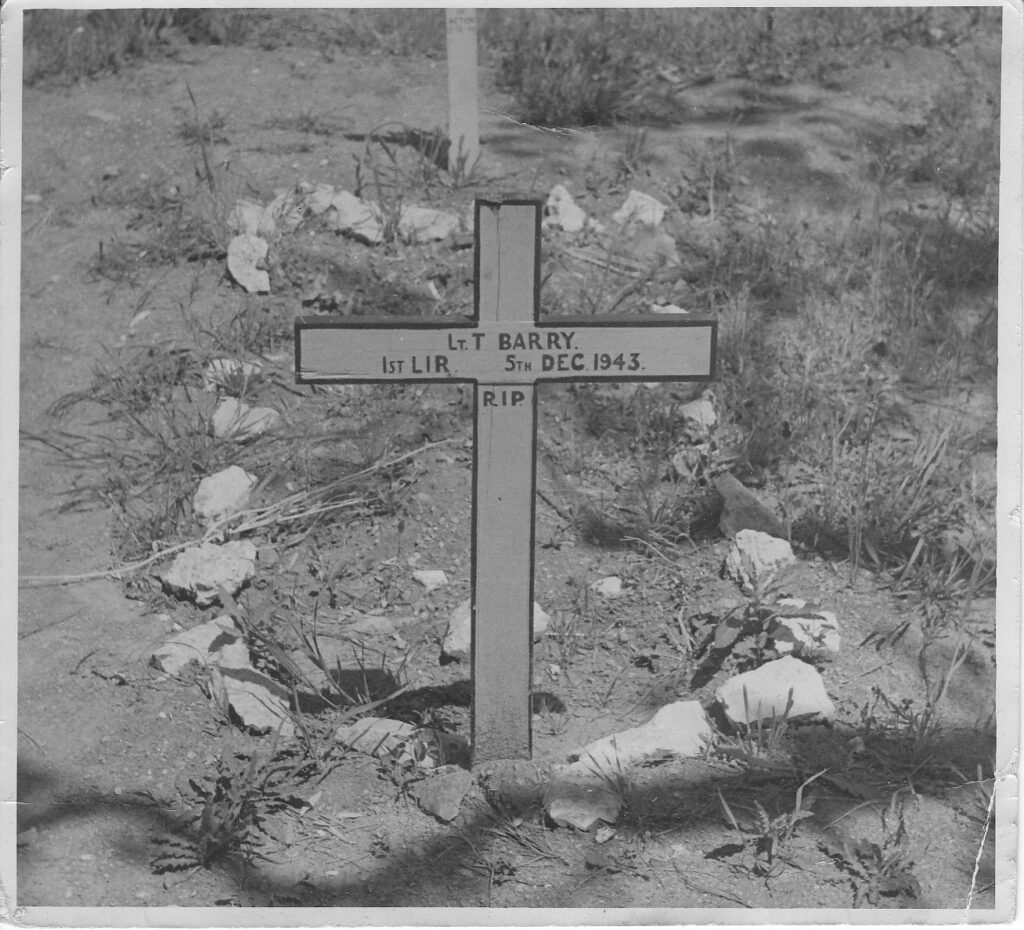
Terry’s grave in the cemetery at the foot of the hill, close to where he was killed in action and where his brother Jimmy visited the grave of his little brother in 1945.
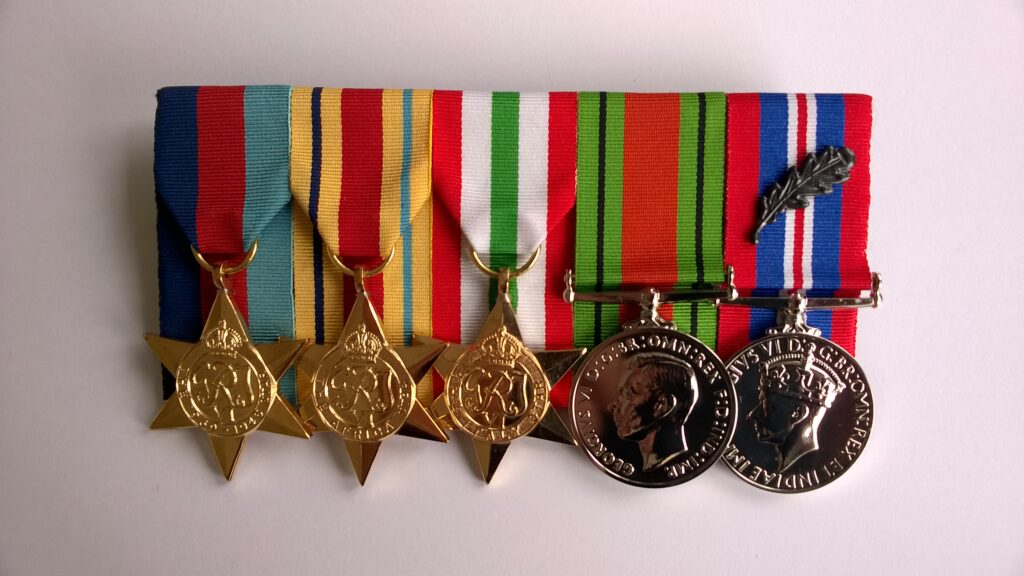
. My younger brother, Gregory Barry who has a keen interest in all of our extended families medals and military service asked our fathers permission during the 1980s to apply for Terry’s Medals. Gregory duly filled out the required forms and received Uncle Terry’s Medals. These consisted of 1939-1945 Star, The Italy Star, The Africa Star, The Defence Medal 3/9/39 – 2/9/45 and the 1939-1945 War Medal. The Bronze Oak Leaf on the ribbon of the 1939-1945 War Medal was awarded for a Mention In Despatches. This was usually awarded to men whose name appears in an official report written by a superior officer & sent to the high command, in which their gallant or meritorious action in the face of the enemy is described.

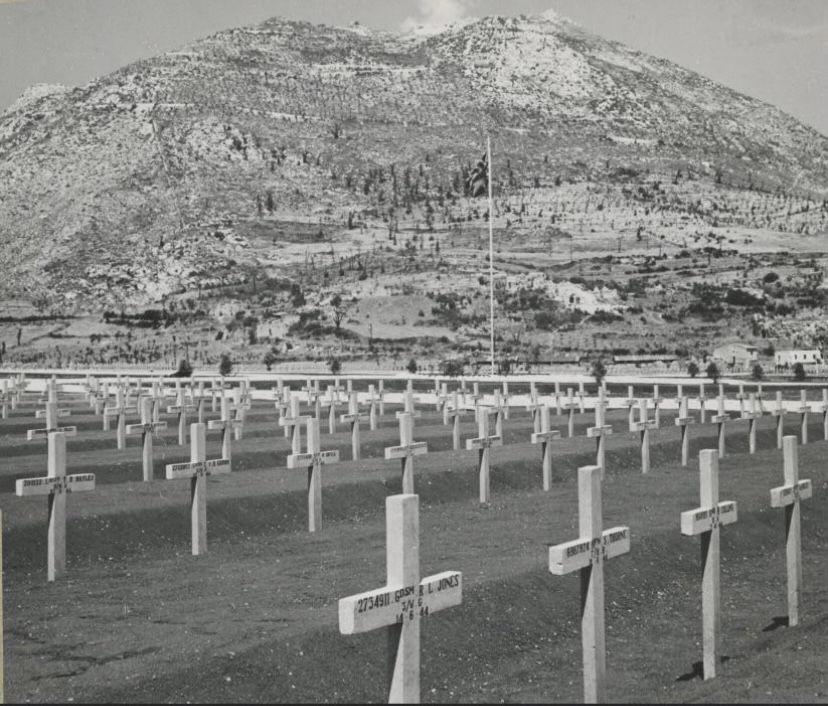

Terry’s eventual resting place in the Commonwealth War Graves Cemetery dominated by Monte Cassino, Italy.
Over the years since Terry was killed in action, many of his relations, (far too many to mention here) have made the journey/pilgrimage to Italy, Monte Cassino, Monte Camino and the Commonwealth War Grave Cemetery to visit the areas where he served and was killed in action, and buried, to pay our respects to his valiant life and death.
I speak for all of us when I say that it is a measure of a man that none of us met, but so many people of his generation spoke so highly of, that we are all grateful for his ultimate sacrifice. R.I.P.
Last but by no means least I return to Terry’s beloved older brother, James Patrick Barry (Jimmy) We believe that Dad began his secondary schooling at Borden Grammar School in 1926. The Borden Grammar School photo of 1926 is below with James Patrick Barry 5th from the left, front row, sitting.


I think that we will all be surprised that Dad failed three out of his seven subjects – including mathematics ! (Probably Dad’s final examination results before he left Borden)

Essentially, the above record is Dad’s official Statement/ Application to enter the Capuchin Friars.

The above photo surfaced in Camus Ireland in 2020 at Jer Aherns house, Jer being Jimmy’s mother’s brother, so Dads Uncle. This was the first photo we had ever seen of Dad in his Capuchin Robes.
Thanks to our elder brother Kevin James Barry, we were finally, in 2021 to find out the gap in Dad’s life between 1931 – 1938. The following information is what Kevin finally managed to find out.
Dad’s life as a Capuchin Franciscan 1931 – 1938
Notes compiled August to November 2021
It was probably in about 1974 that we first knew that as a young man, Dad had been a Franciscan friar. But we none of us thought to ask him about the details of that part of his life. So now we are having to engage in genealogical research to try and uncover what we regard as the “hidden years”. Why we didn’t talk about this period of his life is probably because of a number of factors. First he was not a man who talked easily and openly about his personal thoughts, feelings or about his past. He was a man of his generation and of Irish stock. Also the period immediately after his leaving the Franciscans was dominated by his six years of war service as a warrant officer in the Royal Engineers – a life of far more interest to us as young boys and men than what might have proceeded these adventurous times. Also of course there were photos of him in battle dress, in a dugout at Alamein, on a motor cycle “somewhere in the western desert” and he also kept (illicitly) a note of his war time postings and travel. At that time we had no photos or diaries from his time as a Franciscan to stir our interests. There were clues of course; his books on catholic theology and his knowledge of philosophy and dogma, the occasional visit to the house by a Franciscan friar – Br Agnellus, but we never thought to ask until it was too late.
In July 2021, Kevin tracked down the archives of the British province of Capuchin Franciscans and they were extremely cooperative in giving him access to Dad’s file and also access to the handwritten journals that each friary keeps. They also made a copy of the file for us.
This note by Kevin is based entirely on the documentation found in the Dad’s small file, in the two journals from Olton and Crawley Friaries, and two registers which are kept in the provincial archives.
Summary
Dad joined the capuchin Franciscans in 1931 directly from Borden Grammar School. He was 18 years old. He went first to the Friary at Pantasaph in Flintshire North Wales on 10th March 1931 where he became a postulant, as men who wish to join the order were known when they entered the Noviciate. The Friary is still a capuchin friary but now functions as a retreat centre. He was received into the Capuchins at Pantasaph on 21st April 1931 and became a novice when he received the habit of the Capuchins on 21st September1931.
He then moved to Olton Friary in Birmingham on 29th September 1932 (Olton Log Book entry of 29 September 1932) where the order had its noviciate at that time. He took simple vows on 22nd September 1932.
Sometime between September 1934 and November 1935 (both Olton and Crawley Log books are silent as to the date) he moved to Crawley Friary
He was solemnly professed as a Capuchin Franciscan on 23rd April 1935 (presumably at Crawley Friary but again the Crawley Log Book is silent on this). This is the final and (in the eyes of the Church) irrevocable step when he would have made lifelong vows of poverty chastity and obedience. However in 1938, he was dispensed from these vows (by rescript from Rome) and returned to the lay state, leaving Crawley Friary on 15th September 1938.
My recollection in 1974 when Dad told me for the first time that he had been a Capuchin, was that in 1938 when he expected to be ordained as a subdeacon (the first step on the path to priesthood) he was called up by his religious superior and told that he was regarded as being “too radical” and would not be recommended for ordination but would remain a friar, and that he decided to leave as he wanted to be a priest and not just a lay brother.
I also have a hazy recollection that he was told he should leave the order, but cannot be clear about this.
I could find no documentation in the Capuchin archive about this matter. The usual process is that applications for ordination and admission and vows are discussed by the superiors and recorded at what is known (at least in the secular clergy) as ‘Orders Meetings’ but I could find nothing like these minutes in any of the archived material.
The document sent to Rome for Dad’s dispensation from his solemn vows, throws no light on this matter either. It is a proforma document which declares: “that he is unequal to the burdens of the religious life and most humbly implores the help of an indult of secularisation”
Our brother Kevin has managed some superb research on this part of Dad’s life & unearthed a huge amount of official documents relating to Dad’s life as a Capuchin from the Capuchin Archive. Many of these are in Latin which is one of the reasons I am not posting them here. However there were some black & white photographs on Dad’s file, one of which featured Dad. I also colourised this photo, these appear below.

I think you will all be able to spot Dad, shortest man middle back row.
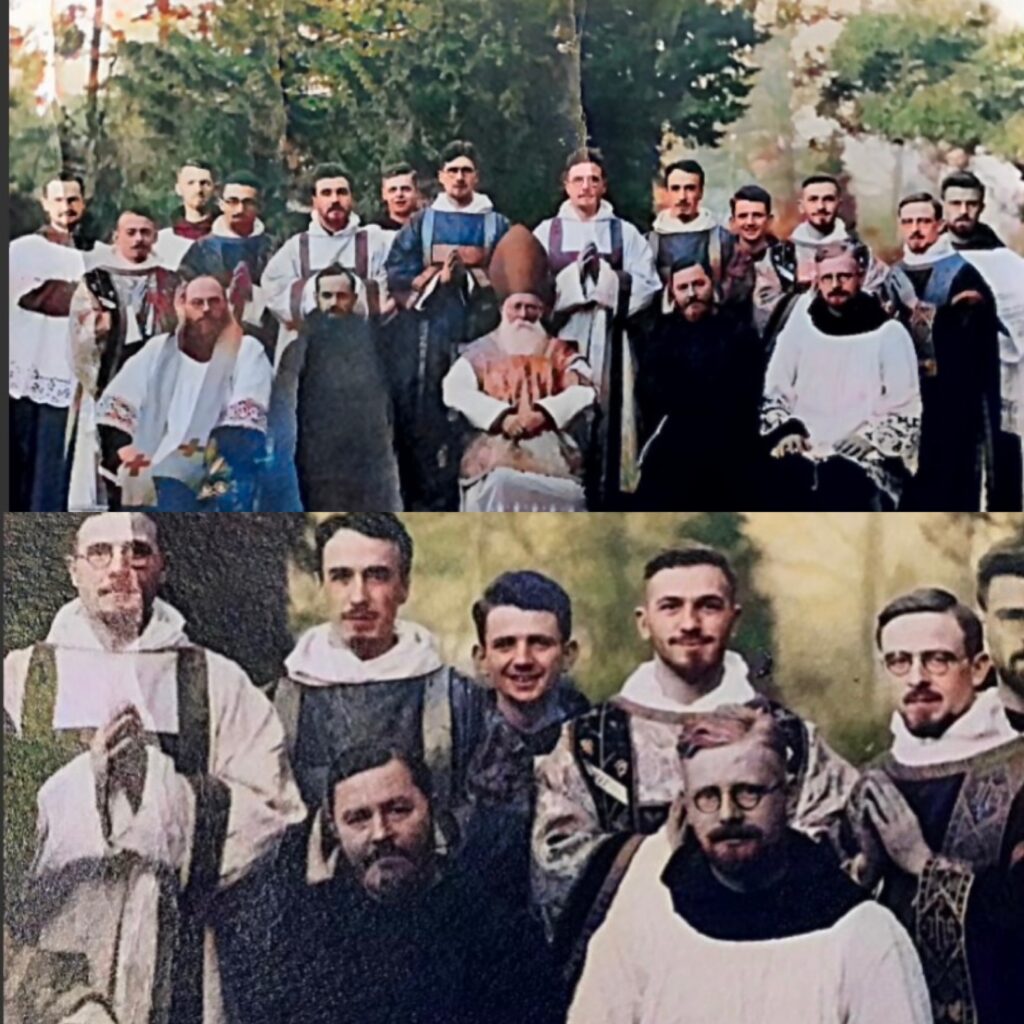

When Dad left the Capuchins he returned home to Sittingbourne and gained employment as a Dockyard Clerk in Sheerness Naval Dockyard, the same employment as his own father. The 1939 Register (Census) record (shown above) that took place in September of this momentous year showed that Dad was living at home with his parents.

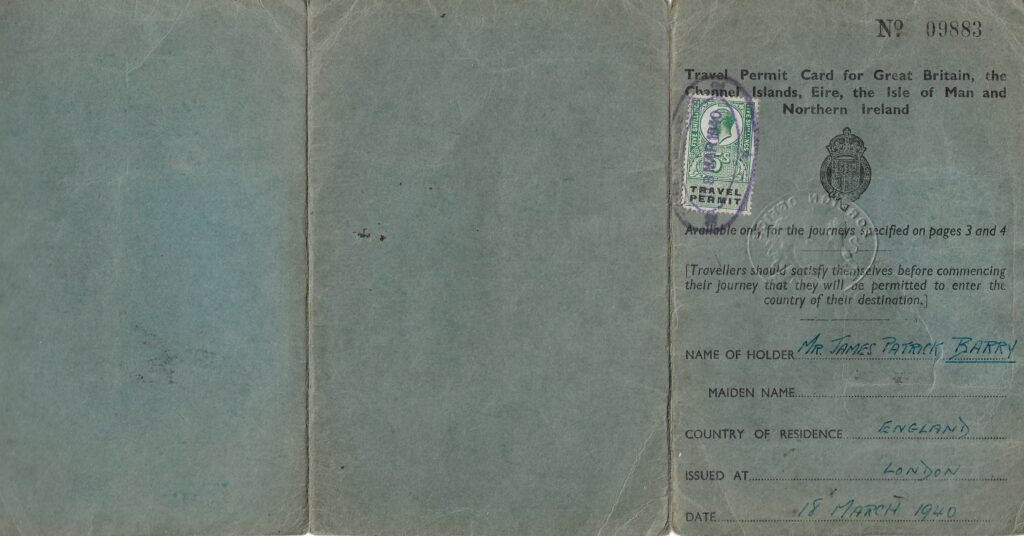
During the Summer of 1940, Dad travels to Ireland as shown on his Travel Permit Card above. We can only surmise that he went on holiday to Ireland to visit his beloved Ahern relations. Maybe at this time he had already decided to follow his younger brother and join the armed forces, as Britain was now at War with Germany. Perhaps he thought it might be his last chance to visit a people and place he loved, before he went off to a War that he might not return from.
On the 16/12/1941, Dad joined the Royal Engineers Training Battalion at Worthing, East Sussex. From the date he joined up until he was Demobbed on 13.3.46, we think Dad kept an illicit diary? None of us have seen this supposed diary! What Dad did leave us with was 2 identical records, one hand written, and one typed, with the title ” The Travels of J.P.Barry in WWII” – The first page of Dad’s hand written “Travels” appears below.
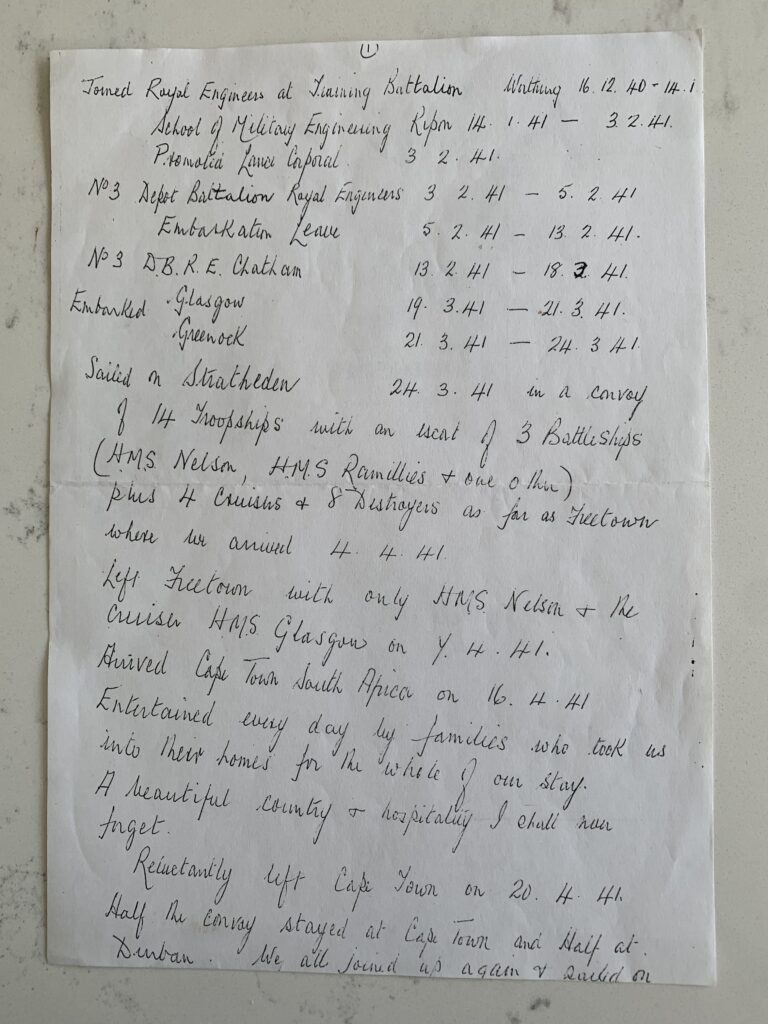
Dad took a large number of photographs & also had a lot of photographs taken of himself, he also collected a fair quantity of postcards as well on his travels. The photo below, is one taken in Cape Town, South Africa
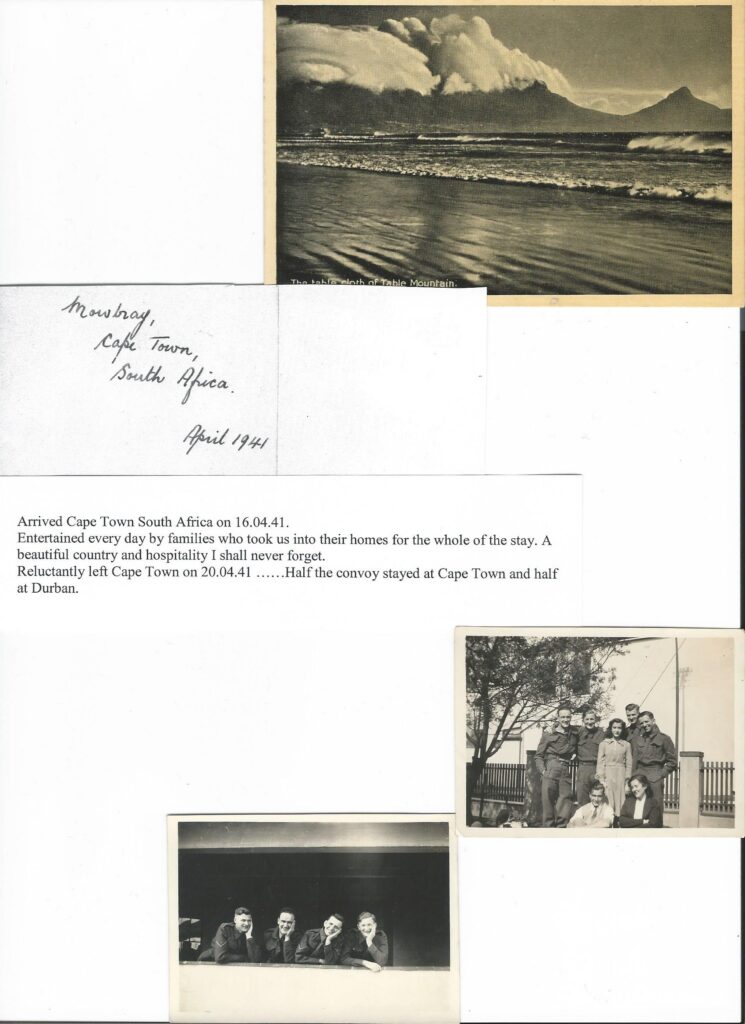
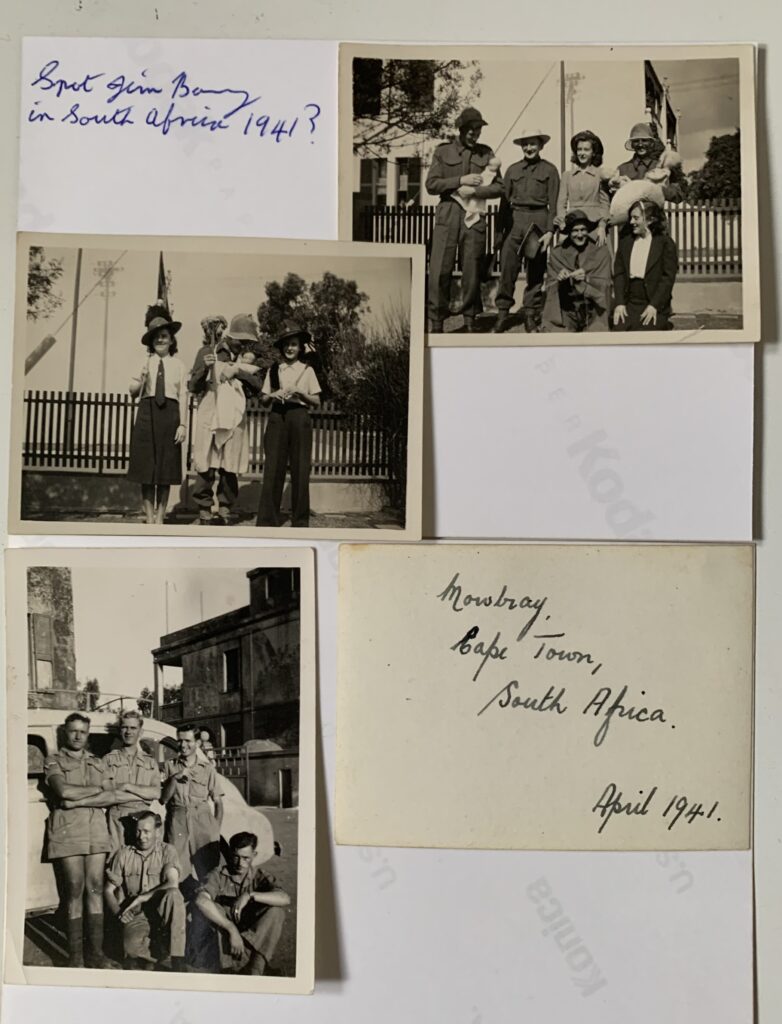
Page 2 of Dad’s hand written Travels and accompanying photographs is below.
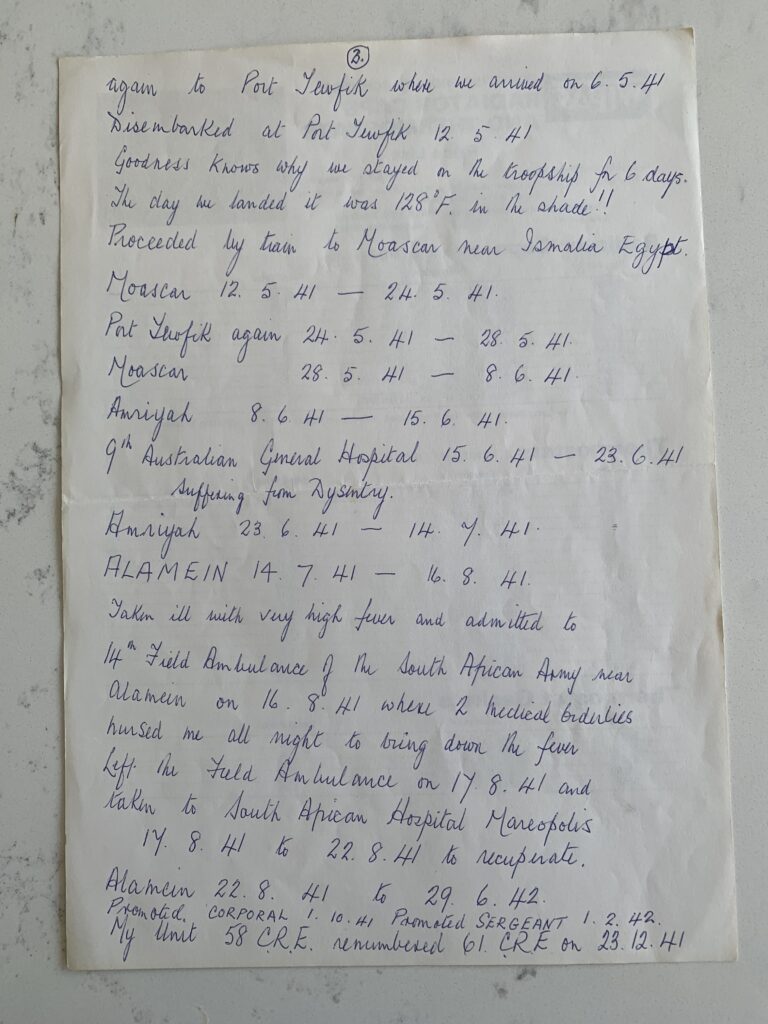

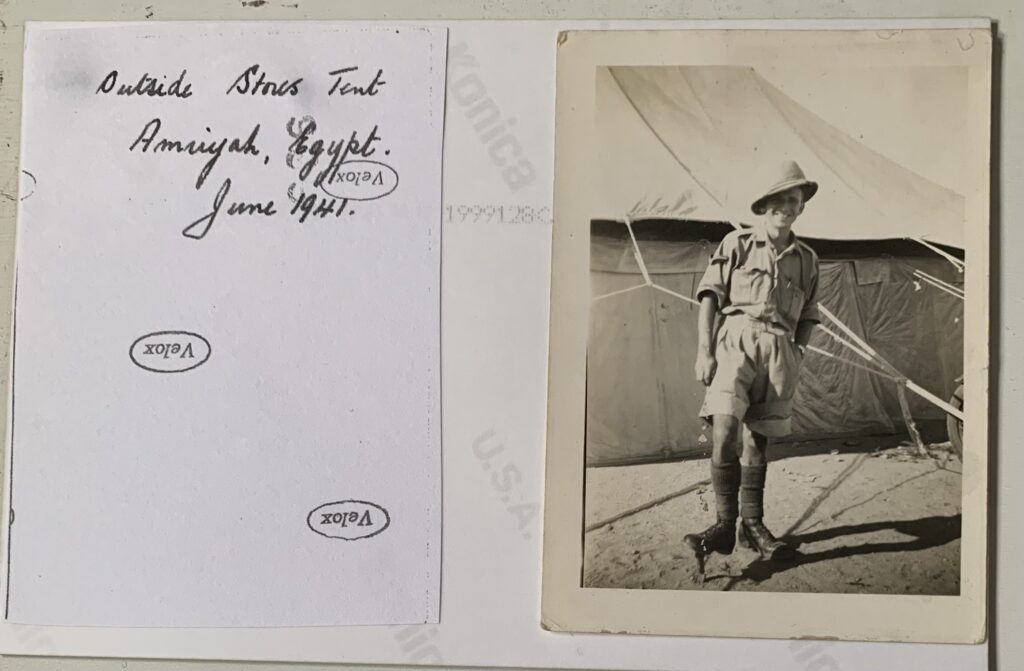
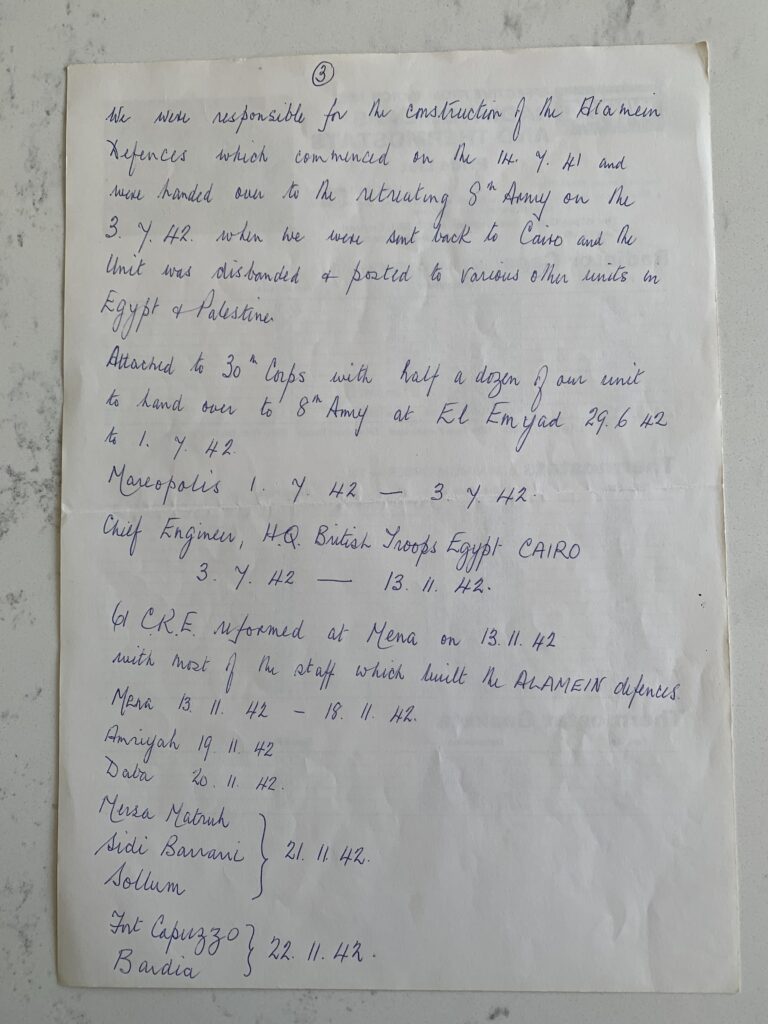
The photos below reflect Dad’s travels from page 3 above.
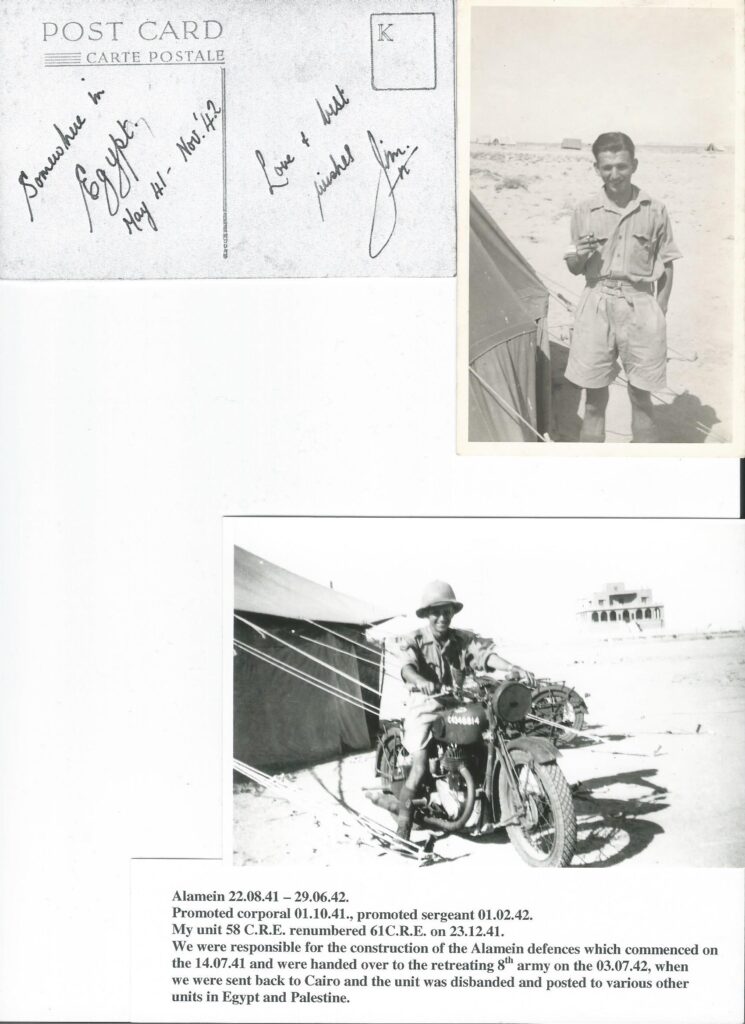
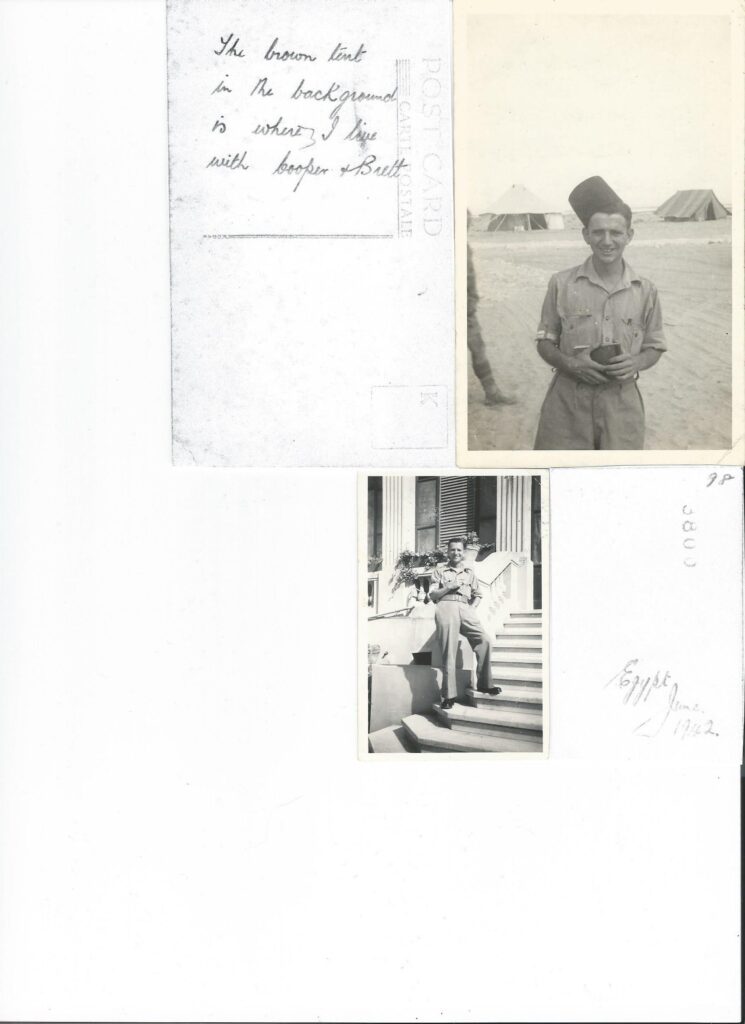
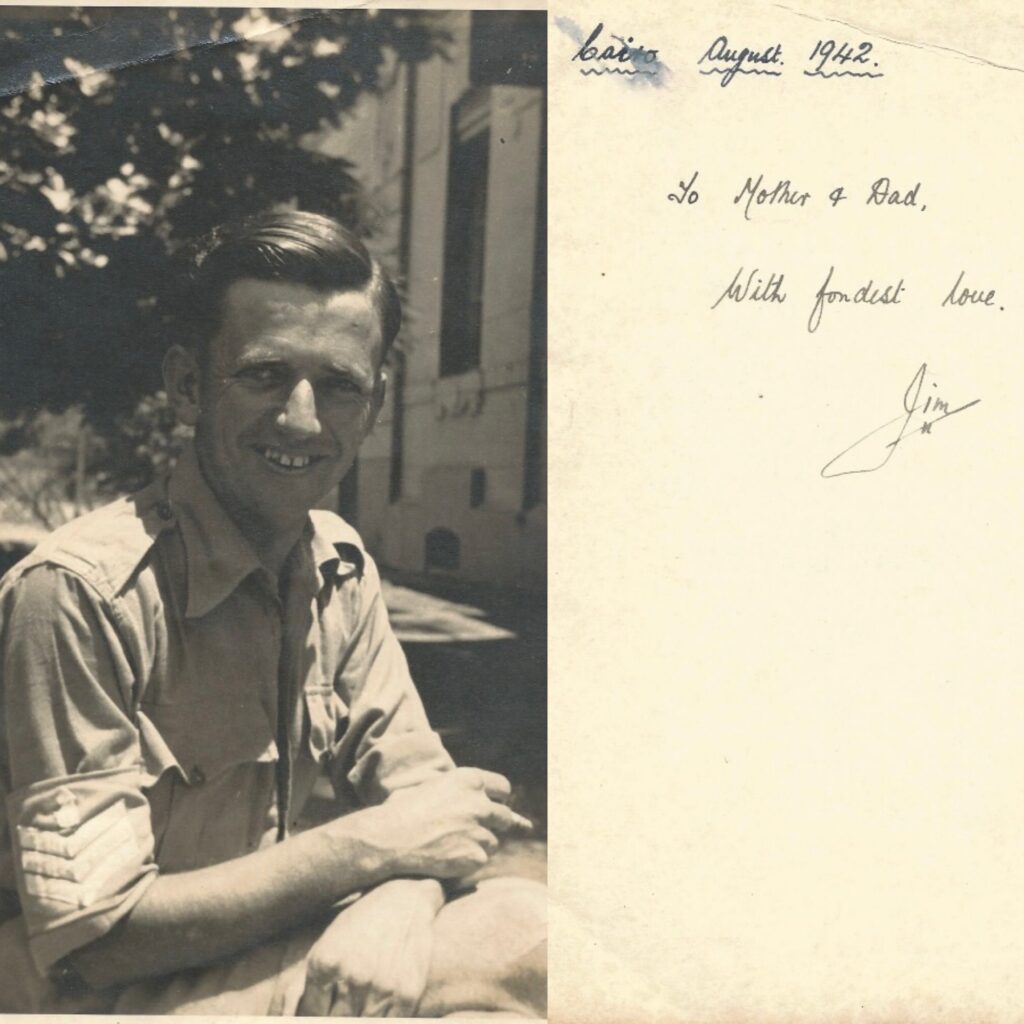
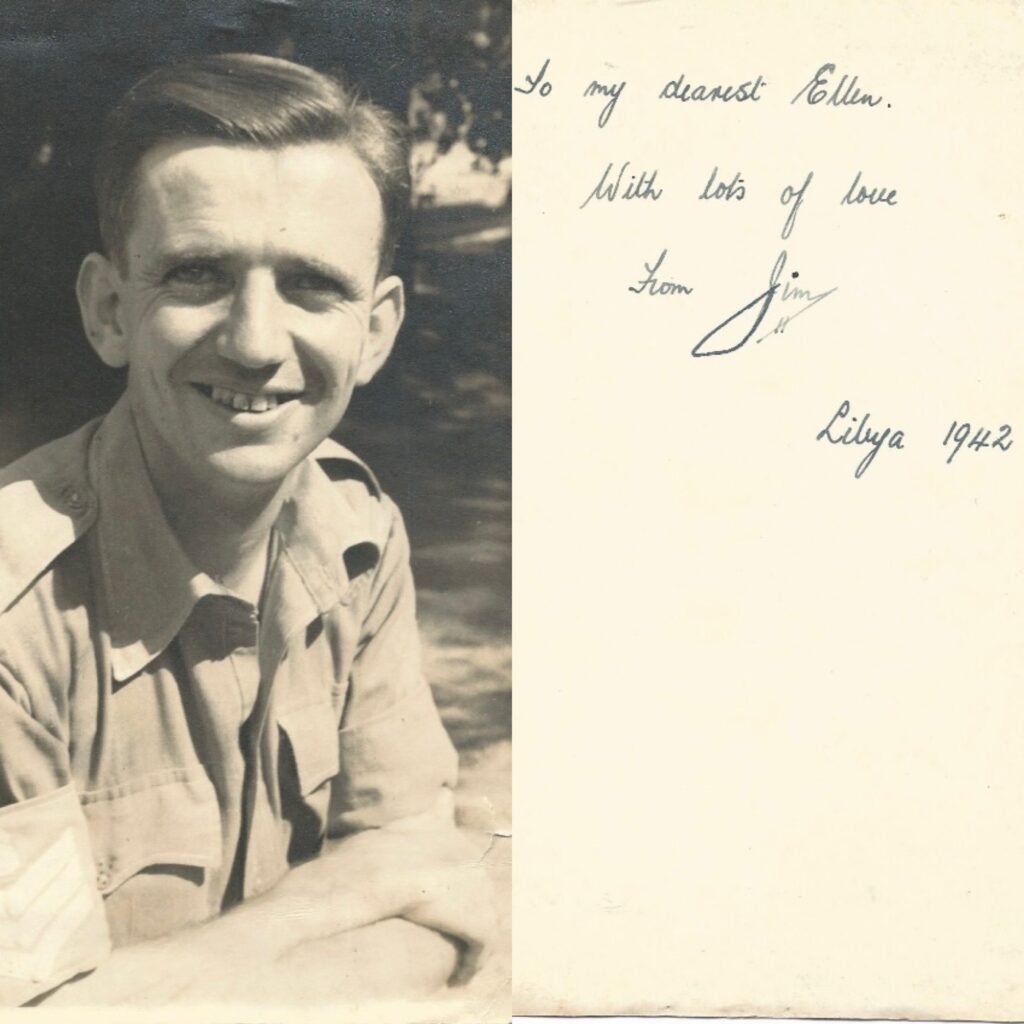
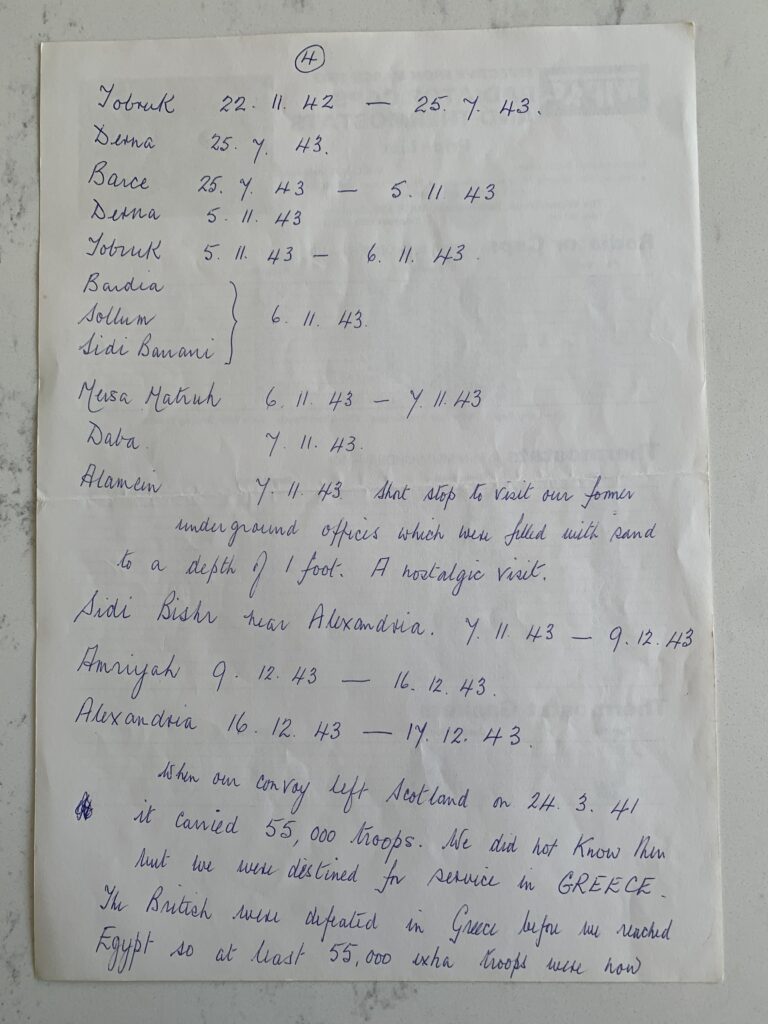
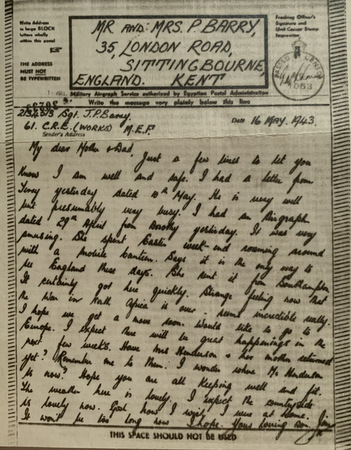
The letter above is probably the only surviving letter that Dad wrote during the War. There are a few Postcards that Dad wrote, but they are brief and lack the detailed content that the letter above has.
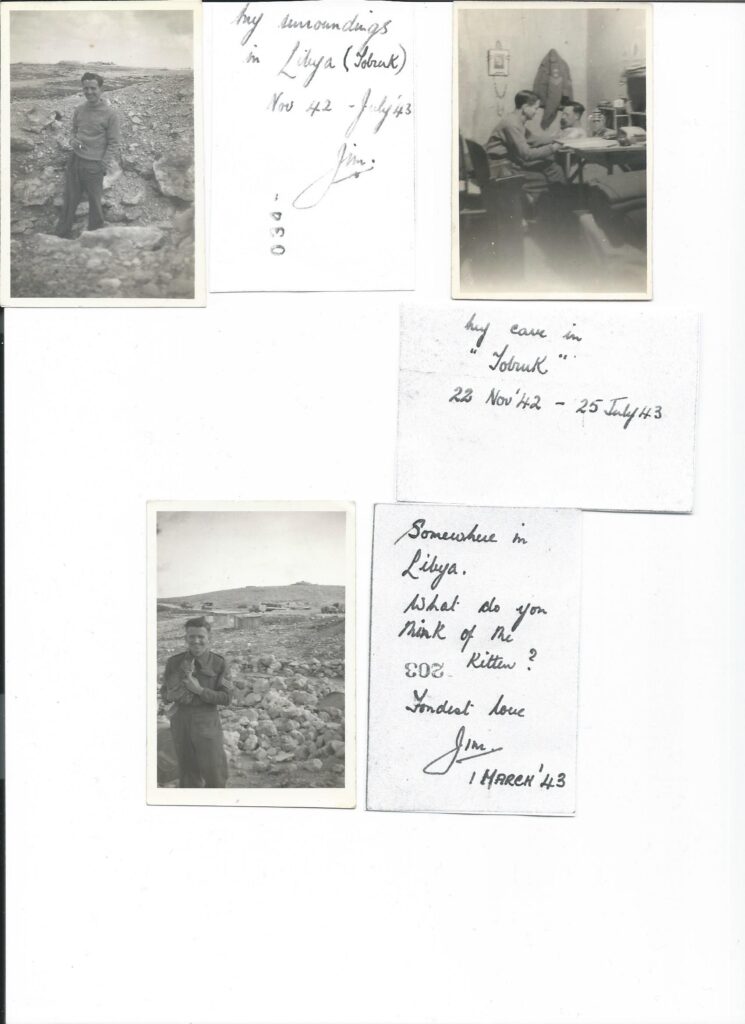
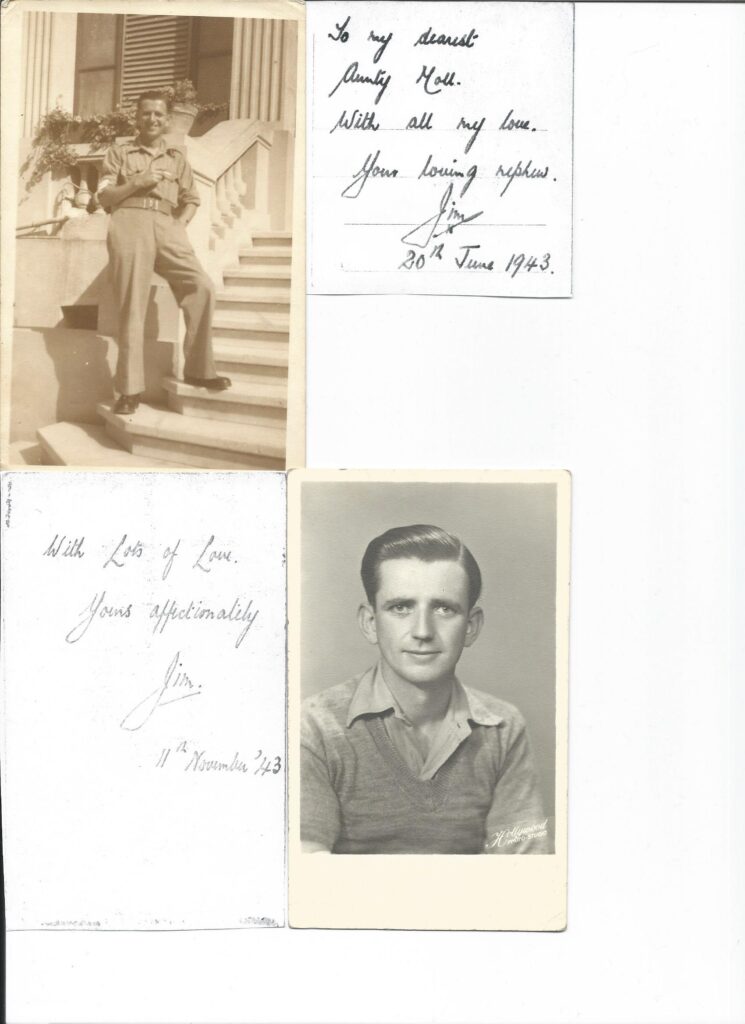

We are fairly certain that the above card was sent home to Mum as a Christmas card in November 1943.
Auntie Moll was Dad’s mother’s sister and lived her whole life at Harbour View Ireland. The other photo above I believe is from Dad to Mum. Again we believe that Dad met Mum before the war while playing tennis, and they wrote to each other while Dad was away with the Royal Engineers during the war. At this time Mum was working in the Dockyard preparing wages, as the War continued it became ever more dangerous working in the Dockyard as it had become a target for German Bombers. Mum & her colleagues were then moved to the safer town of Maidstone for the duration of the War.

Above is a photo that Mum sent to Dad while he was in North Africa in 1943.
Dad makes no reference in his “Travels” about the death of his little brother Terry. Maybe it was to painful for him to record the facts. Dad would have known that he was following his brother to Italy, and probably thinking about visiting Terry’s Grave at Monte Cassino.
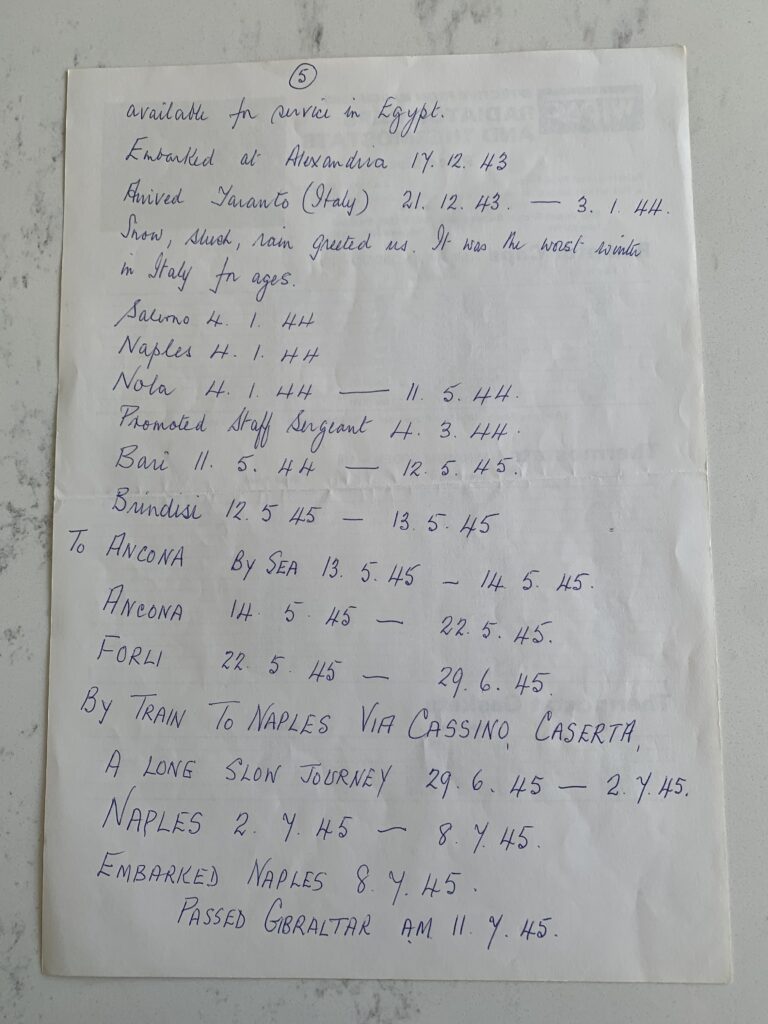
–
It appears that either Dad did not keep or take as many photos in Italy as he did in North Africa or maybe the Italian photos did not survive as well ? To put things in perspective, Dad spent about 30 months in North Africa and left us at least 50 photos and at least 6 Postcards. He then spent about 18 months in Italy and appears to have left us about 6 photos & 6 Postcards. Maybe other family members possess some of his Italian Photos?
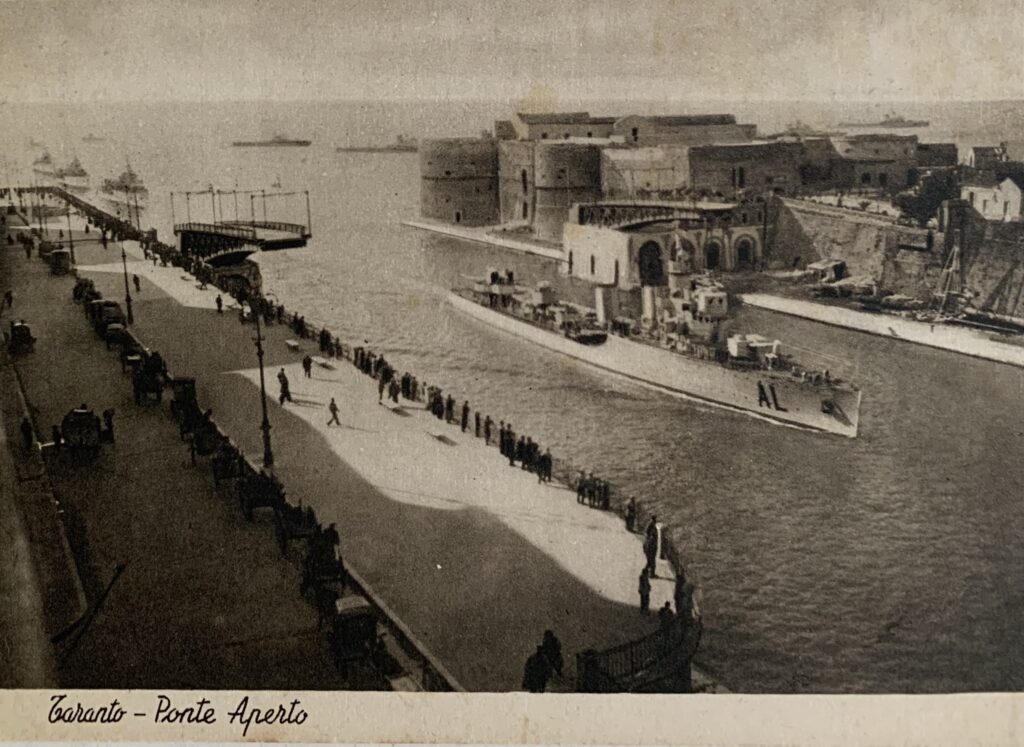
Looks like Dad acquired a Postcard featuring the port of Taranto, the first Italian port he arrived at during WW2.
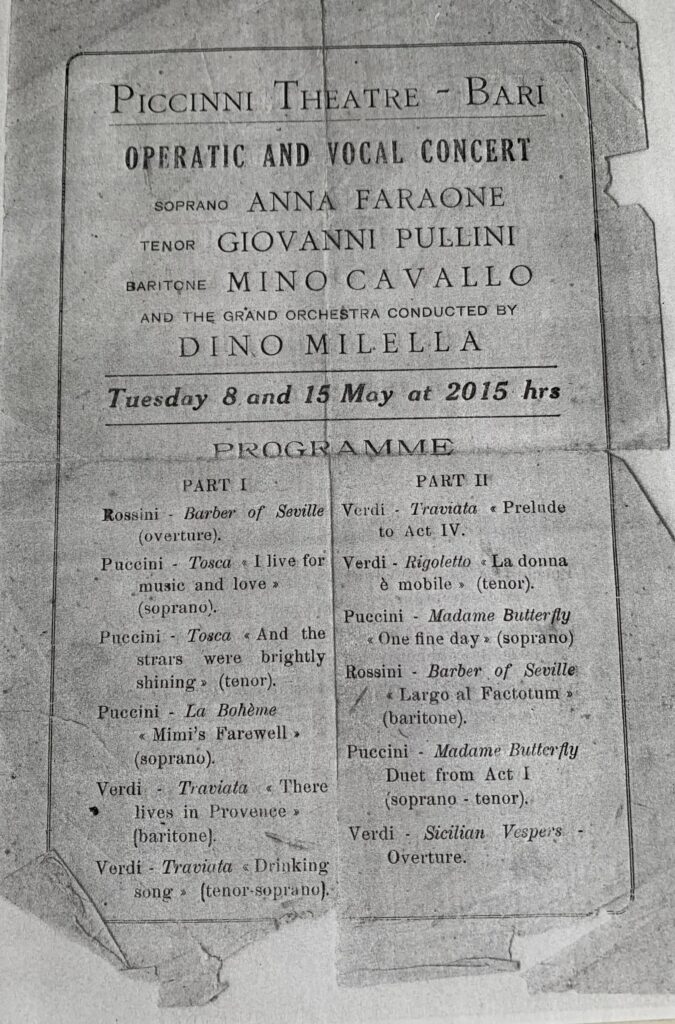
From Dad’s account of his travels, he apparently spent a year in Bari, 11.5.44 to 12.5.45. Not sure what he was doing for those 12 months in Bari, but it looks like he had time to go to the Opera, as he saved the above Programme!
Dad inscribed the back of the photo below, Sep 1944, presumably he had this portrait done during his year in Bari 1944 to 1945.

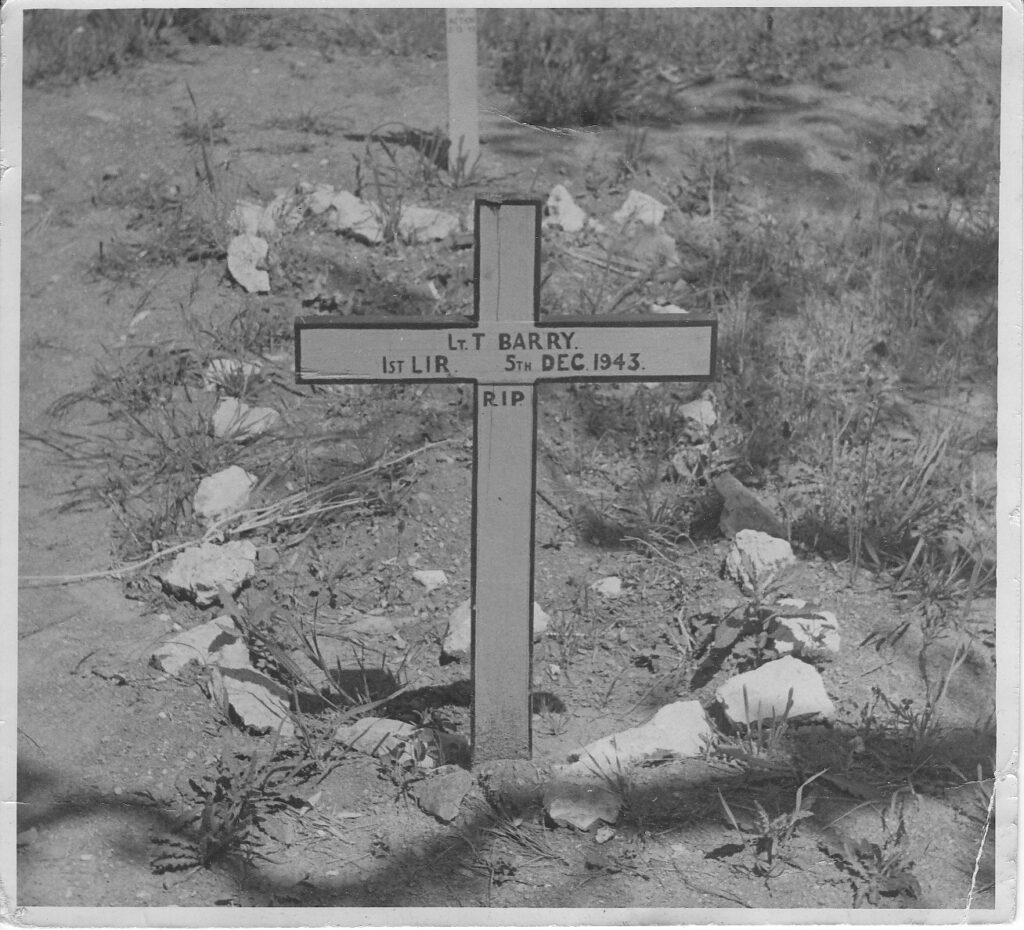
Dad’s train journey to Naples, June/July 1945 was via Cassino, we believe that he managed to visit Terry’s grave and take this photograph. He embarked from Naples 8.7.45 to return to England after 4 years & 111 days abroad.
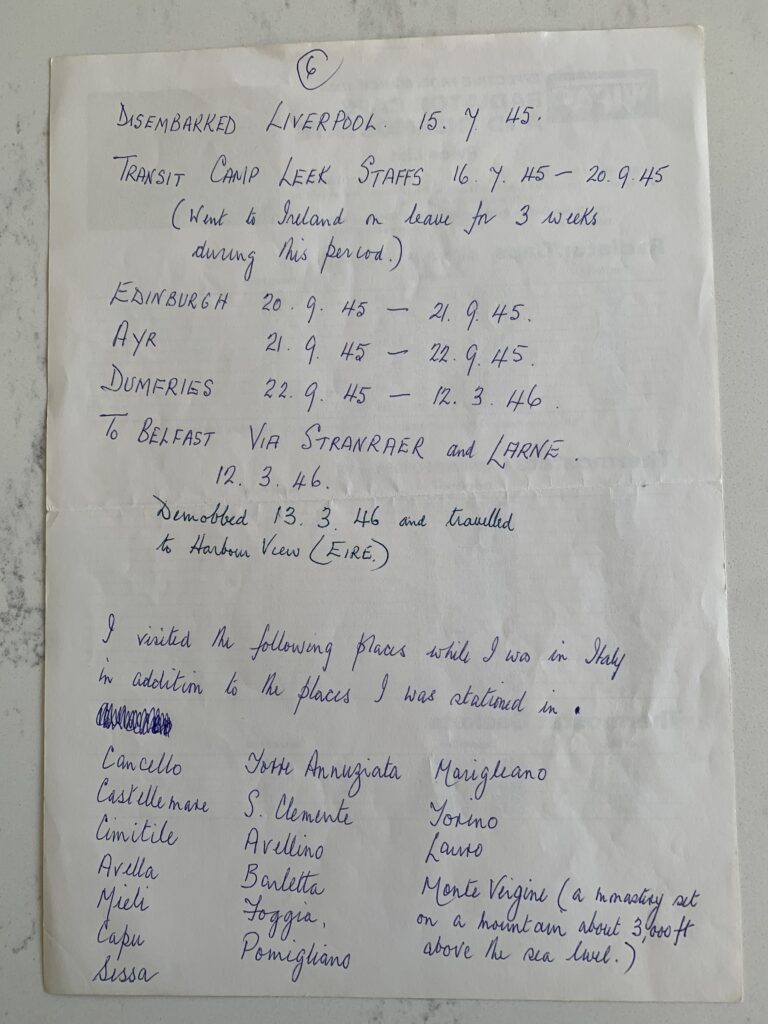

I do not completely understand the above Postcard, except that Dad mentions Marriage now & Mum’s maiden name is on the Postcard. Written presumably while Dad was in the Transit Camp in Leek Staffordshire 1945, I don’t even know if they were engaged at this time? The photos below show that Dad visited Mum on his return to England after the war, the photo on the left clearly shows his Staff Sergeant Rank, photo on the left shows Dad in the back garden of 181 Ufton Lane by the Air Raid shelter which I vaguely remember.
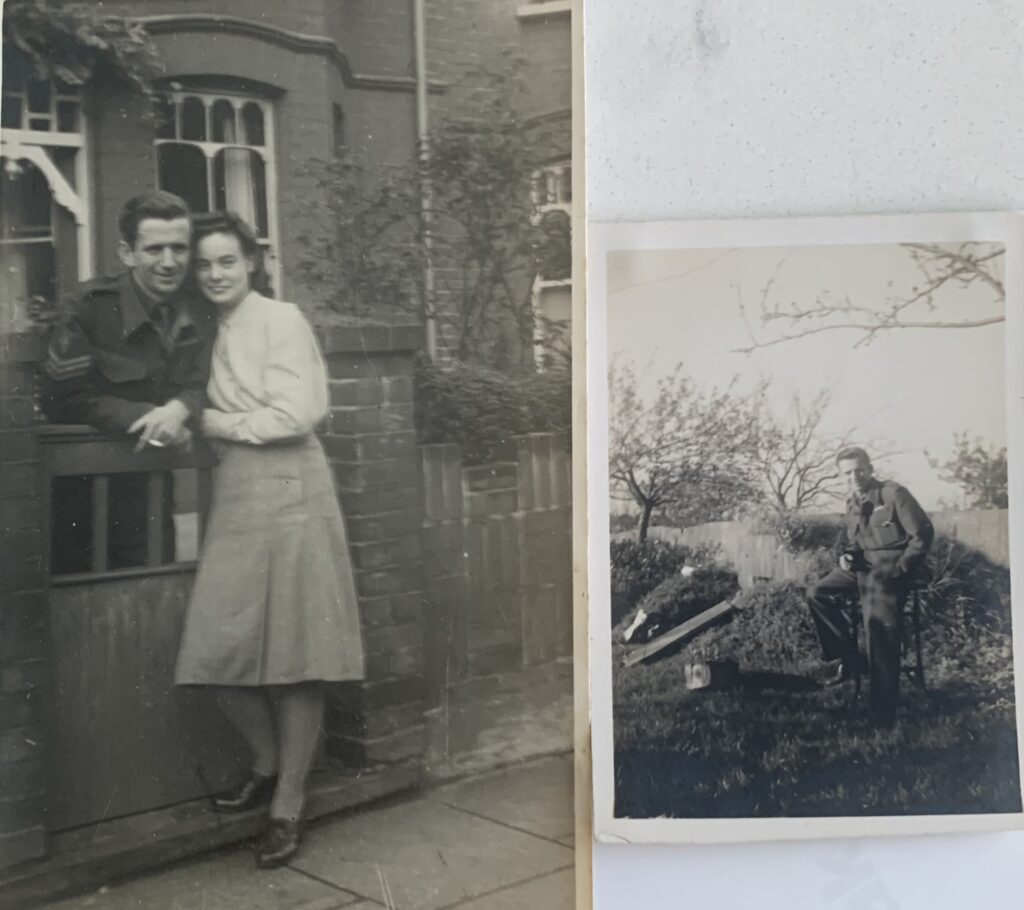
Dad does mention that he “(Went to Ireland on leave for 3 weeks during this period)” this was while he was at the Transit Camp in Leek in 1945. As of 2024 I have been unable to find any record of Dad’s trip to Ireland apart from his mention of it in his “Travels”.

From Leek, Dad was posted to Scotland for 6 months, the above card to Mum has survived. In early 1946 Dad travelled to Belfast for his De – Mobilisation from the Army, why he had to travel there, I do not know, but I don’t suppose Dad minded travelling to Ireland again. From Belfast he travelled to Harbour View, Eire, probably for another holiday!
Dad’s De – Mobilisation/Release papers are below. Showing that he was De-Mobbed in Belfast and then travelled to Eire and Harbour View.
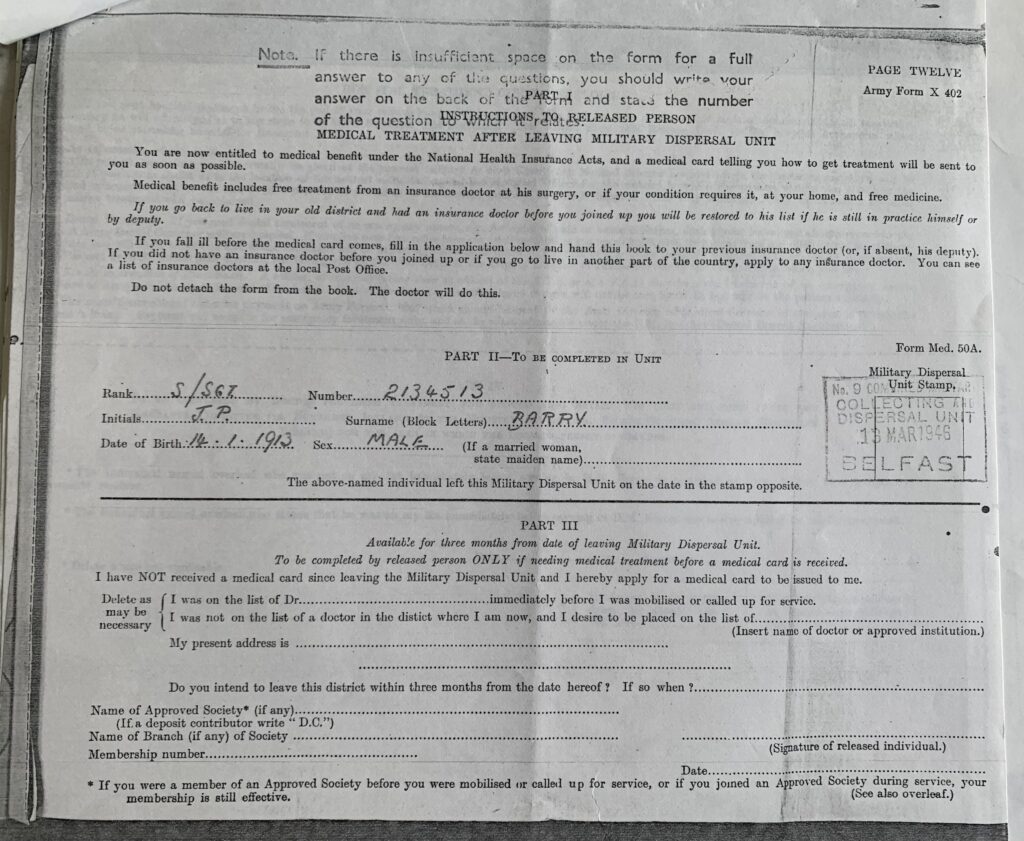
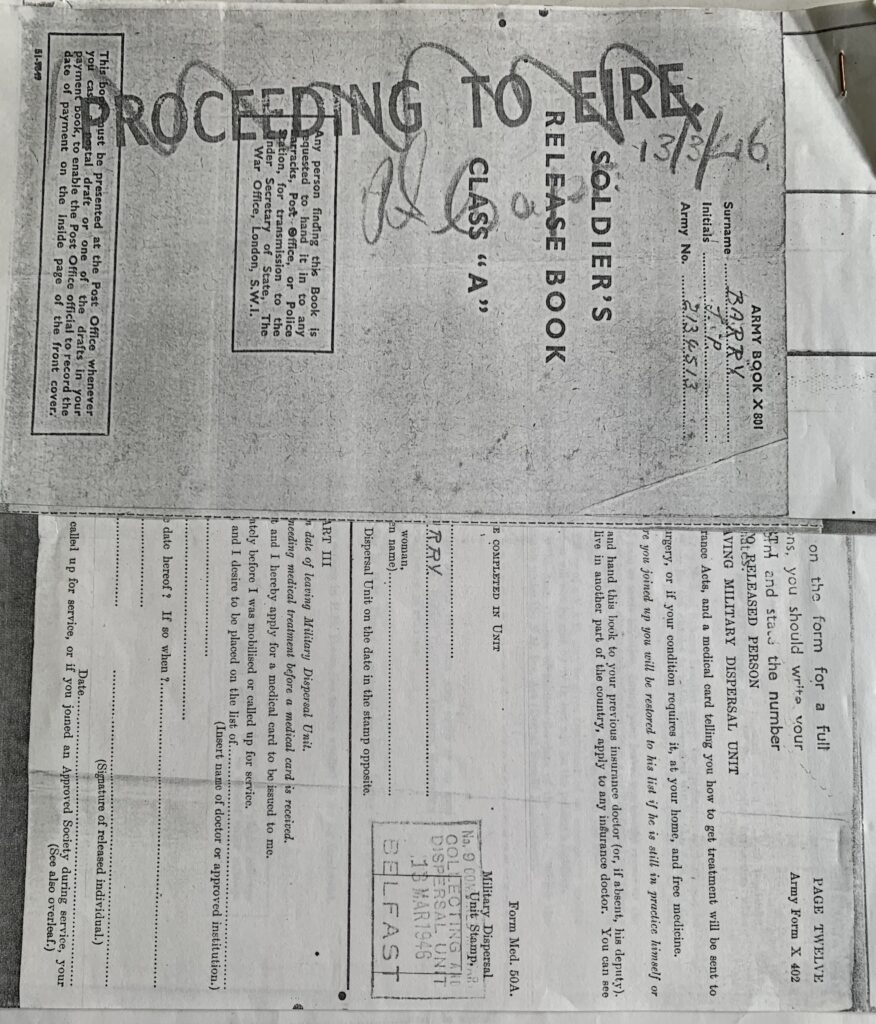

Dads Letter & Certificate of Commendation from Scottish Command for his time spent in Scotland in 1946 is copied below.

The final page of Dad’s, “Travels of J.P.Barry” appears below, his record is not entirely chronological, he mentions his week’s leave in Rome on this last page which I presume was in February 1945, according to the inscription on the photo that survives. There are other places and dates, that precede chronologically this sheet, but Dad mentions them on this final sheet, which is why they feature below.

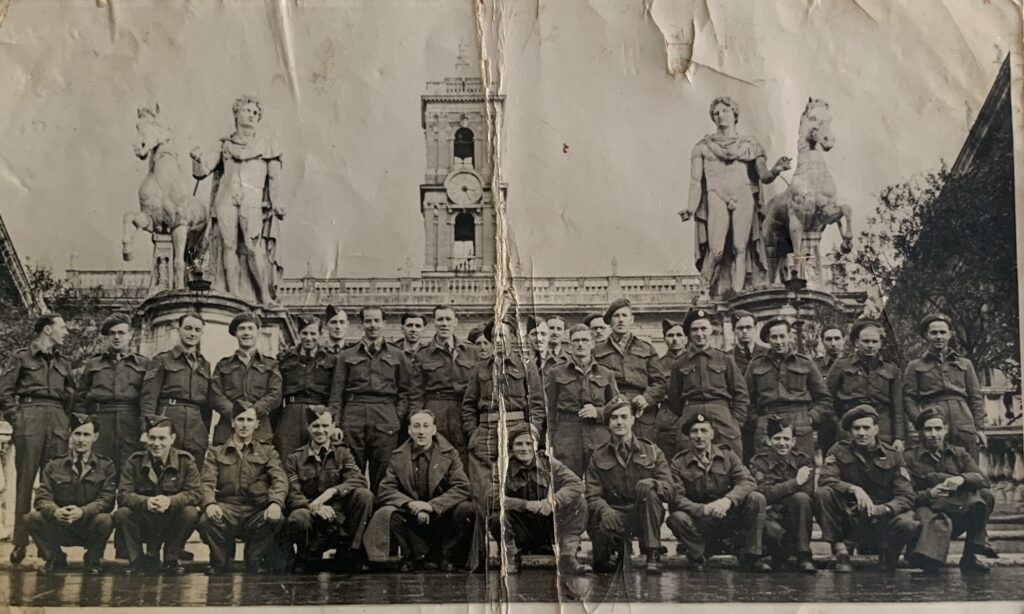
The inscription on the back of this photo reads, “Rome Feb 45”. Dad is front row, 3rd from right. I have managed to identify this place in Rome, it is one of the oldest landmarks in the city of Rome, and is known as the Town Hall of Rome with Clock Tower.

The photo above, also taken while Dad was on leave in Rome, February 1945, was taken with the Fountain of the Naiads in the background. Currently I only have these 2 photos featured above, of Dad in Rome.
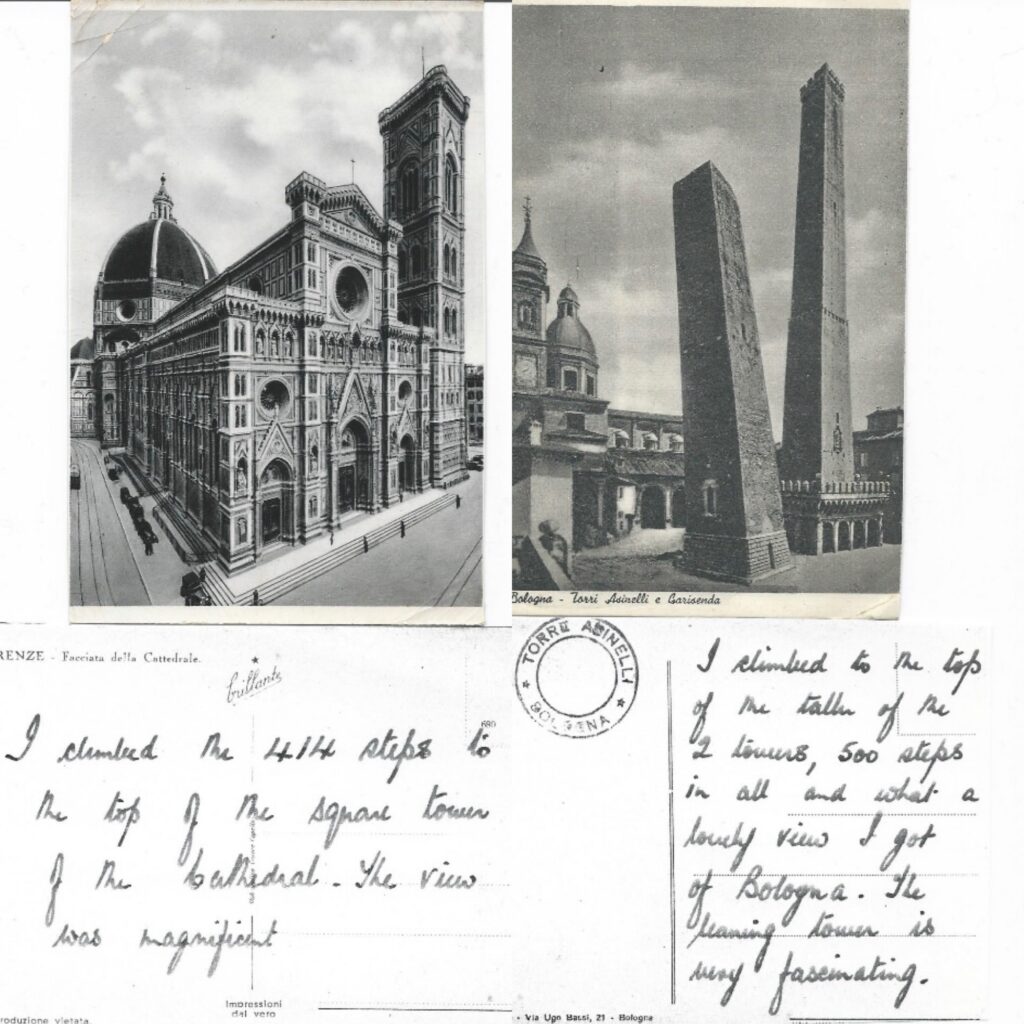
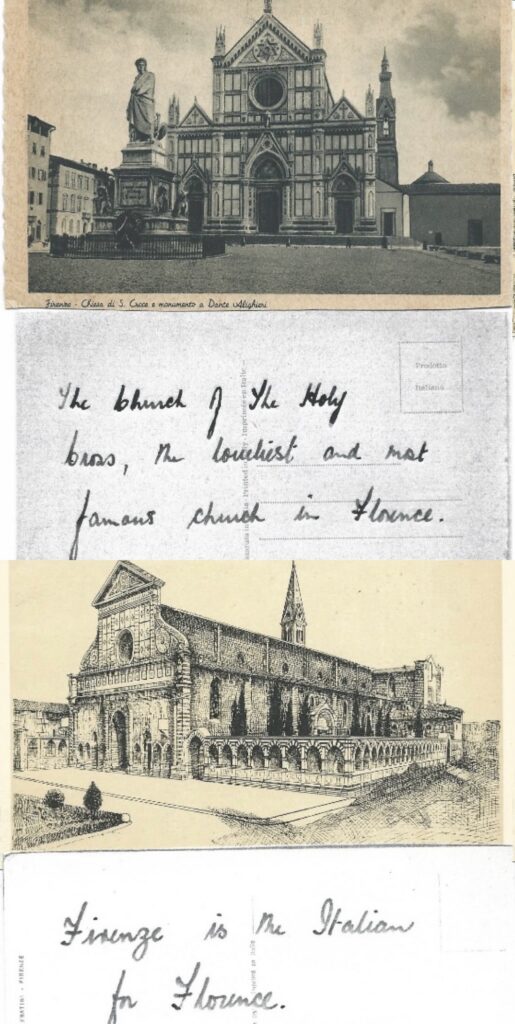
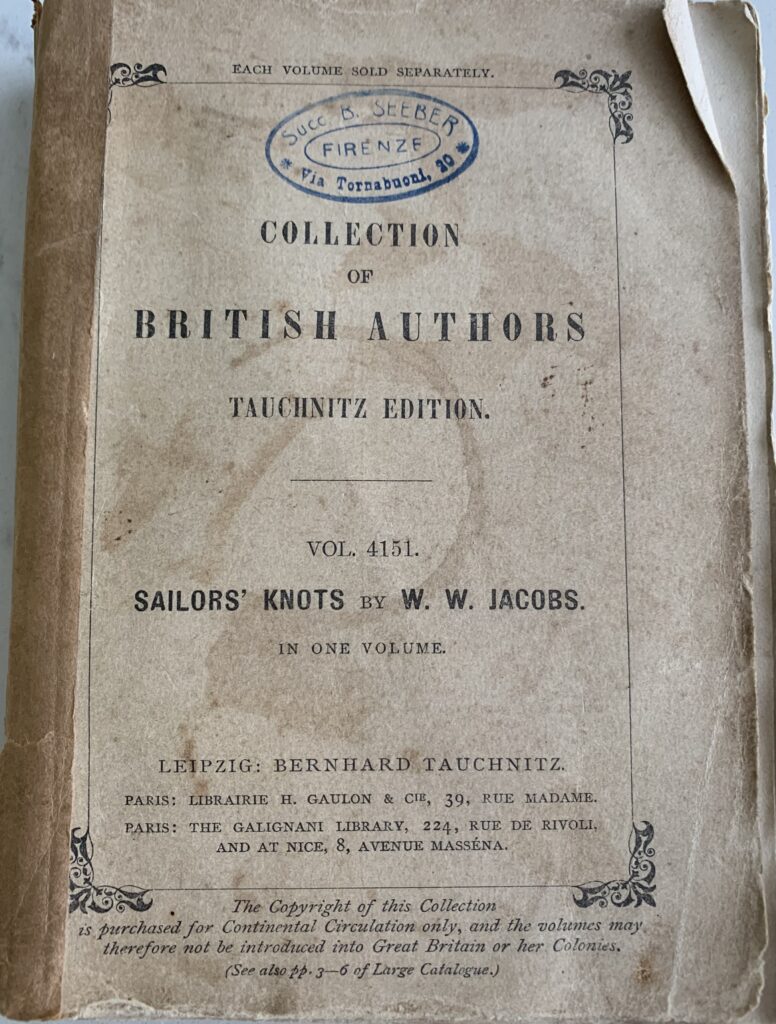
Dad spent some time in Bologna & Florence & inscribed the Postcards featured above, Dad also bought the Book, Sailors Knots by W.W. Jacobs in Florence & brought it back home with him !

Dad was to travel through Caserta Station again in June 1945, this photo above, although posed shows life as a soldier.


Dad possessed a very tatty copy of the above booklet of Cartoons, I presume he bought it and travelled with it during the war and eventually brought it back home. I purchased this 1960’s reprint some years ago as I to enjoyed Dad’s copy. Not sure what happened to Dad’s original copy?
The Postcard below dated 22 Aug 1946 has been in my possession for a few years and gives brief details of another trip he made to Ireland.
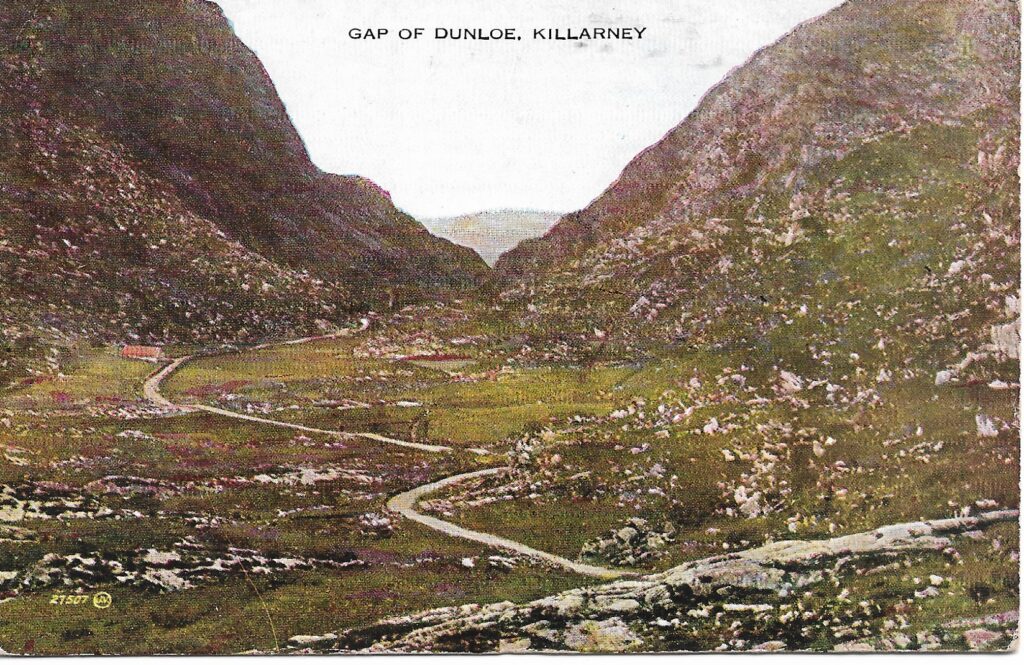
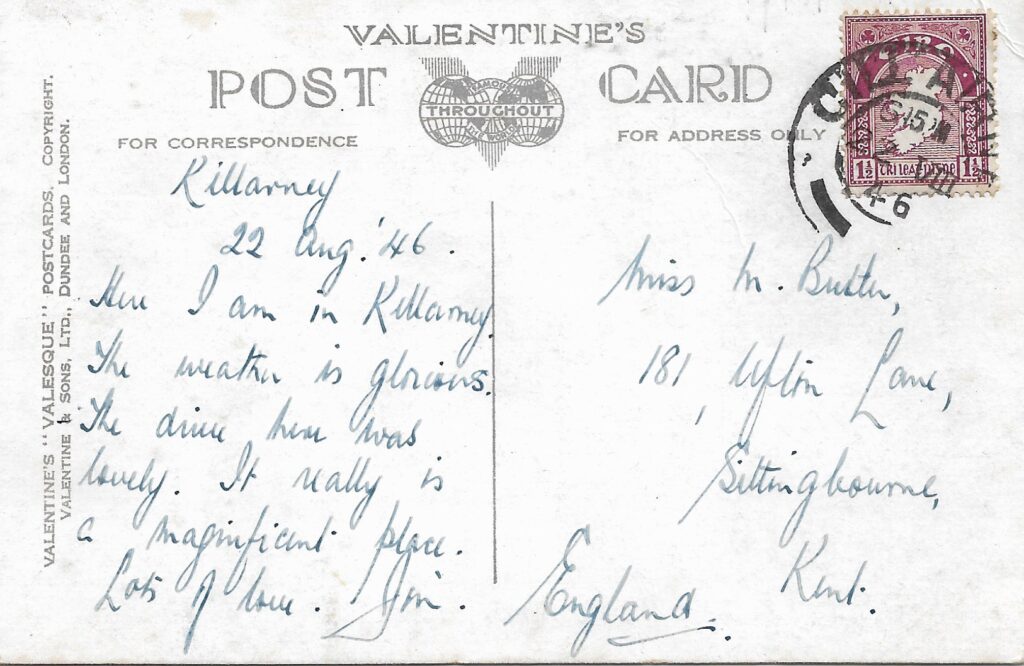
What we did not know, was that there was some Photographs taken of Dad during this trip to Ireland! They only came to light through one of our Irish cousins in 2020. The first Photo below has the same date as the Postcard above, and reveals that Dad was on holiday with his younger sister Ellen. Her cousin Paddy Ahern is seated in front of her. I have know idea as to the identity of the Priest in this Photo.
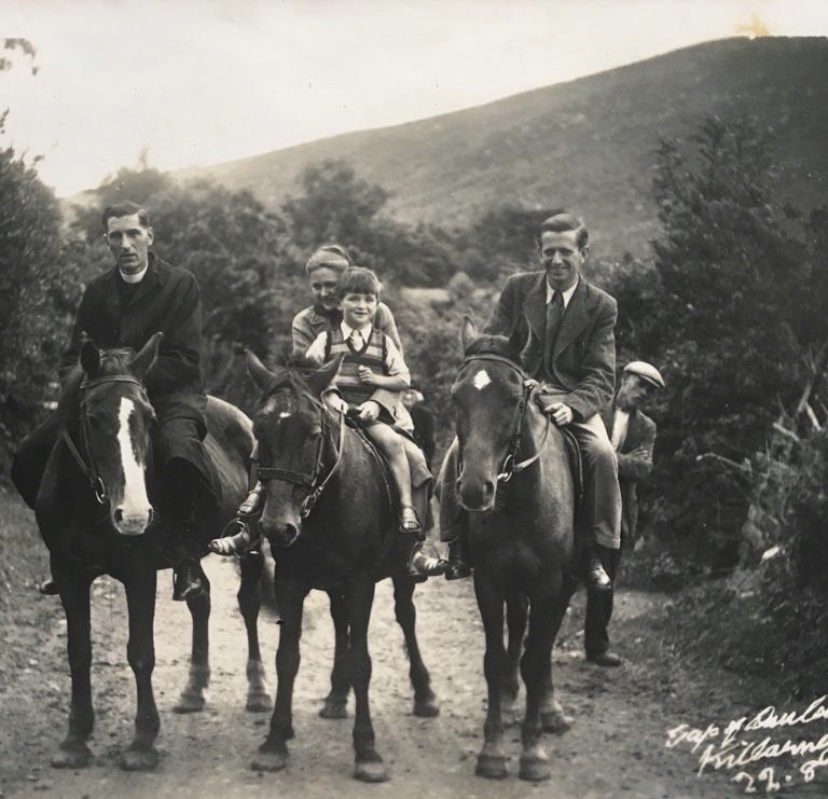
Another Photo that came to light at the same time in Ireland in 2020 as the one above and is featured below. It shows Dad in Camus with 4 of his young cousins.
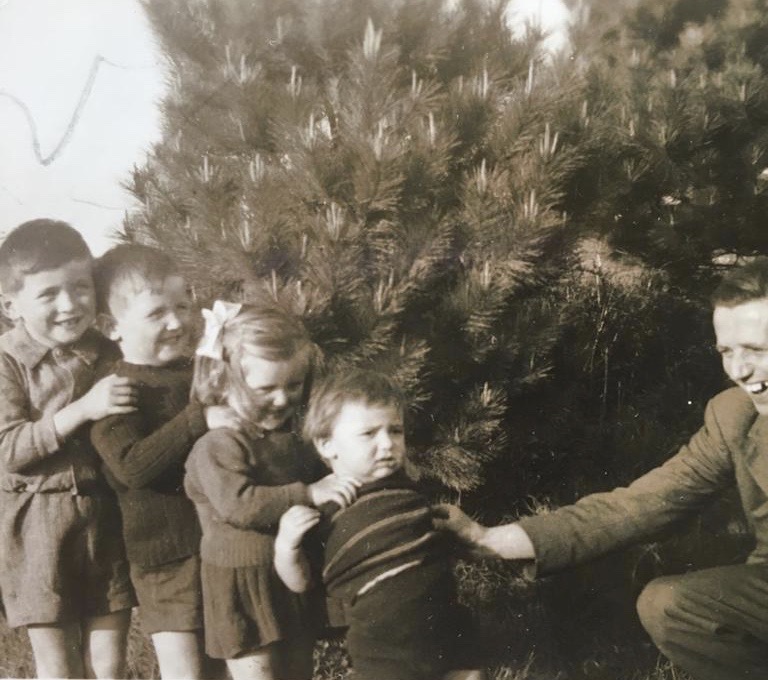
In less than 7 months after this holiday in Ireland, Dad married the love of his life, Muriel Dorothy Butler. They were married in the Sacred Heart Catholic Church in Sittingbourne on the 17th March 1947, St Patrick’s Day. They then spent several days in Bournemouth on their Honeymoon.
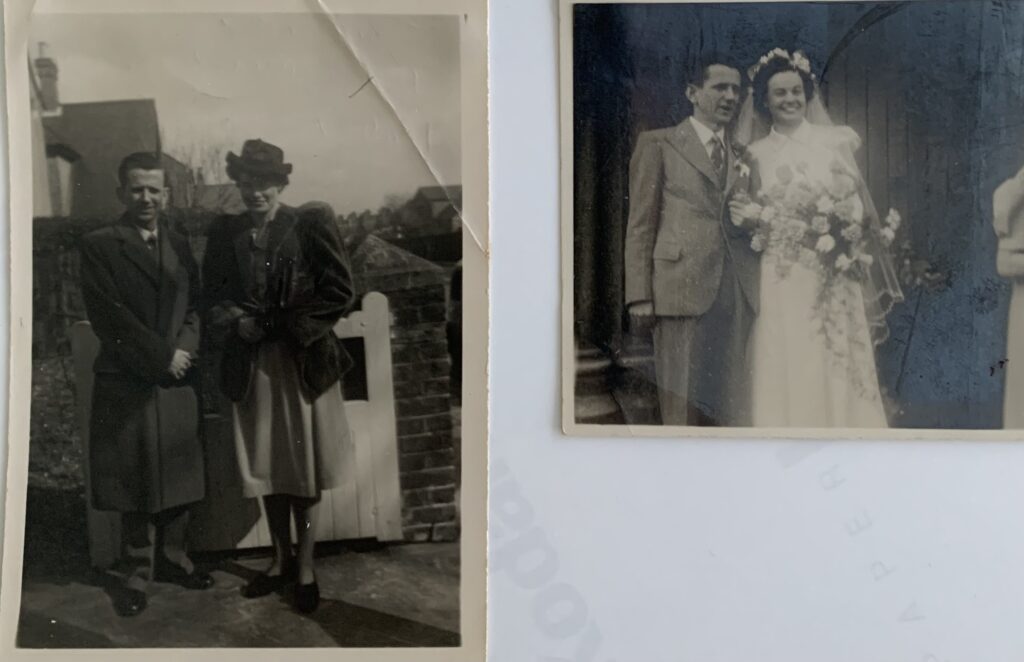
Eight days after they were married, Dad had to leave for his posting to the Naval Dockyard in Gibraltar, he traveled by ship, the Empress of Australia embarking from the Port of Liverpool. Mum was to follow him on 2.5.47 embarking from RAF Northolt by air!
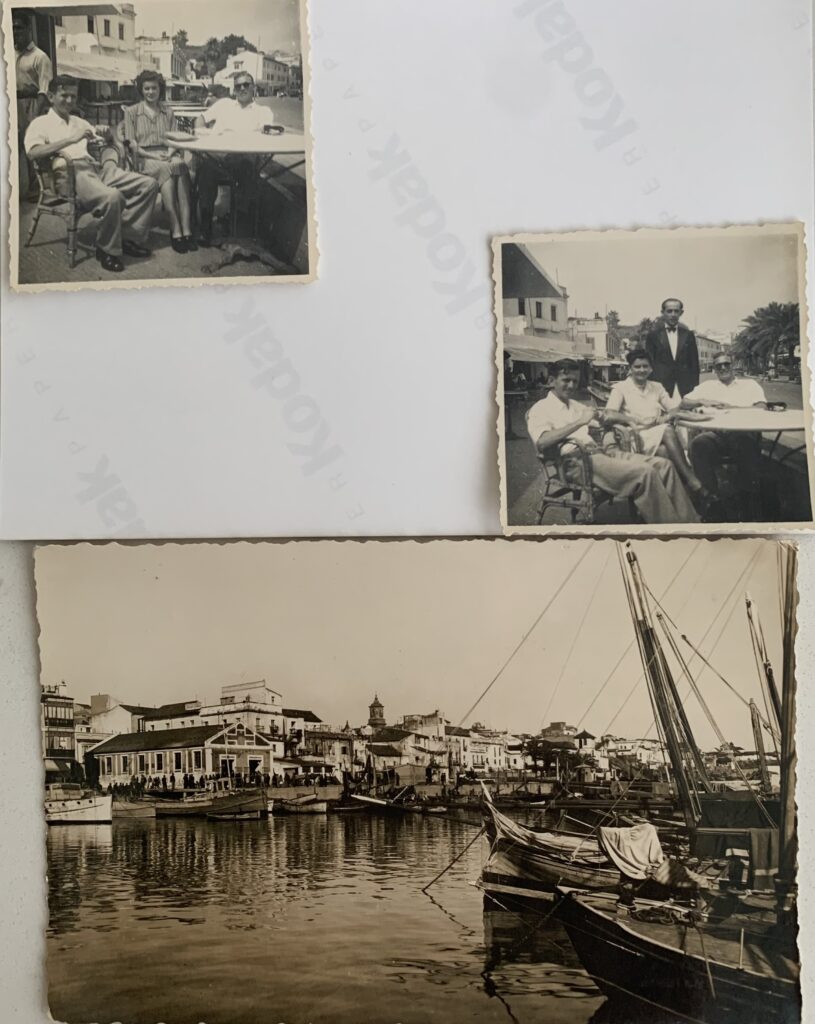
Mum & Dad spent several years in Gibraltar, and from the photographs & postcards they kept it appears that they lived life to the full! They very often crossed the border into Spain and Bull fights were a favourite attraction. Morrocco in North Africa was another popular destination for them, indeed when Mum’s parents, our Grandparents, Eva & Edgar Butler flew to Gibraltar to visit them, they also accompanied them to North Africa for a holiday within a holiday!
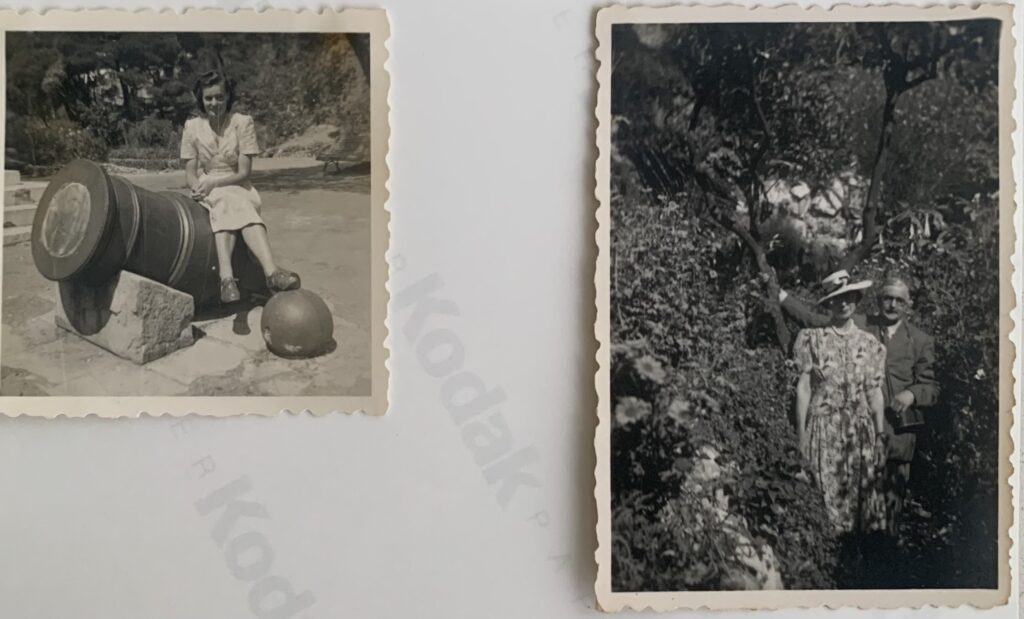
Mum sitting on a Mortar in Gibraltar. Our Grandparents Edgar & Eva Butler in Gibraltar 1949.

I believe Mum & Dad were a fan of the Matador featured above as they managed to get his Autograph. His claim to fame was that he was one of a very small & select band of British Bull Fighters.
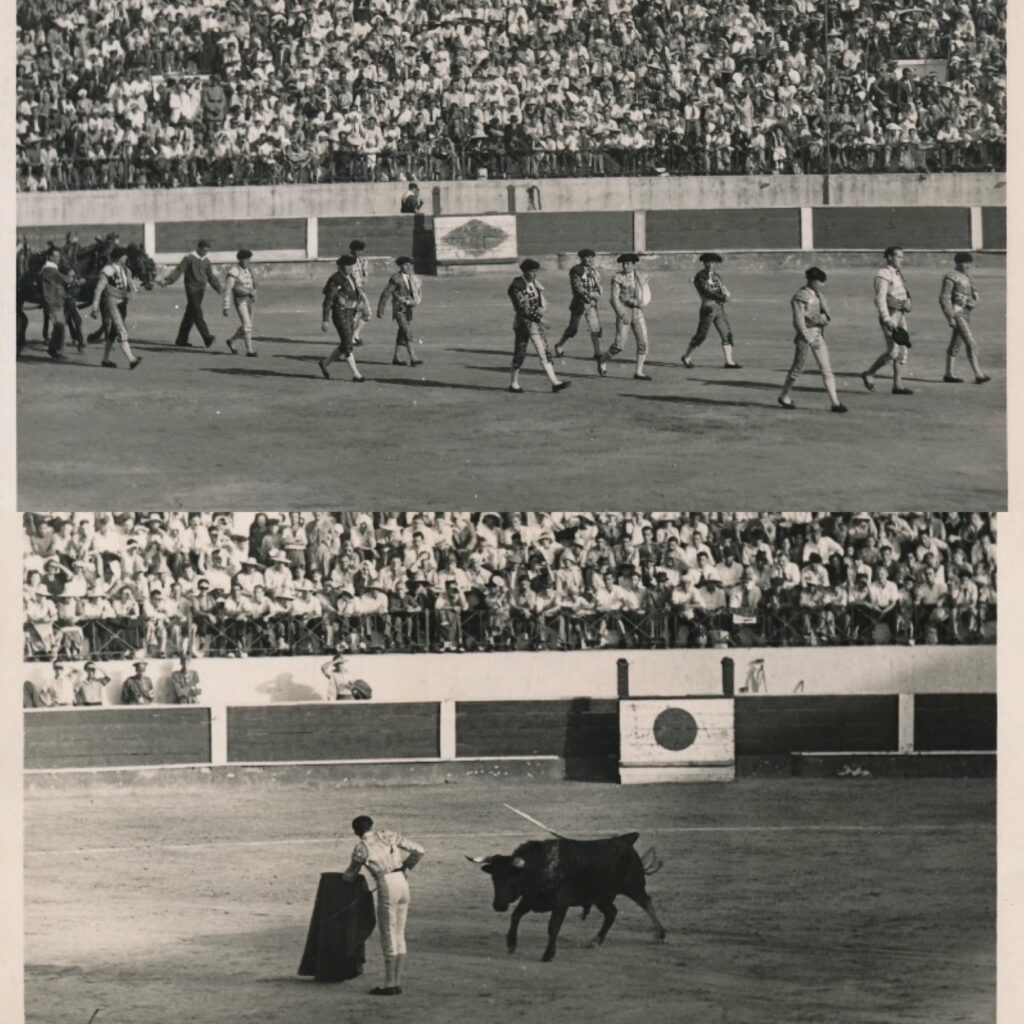
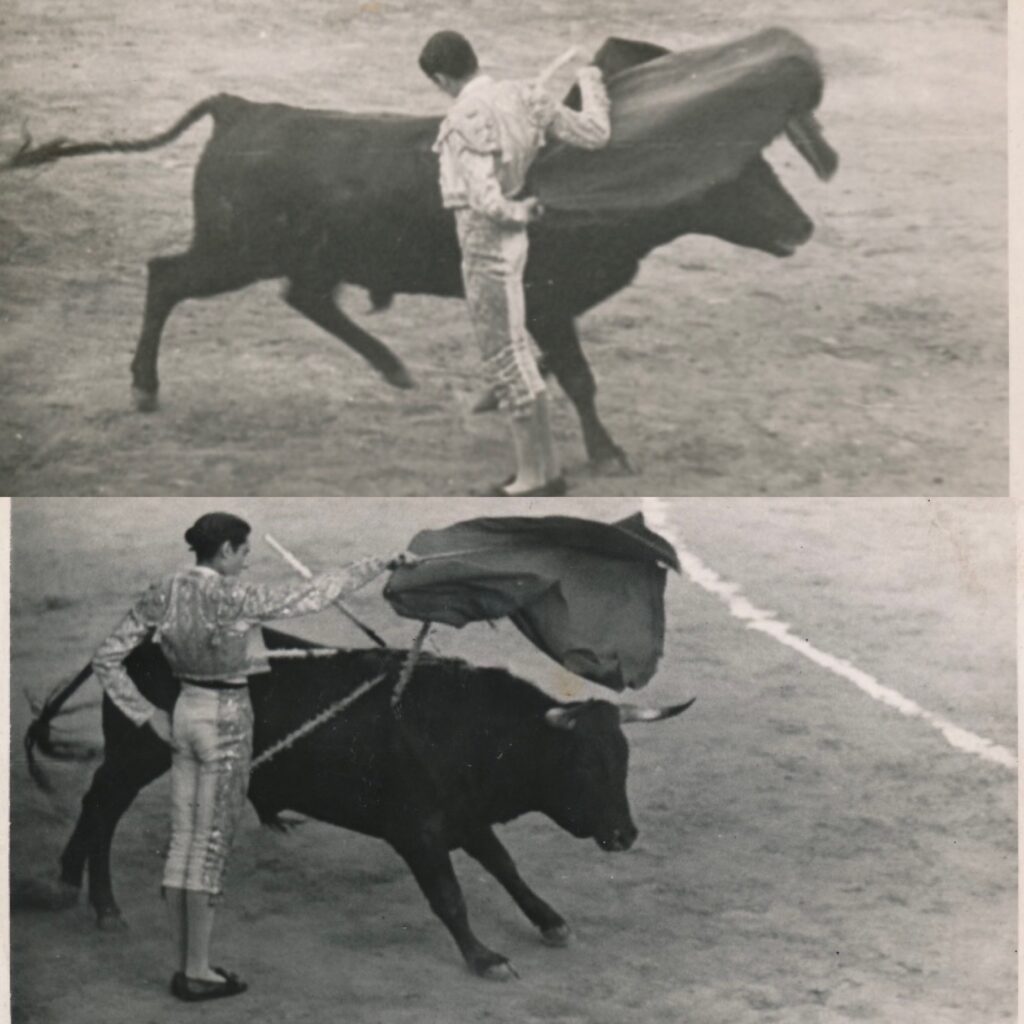
The Postcards above are a very small select few of the many that Mum & Dad collected and kept. Dad also kept a macabre record of some of the Bullfights that they attended, a copy of his record is shown below!

The Barrys returned to England from Gibraltar on the 29th December 1949, they either brought back or had shipped back many items of Bullfighting memorabilia, the famous Sword which has many family memories and tales, too numerous to mention here, but the one item that most of us remember was the painting that hung on the wall in 181 for many years.
